Shwedagon Pagoda in Yangon, Myanmar is one of Buddhism's most sacred sites, featuring 27 metric tons of gold leaf and thousands of diamonds. The pagoda is believed to enshrine eight hairs of the Gautama Buddha and has been rebuilt many times due to earthquakes, with the current structure dating back to the Bagan period (10th-14th centuries).
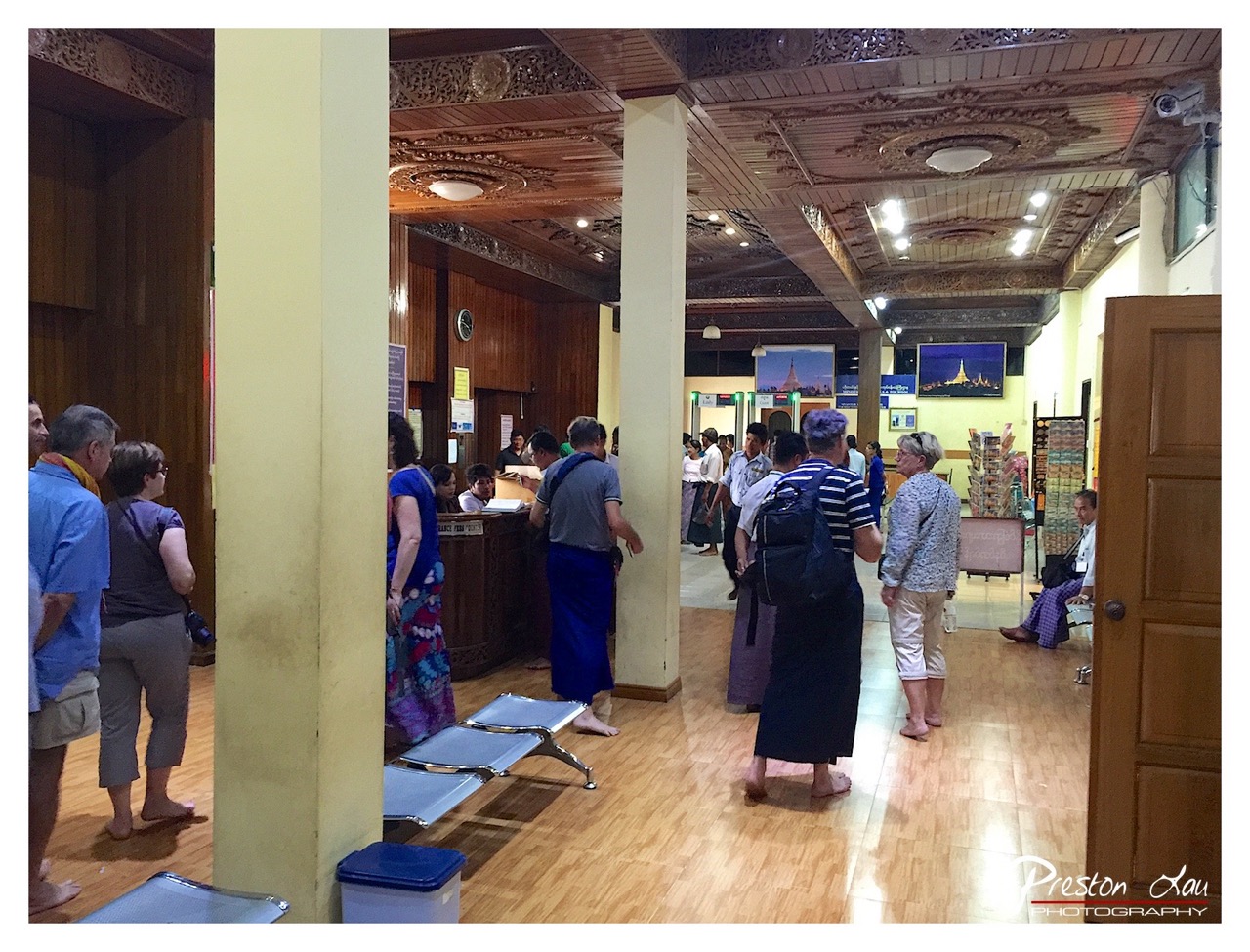

1. Overall Rating (0–10) — 6.8
This photograph captures the bustling atmosphere of a traditional Burmese temple ticketing hall, where cultural exchange unfolds in quiet harmony. The intricate wooden ceiling and warm wood tones lend an air of authenticity and reverence, while the mix of tourists and locals creates a dynamic sense of place. Though the composition feels slightly cluttered, the image succeeds in conveying the lived experience of pilgrimage and tourism, grounded in a rich architectural context.
2. Composition (0–10) — 6.0
The framing uses architectural elements like pillars to create depth, but the off-center subject placement and overlapping figures result in a somewhat disorganized flow. A tighter focus on a single interaction could enhance visual clarity.
3. Lighting (0–10) — 6.5
Artificial overhead lighting illuminates the space evenly, preserving detail without dramatic contrast. While functional, the light lacks warmth, slightly diminishing the ornate ceiling’s visual impact.
4. Color & Tone (0–10) — 6.5
The palette is dominated by warm wood tones and earthy neutrals, punctuated by pops of color from clothing. The overall tone is balanced, though not particularly vibrant—color harmony is present but muted.
5. Creativity (0–10) — 7.0
The photograph captures a candid moment of cultural convergence with authenticity. The inclusion of the ornate ceiling and signage adds narrative depth, suggesting a story beyond the transactional act of ticketing.
6. Technical Quality (0–10) — 7.5
The image is sharp and well-exposed, with clear details in both the foreground and background. The watermark is unobtrusive, and focus is consistent across the scene.
7. Emotional Impact (0–10) — 6.0
The scene evokes a sense of quiet anticipation and cultural respect, but the lack of a focal point or emotional peak keeps the viewer at a slight remove from the human experience.
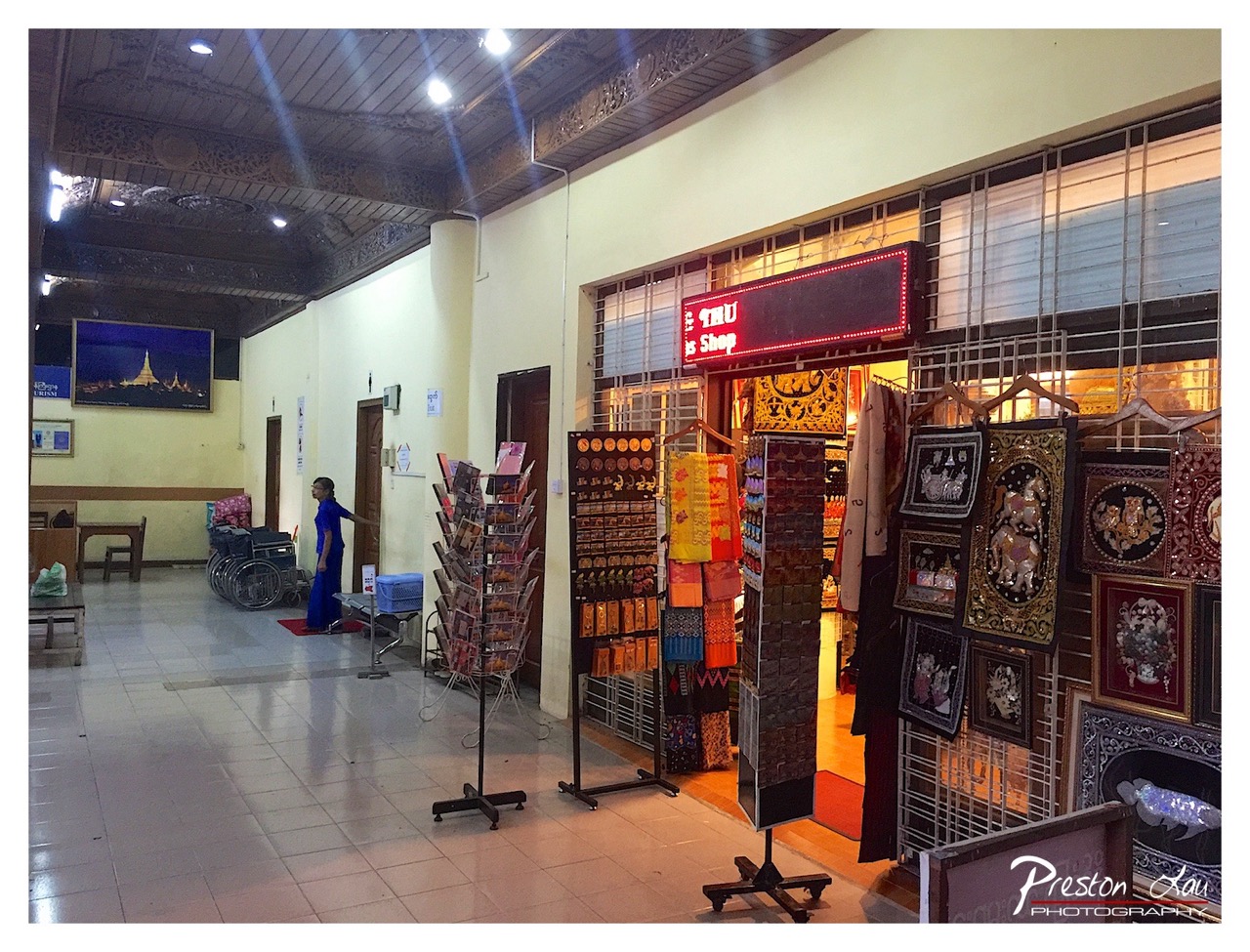

1. Overall Rating (0–10) — 6.0
This photograph captures a quiet moment in a cultural souvenir shop, where traditional crafts are displayed under fluorescent lights and beneath an ornate ceiling. The scene feels authentic and grounded in place, with the shop’s offerings offering a glimpse into local artistry, though the flat lighting and cluttered layout detract from its visual cohesion. While the image conveys atmosphere, it lacks the dynamic tension or emotional depth that would elevate it beyond a simple document.
2. Composition (0–10) — 5.5
The framing is wide, capturing both the shop and the adjacent hallway, but the composition feels unbalanced with too much negative space on the left and a cluttered foreground. The subject—a woman in blue—draws attention, but her placement is slightly off-center, and the merchandise display dominates the right, creating visual fragmentation.
3. Lighting (0–10) — 5.0
Harsh overhead lighting creates bright spots and lens flares, particularly on the ceiling, which disrupts the mood. The light is functional but unflattering, casting a sterile glow that washes out colors and minimizes depth.
4. Color & Tone (0–10) — 5.5
The palette is dominated by the warm yellows of the walls and the red of the LED sign, which contrast with the cool blue of the woman’s clothing. However, the colors appear muted and lack vibrancy, with the artificial lighting dulling the richness of the textiles and artwork.
5. Creativity (0–10) — 6.0
The image presents a slice of daily life with a clear cultural context, offering a narrative of place and tradition. While not particularly inventive in its approach, it succeeds in documenting a moment that feels real and unposed.
6. Technical Quality (0–10) — 7.0
The image is sharp and in focus, with clear details in the merchandise and signage. The lens flare, while distracting, is a result of technical exposure rather than poor camera quality.
7. Emotional Impact (0–10) — 5.0
The emotional resonance is subdued—there’s a sense of quiet solitude and stillness, but the viewer is kept at a distance by the impersonal lighting and cluttered setting. The image invites observation but does not evoke strong feeling.
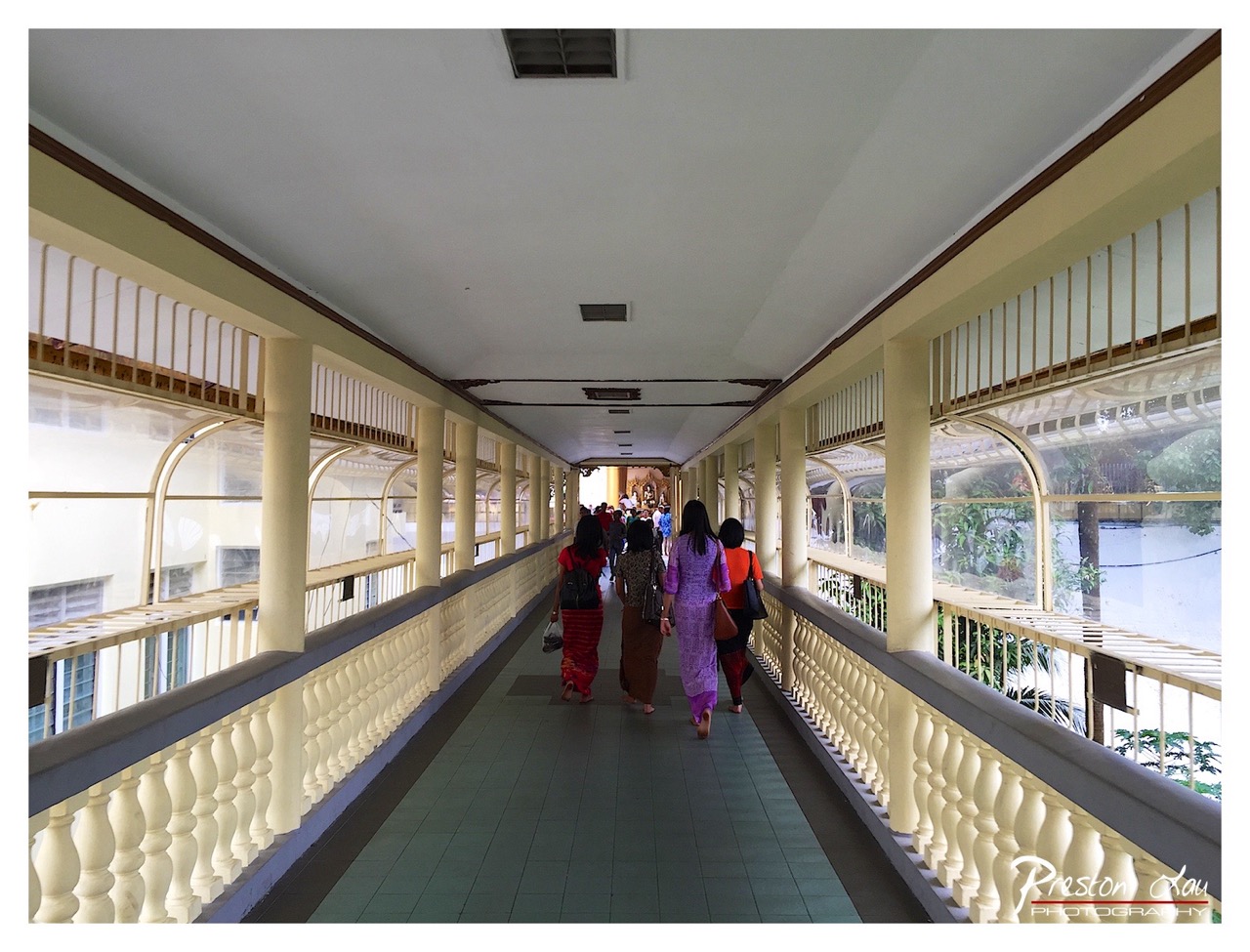

1. Overall Rating (0–10) — 7.0
This photograph captures a serene, contemplative moment within a temple corridor, where the movement of visitors guides the eye toward a distant focal point. The long, symmetrical walkway creates a sense of depth and purpose, while the soft natural light and warm tones lend a peaceful, almost sacred atmosphere. While the image is strong in composition and mood, it holds back slightly from full artistic impact due to its reliance on familiar architectural patterns and a somewhat conventional perspective.
2. Composition (0–10) — 8.0
The strong leading lines of the corridor draw the viewer’s gaze toward the center, creating a dynamic sense of movement and depth. The subjects are well-placed along the path, enhancing the narrative of pilgrimage or ritual. The symmetry of the arches and railings provides visual harmony, though the slight asymmetry of the figures adds natural variation.
3. Lighting (0–10) — 7.0
Natural light filters through the open sides of the corridor, creating a soft, even illumination that enhances the calm mood. The light is diffused, avoiding harsh shadows and maintaining a gentle glow throughout the scene. The ceiling fixtures are visible but do not detract from the natural ambiance.
4. Color & Tone (0–10) — 7.5
The warm yellow of the railings and pillars contrasts beautifully with the green floor tiles and the colorful attire of the people, creating a vibrant yet cohesive palette. The tones are balanced and harmonious, with subtle variations in hue that add visual interest without overwhelming the scene.
5. Creativity (0–10) — 6.5
The image effectively uses architectural elements to create a sense of journey and spirituality. While the concept is strong and the execution thoughtful, the subject matter—temple visitors walking a corridor—is familiar and does not push beyond conventional travel photography. The creativity lies more in the composition than in originality of concept.
6. Technical Quality (0–10) — 8.0
The image is sharp and well-focused, with clear details in both the foreground and background. The exposure is balanced, with no blown highlights or lost shadows. The watermark is discreet and does not interfere with the visual integrity of the photograph.
7. Emotional Impact (0–10) — 7.0
There is a quiet reverence in the image, evoked by the slow movement of the figures and the sacred architecture. The viewer is invited into a moment of reflection, suggesting a deeper cultural or spiritual context. The emotional resonance is subtle but present, particularly for those familiar with temple life or pilgrimage.
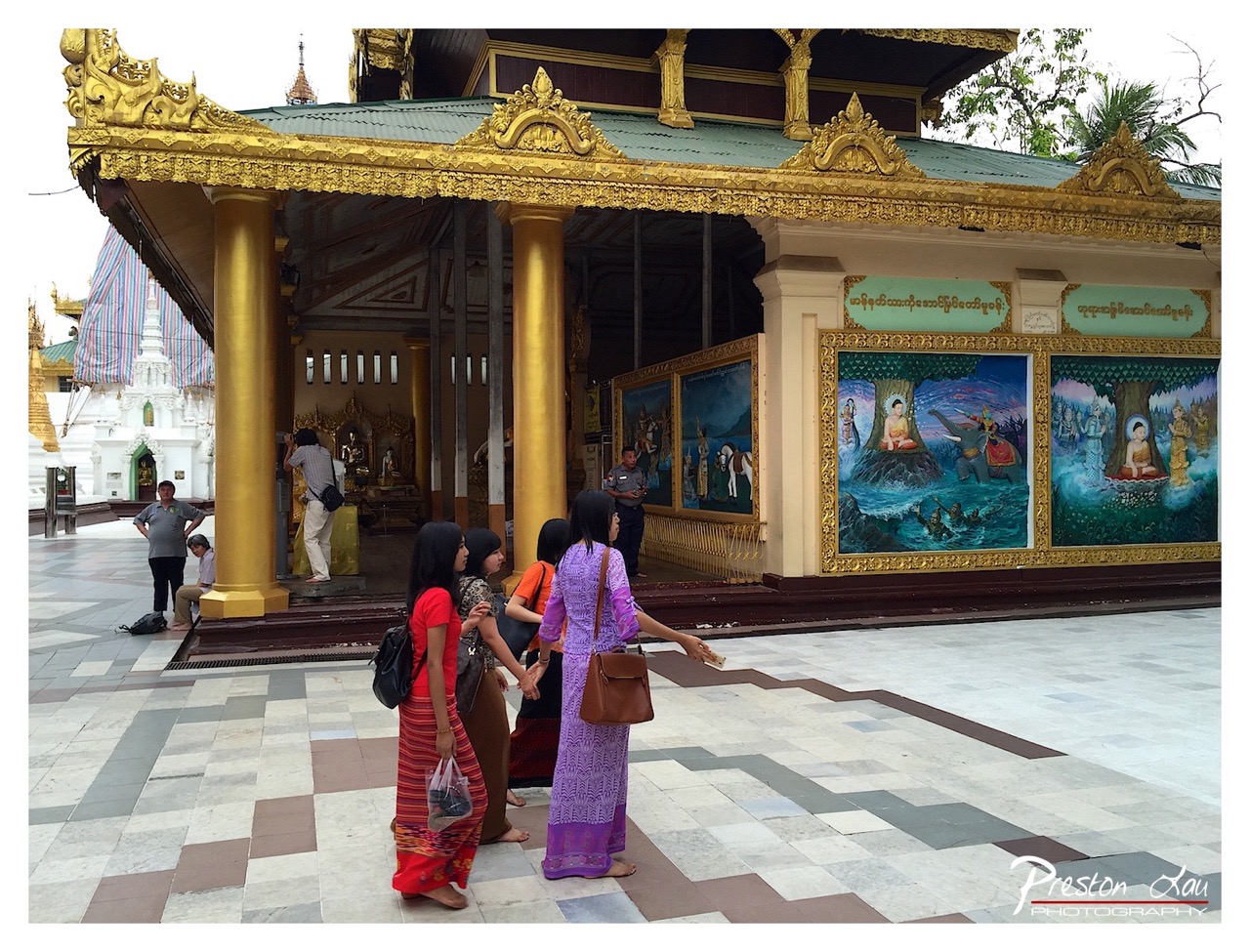

1. Overall Rating (0–10) — 7.0
This photograph captures the vibrant energy of a sacred space, where tradition and daily life converge under a golden temple canopy. The rich gold ornamentation and colorful murals create a visually striking contrast with the everyday attire of the visitors, grounding the scene in authenticity. While the image successfully conveys cultural immersion, the composition's slight busyness and overexposed sky detract from its overall cohesion and visual elegance.
2. Composition (0–10) — 6.5
The diagonal flow of the tiled walkway guides the eye toward the temple’s entrance, but the placement of the group in the foreground slightly disrupts balance. The framing feels slightly cluttered, with multiple figures and architectural elements competing for attention.
3. Lighting (0–10) — 6.0
The bright, overcast daylight evenly illuminates the scene, preserving detail in the temple’s gold and the murals. However, the sky is blown out, creating a stark white backdrop that diminishes atmospheric depth.
4. Color & Tone (0–10) — 7.5
The palette is rich with warm golds, deep purples, and reds, creating a harmonious and culturally resonant visual language. The contrast between the vivid attire and the neutral tiles adds visual interest, though the color temperature leans slightly cool due to the overcast conditions.
5. Creativity (0–10) — 7.0
The image tells a story of cultural observation and spiritual practice, capturing a candid moment of communal movement. The inclusion of the murals adds narrative layers, suggesting both devotion and storytelling.
6. Technical Quality (0–10) — 7.5
Sharp focus and clear detail are evident in the architectural and fabric textures. The exposure is generally well-managed, though the overexposed sky limits dynamic range.
7. Emotional Impact (0–10) — 6.5
The photograph evokes a sense of reverence and connection to tradition, yet the emotional resonance is tempered by the scene’s visual complexity. The viewer is drawn into the moment but may not feel deeply moved by its narrative.
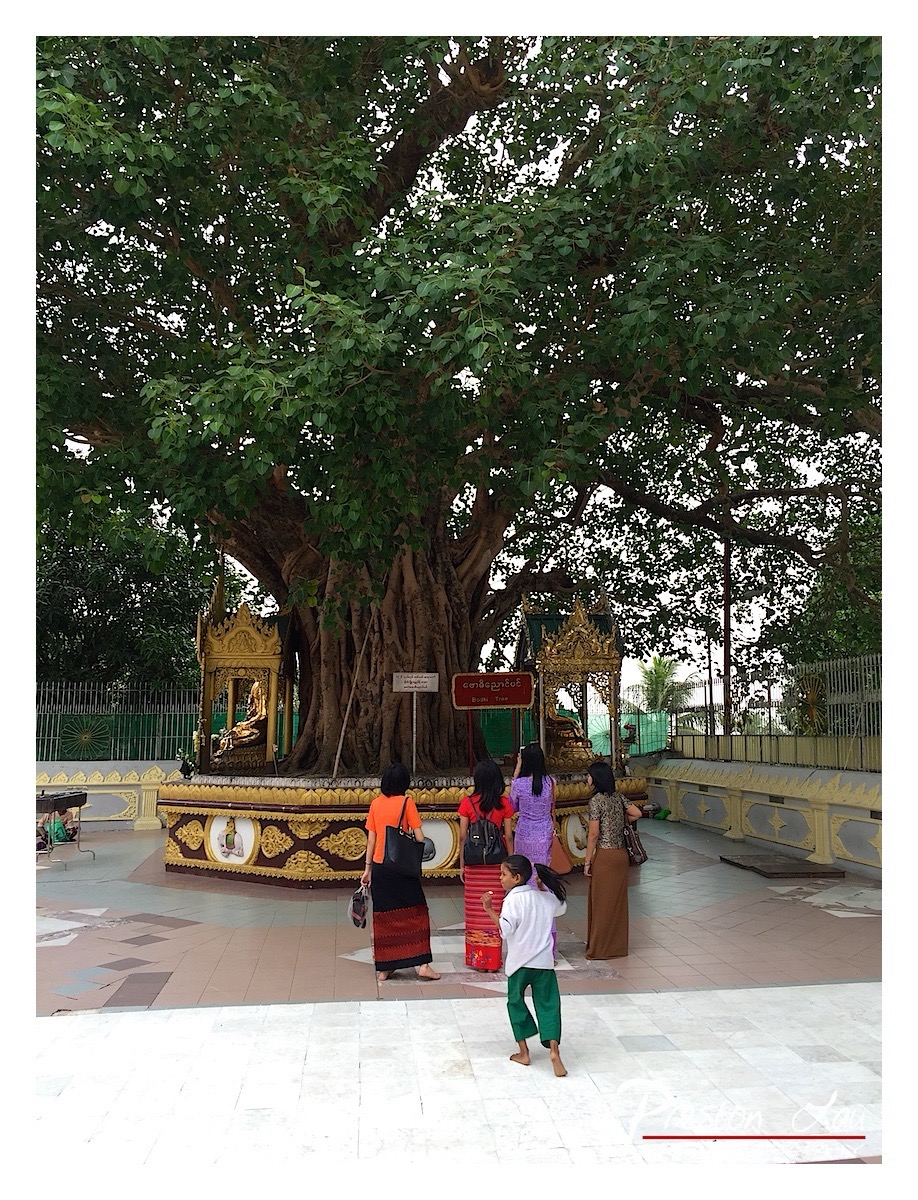

1. Overall Rating (0–10) — 7.0
This photograph captures a serene moment of reverence beneath a sacred bodhi tree, where cultural tradition and natural grandeur converge. The lush canopy and ornate golden shrines create a visually rich narrative of faith and continuity, though the composition’s slight imbalance and overexposed foreground soften its overall impact. The image succeeds as both a cultural document and a contemplative scene, inviting viewers into a quiet space of devotion.
2. Composition (0–10) — 6.5
The central placement of the tree anchors the image, but the wide frame and low vantage point dilute focus. The figures in the foreground, while adding narrative depth, slightly disrupt the visual harmony by drawing attention away from the main shrine.
3. Lighting (0–10) — 6.0
Diffuse daylight illuminates the scene evenly, preserving detail in both the tree’s foliage and the golden embellishments. However, the bright white foreground and overcast sky flatten contrast, muting the atmosphere’s potential warmth and drama.
4. Color & Tone (0–10) — 7.0
The rich golds of the shrines and deep greens of the tree create a striking contrast, enhanced by the traditional clothing of the visitors. The overall tone is balanced, though the slight washout in the lower half slightly diminishes the vibrancy.
5. Creativity (0–10) — 7.5
The photograph captures a moment of authentic cultural practice with a strong sense of place. The inclusion of children and worshippers adds layers of storytelling, transforming a static scene into a living tradition.
6. Technical Quality (0–10) — 7.5
The image is sharp and well-focused, with clear details in the tree bark and architectural elements. While the exposure is slightly uneven, the overall clarity and resolution are strong.
7. Emotional Impact (0–10) — 7.0
The scene evokes a quiet sense of reverence and continuity, inviting the viewer to reflect on the enduring connection between nature, faith, and community. The human presence enhances the emotional resonance, grounding the sacred in everyday life.
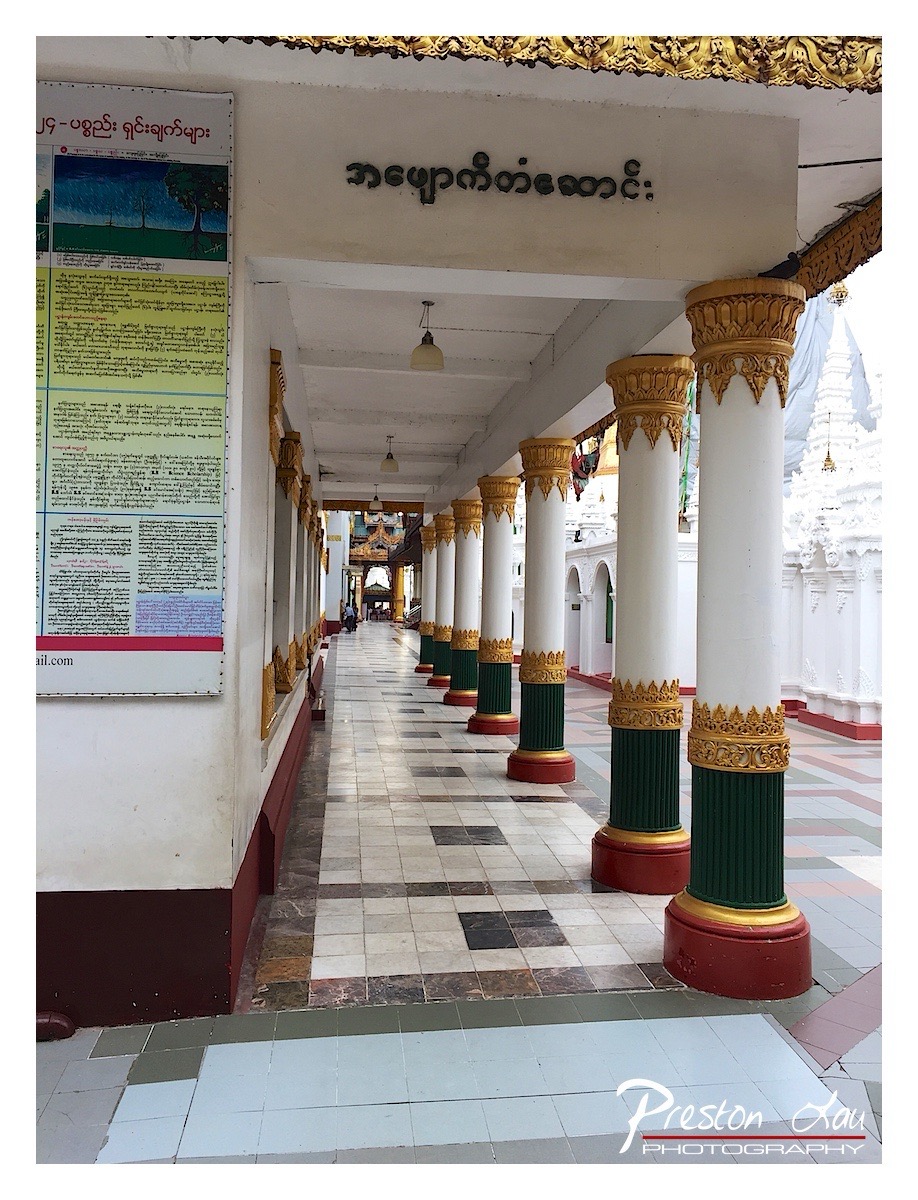

1. Overall Rating (0–10) — 7.0
This photograph captures the serene symmetry and ornate grandeur of a temple corridor, where tradition and architecture converge in quiet harmony. The repeating columns and tiled floor draw the eye into the depth of the space, while the golden accents and script add cultural richness. The image’s strength lies in its ability to convey both reverence and visual rhythm, though the presence of a watermark and a slightly cluttered informational panel slightly disrupt the aesthetic flow.
2. Composition (0–10) — 8.0
The strong leading lines of the colonnade and tiled floor create a powerful sense of perspective, guiding the viewer’s gaze into the distance. The framing is balanced, with the columns forming a rhythmic pattern that enhances the architectural harmony, though the left-side information board introduces a minor compositional distraction.
3. Lighting (0–10) — 7.0
Natural light filters evenly through the open corridor, illuminating the space without harsh shadows. The lighting is soft and diffused, highlighting the textures of the columns and tiles while maintaining a calm, contemplative mood.
4. Color & Tone (0–10) — 7.5
The palette of white, gold, green, and red is rich and culturally resonant, with warm tones that emphasize the temple’s ornate details. The contrast between the bright tiles and the darker column bases adds depth, while the overall tonal balance remains harmonious and inviting.
5. Creativity (0–10) — 7.0
The image effectively captures the architectural beauty and spiritual atmosphere of the space, using symmetry and perspective to tell a visual story. While the concept is straightforward, the careful attention to detail and composition elevates it beyond a simple documentation.
6. Technical Quality (0–10) — 8.0
The photograph is sharp and well-focused, with clean details visible in the columns and tiles. The exposure is well-managed, and the image is free from noticeable noise or artifacts, though the watermark slightly detracts from its professional presentation.
7. Emotional Impact (0–10) — 7.5
The image evokes a sense of peace and reverence, inviting the viewer to step into a space of quiet reflection. The grandeur of the architecture and the cultural elements stir a feeling of awe and connection to tradition, making the scene emotionally resonant and visually compelling.
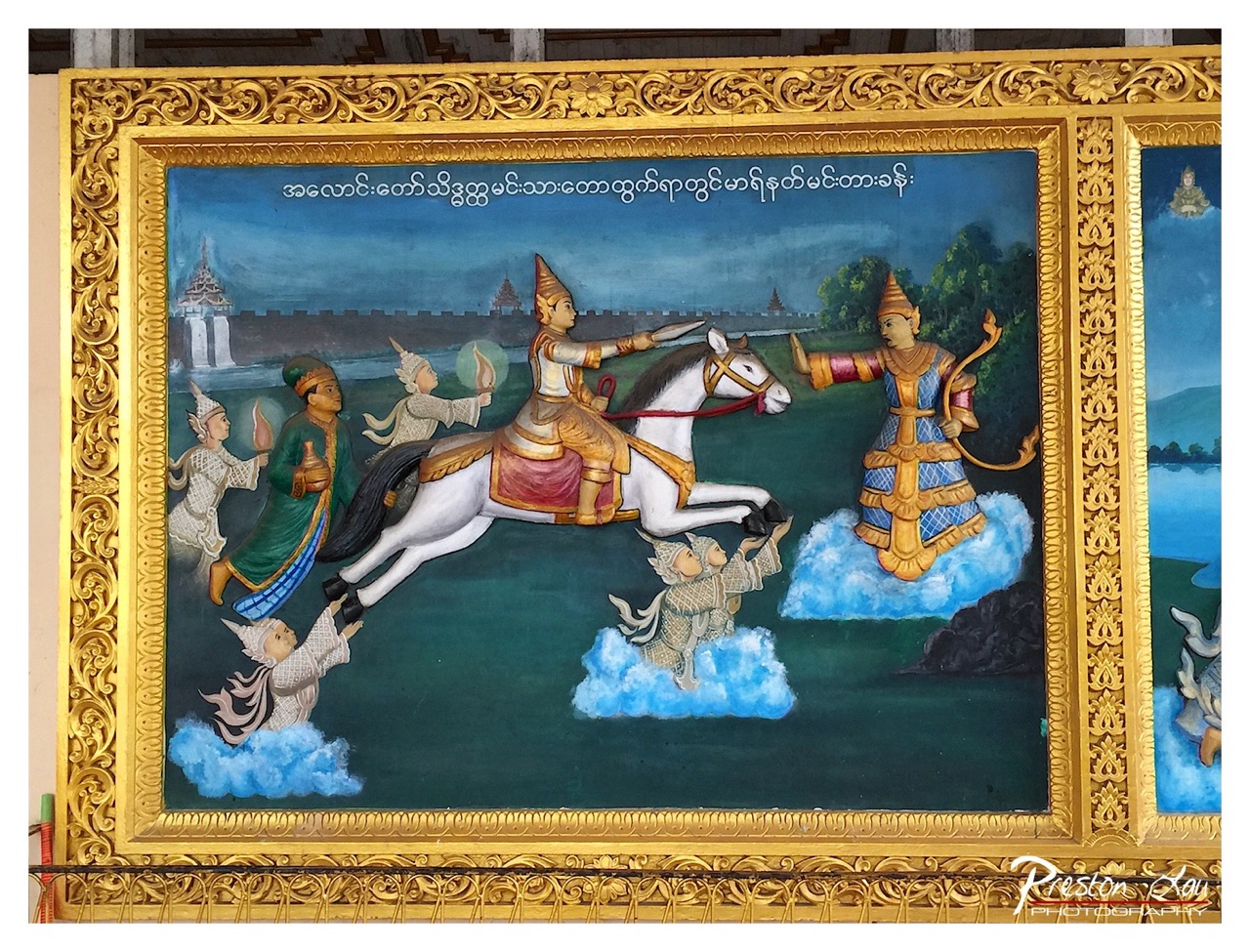

1. Overall Rating (0–10) — 7.5
This vibrant mural captures a dynamic moment from a traditional Southeast Asian narrative, rich in cultural symbolism and ceremonial detail. The gold frame enhances the sacredness of the scene, while the vivid colors and mythological figures create a sense of movement and divine drama. While the image is visually engaging, the flat, direct lighting slightly diminishes the depth of the painted figures, preventing it from fully conveying the spiritual weight of the subject.
2. Composition (0–10) — 7.0
The central figure on horseback draws the eye effectively, with the surrounding characters arranged to guide the viewer’s gaze across the scene. The ornate frame adds structure and reinforces the narrative’s ceremonial importance, though the inclusion of the adjacent panel slightly disrupts the visual focus.
3. Lighting (0–10) — 6.0
Even, ambient lighting illuminates the mural clearly but lacks directional depth, flattening the three-dimensional quality of the painted figures. The gold frame reflects light, creating some contrast, but the overall illumination feels functional rather than atmospheric.
4. Color & Tone (0–10) — 8.0
The palette is rich and expressive, with deep blues, radiant golds, and bold accents of red and green that evoke a sense of divine energy. The contrast between the luminous figures and the dark background enhances visual impact, though some colors appear slightly oversaturated.
5. Creativity (0–10) — 8.5
The artwork masterfully blends mythological storytelling with traditional artistic conventions, presenting a scene that is both culturally specific and universally compelling. The use of clouds and celestial elements adds a dreamlike quality, elevating the narrative beyond mere illustration.
6. Technical Quality (0–10) — 8.0
The image is sharp and detailed, capturing the intricate patterns of the frame and the fine brushwork of the mural. The watermark is unobtrusive, and the color reproduction is largely accurate, though slight digital noise appears in the darker areas.
7. Emotional Impact (0–10) — 7.5
The painting evokes awe and reverence, inviting contemplation of ancient stories and spiritual ideals. The intensity of the central figures and the dramatic composition stir a sense of wonder, though the viewer’s emotional connection is moderated by the image’s documentary nature.
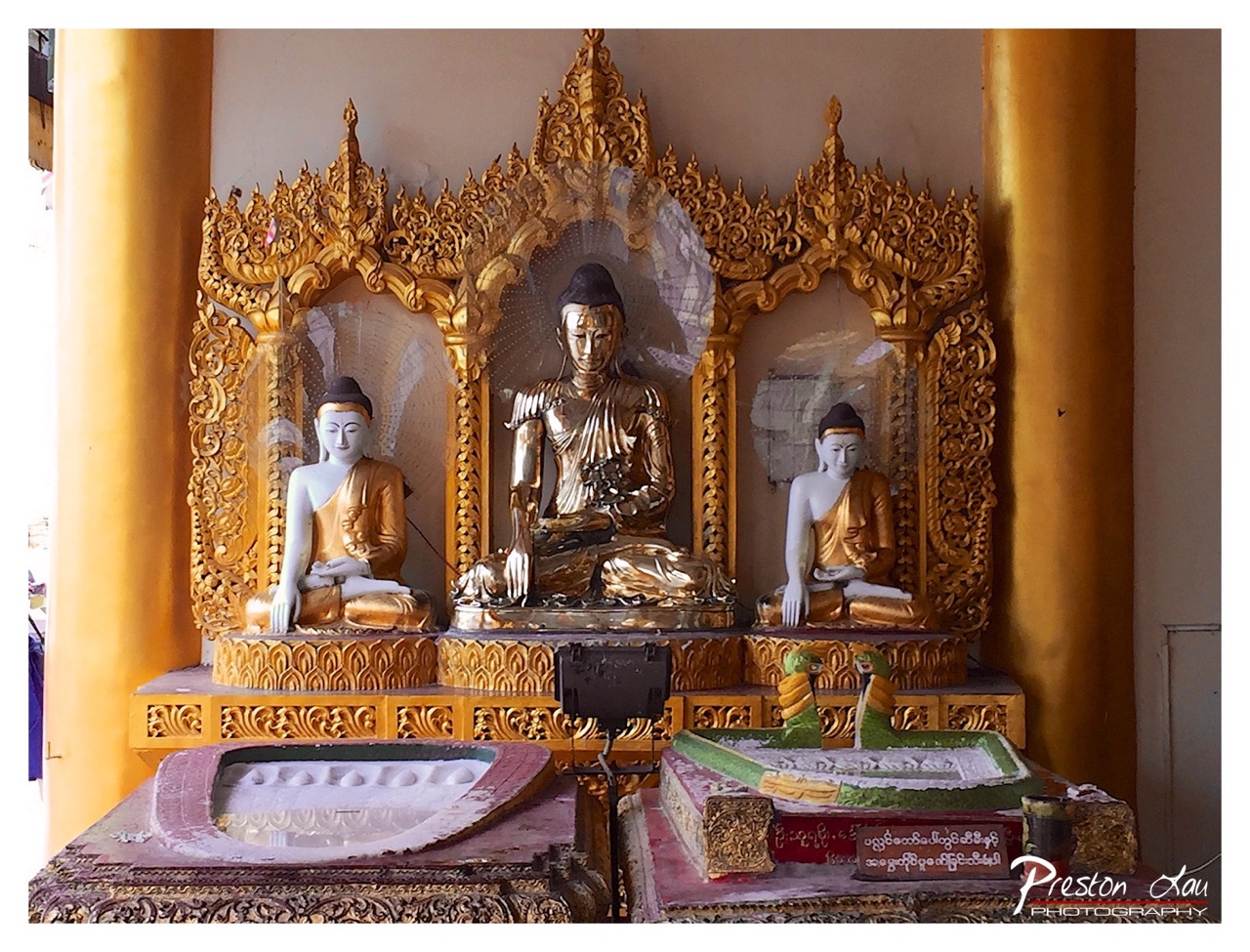

1. Overall Rating (0–10) — 7.0
This photograph captures the serene and reverent atmosphere of a Buddhist shrine, where golden ornamentation and sacred statuary convey a sense of devotion and cultural richness. The central Buddha figure commands attention with its radiant presence, while the surrounding elements—carved details, offerings, and soft light—add layers of spiritual depth. While the image is visually compelling, the cluttered foreground and slight overexposure in the background detract from its compositional harmony and emotional subtlety.
2. Composition (0–10) — 6.5
The central Buddha is well-framed, creating a strong focal point, but the foreground elements—including the offering bowls and camera equipment—distract from the sacred space. The symmetry of the shrine is balanced, yet the framing feels slightly off-center, with the left pillar cutting into the frame and disrupting visual flow.
3. Lighting (0–10) — 6.0
Natural light from the left softly illuminates the golden statues, enhancing their texture and reflective quality. However, the bright side lighting creates harsh highlights on the left pillar and overexposes the background, diminishing the depth and mood of the scene.
4. Color & Tone (0–10) — 7.5
The dominant golds and warm tones evoke a sense of reverence and timelessness, while the contrast between the luminous statues and the muted background walls adds visual richness. The color palette is harmonious and culturally resonant, though some areas appear washed out due to lighting.
5. Creativity (0–10) — 7.0
The image successfully captures the spiritual essence of the shrine with attention to cultural detail and symmetry. The inclusion of the photographer’s watermark and the candid presence of offering bowls adds a layer of authenticity, though the composition could be more refined to elevate its artistic impact.
6. Technical Quality (0–10) — 7.0
The focus is sharp on the central Buddha, and the fine details of the goldwork are clearly visible. The image is well-exposed overall, though the overexposed areas and slight noise in the highlights suggest room for improvement in dynamic range control.
7. Emotional Impact (0–10) — 7.5
The image evokes a quiet sense of peace and devotion, inviting contemplation of faith and tradition. The golden radiance of the Buddha and the presence of offerings create a tangible connection to spiritual practice, making the scene feel both intimate and sacred.
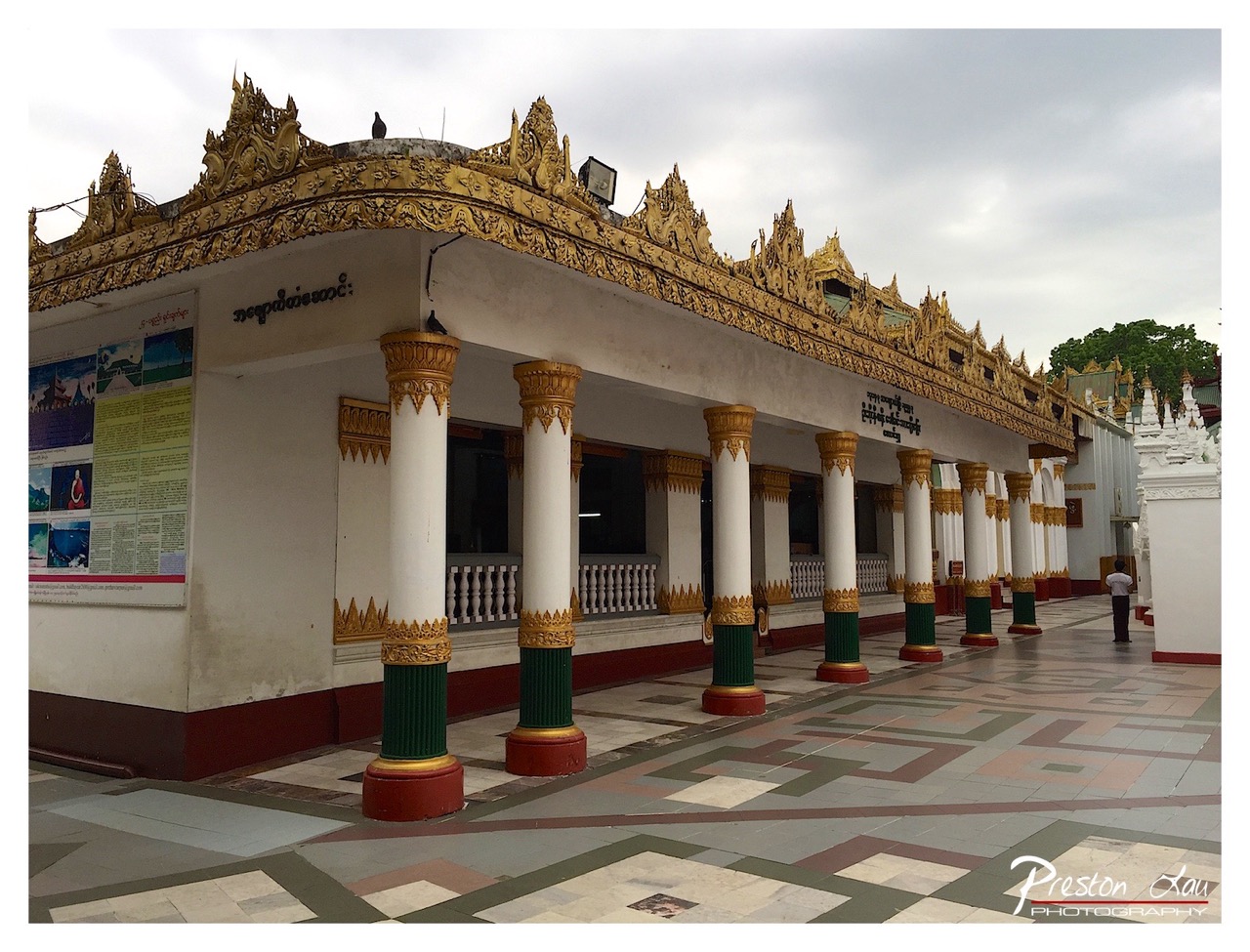

1. Overall Rating (0–10) — 7.0
This photograph captures the serene dignity of a Burmese temple structure, where ornate gold detailing contrasts with the simplicity of white pillars and a muted sky. The composition draws the eye along the colonnade, emphasizing the rhythm of the architecture and the quiet presence of the space. While the overcast lighting tempers the vibrancy of the gold, the image succeeds in conveying a sense of cultural reverence and architectural harmony.
2. Composition (0–10) — 7.5
The strong diagonal line of the colonnade creates a compelling sense of depth, leading the viewer’s gaze through the frame. The placement of the lone figure at the far end adds scale and narrative, while the balanced framing of the building’s corner enhances symmetry and order.
3. Lighting (0–10) — 6.0
The diffused light from the overcast sky softens shadows and evenly illuminates the scene, though it dampens the richness of the gold accents. This creates a subdued mood, lending the image a contemplative tone but sacrificing some visual drama.
4. Color & Tone (0–10) — 6.5
The palette is restrained, with muted whites, deep greens, and reds forming a calm base, while the gold trim provides a touch of luminance. The tonal range is consistent but lacks contrast, resulting in a slightly flat appearance that softens the architectural details.
5. Creativity (0–10) — 7.0
The photograph thoughtfully captures the intersection of tradition and everyday life, using composition and scale to suggest a quiet moment within a sacred space. The inclusion of the poster and the solitary figure adds narrative depth, elevating the image beyond mere documentation.
6. Technical Quality (0–10) — 8.0
The image is sharp and well-focused, with clean lines and balanced exposure. The resolution and clarity effectively render the intricate carvings and tile patterns, demonstrating strong technical execution.
7. Emotional Impact (0–10) — 7.0
The photograph evokes a sense of peace and cultural reverence, inviting reflection on the continuity of tradition. The quiet atmosphere and subtle human presence create a gentle emotional resonance, suggesting a space where stillness and devotion coexist.
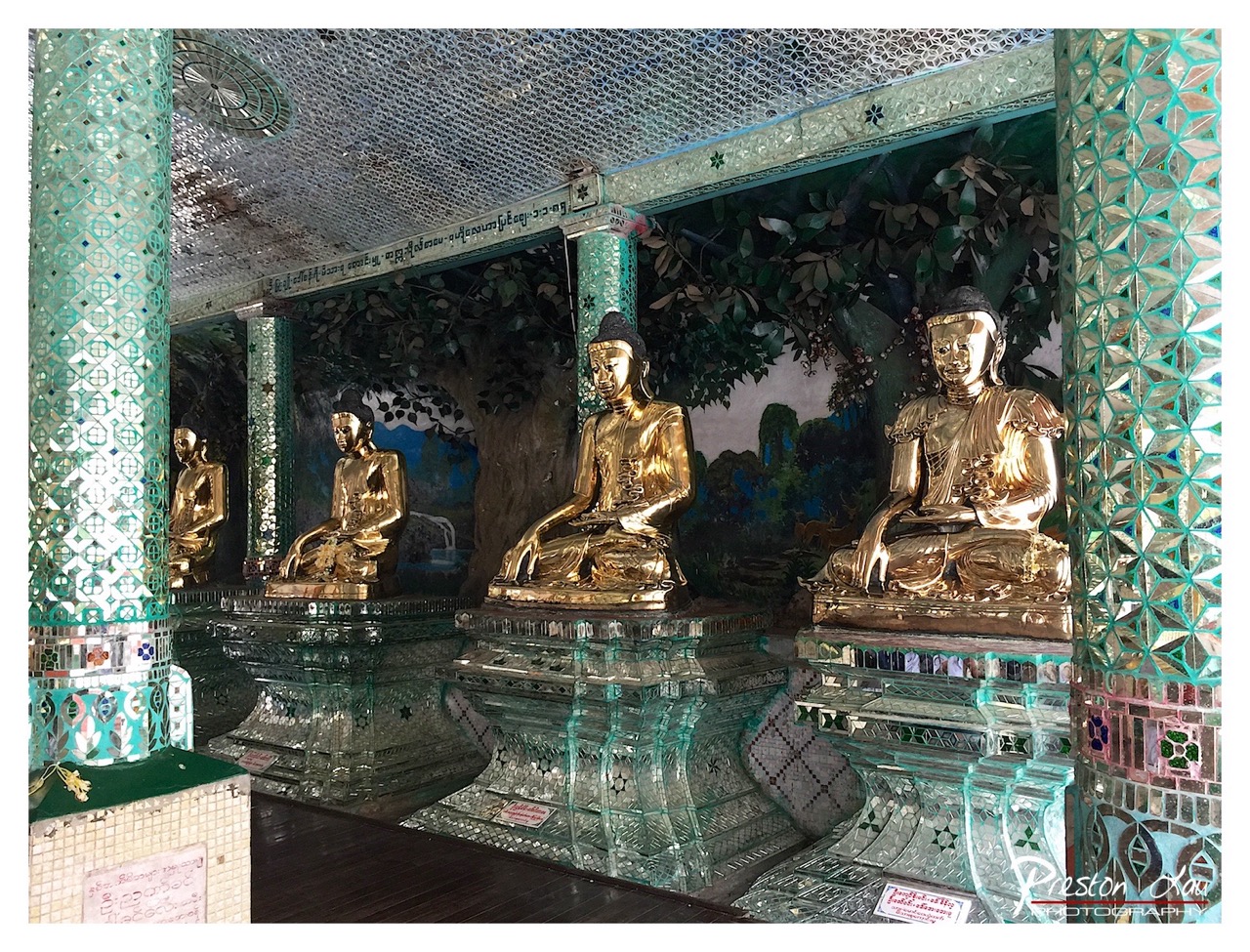

1. Overall Rating (0–10) — 7.5
This photograph captures the serene grandeur of a Buddhist shrine, where golden statues of the Buddha rest in meditative repose beneath a shimmering mosaic ceiling. The interplay of light on the reflective surfaces creates a sense of sacred stillness, while the intricate tilework and painted backdrop add layers of cultural richness. While the image is visually dense, it succeeds in conveying reverence and architectural beauty, though the composition feels slightly cluttered by the sheer volume of detail.
2. Composition (0–10) — 6.5
The image is framed with a wide perspective that includes multiple elements, leading to a sense of depth but also visual overload. The central Buddha is well-placed, but the surrounding statues and pillars create a busy foreground that distracts from the focal point.
3. Lighting (0–10) — 7.0
Soft, ambient light enhances the reflective qualities of the gold and mosaic tiles, creating a luminous glow that complements the spiritual atmosphere. However, the light is uneven, with some areas slightly overexposed and others in shadow, reducing overall balance.
4. Color & Tone (0–10) — 7.5
The dominant palette of gold and turquoise creates a harmonious and regal aesthetic, with the cool green tones of the tiles contrasting beautifully against the warm gold. The color saturation enhances the richness of the scene, though some areas appear slightly washed out.
5. Creativity (0–10) — 7.0
The photographer captures a deeply cultural and spiritual space with an eye for detail and texture. The choice to include the full breadth of the interior emphasizes the site’s opulence and devotion, offering a compelling narrative of faith and craftsmanship.
6. Technical Quality (0–10) — 8.0
The image is sharp and clear, with fine detail visible in the mosaic work and golden surfaces. Focus is consistent across the frame, and the digital clarity allows for appreciation of the intricate textures.
7. Emotional Impact (0–10) — 7.5
The photograph evokes a sense of peace and awe, inviting the viewer to contemplate the devotion embedded in the space. The reflective surfaces and tranquil poses of the Buddha figures create a meditative mood, though the complexity of the scene may limit immediate emotional connection.
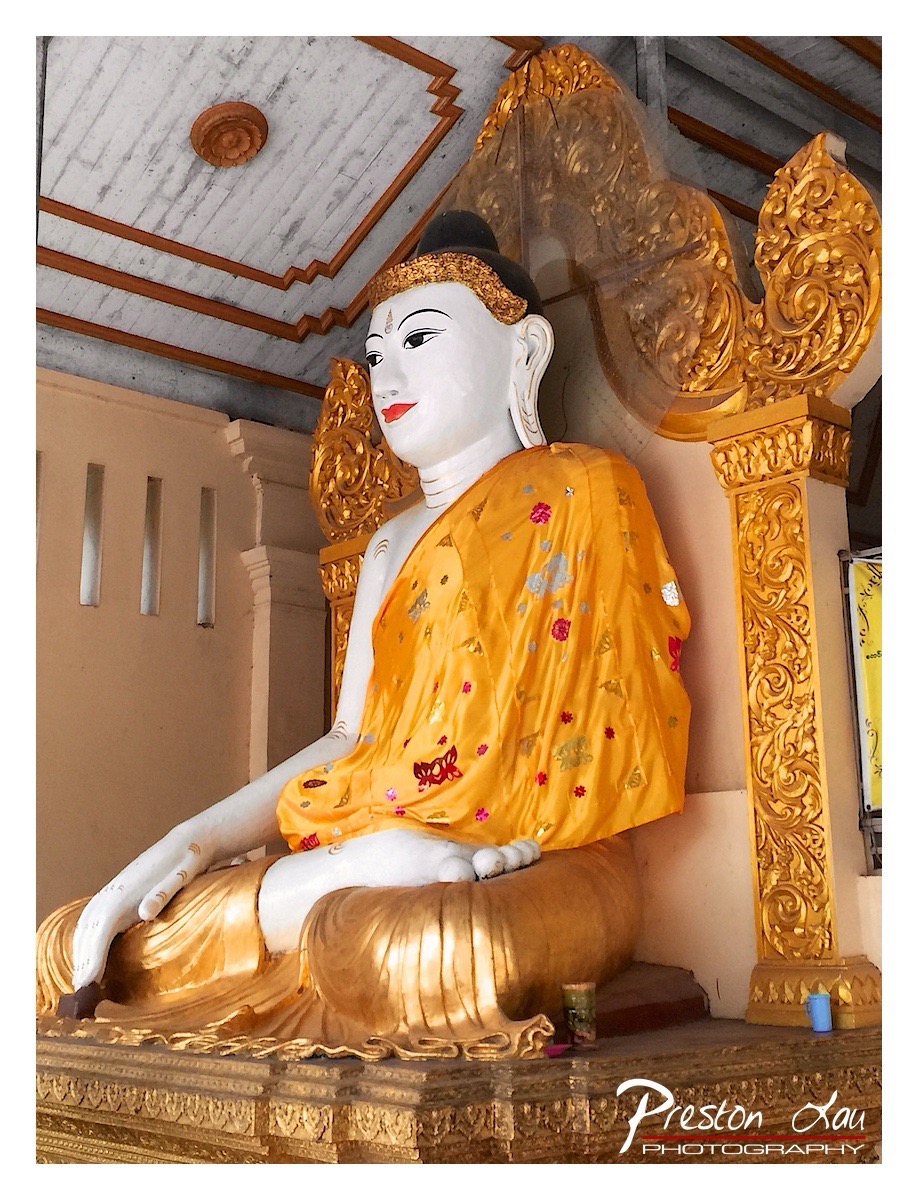

1. Overall Rating (0–10) — 7.5
This photograph captures the serene majesty of a Buddha statue with a striking balance of reverence and artistry. The golden embellishments and rich textures convey a sense of sacred devotion, while the clean lines and deliberate framing emphasize the subject’s spiritual presence. The image succeeds in highlighting both the craftsmanship of the statue and the quiet atmosphere of the temple space, though the slightly awkward angle and framing detract from its overall elegance.
2. Composition (0–10) — 6.5
The statue is centered but slightly off-kilter, with the left side of the frame feeling more compressed than the right. The ornate golden backdrop draws the eye, but the composition could benefit from tighter framing to eliminate distracting elements and enhance focus on the figure.
3. Lighting (0–10) — 7.0
Natural light from the left softly illuminates the statue, enhancing the texture of the fabric and the gleam of gold. The shadows are gentle and directional, adding depth without obscuring details. The lighting supports the meditative mood of the scene.
4. Color & Tone (0–10) — 8.0
The warm golden tones of the robe and architecture create a harmonious palette, complemented by the white face and subtle pops of red and pink in the fabric. The color balance is rich and balanced, with excellent contrast that makes the subject pop against the more neutral background.
5. Creativity (0–10) — 7.5
The photographer captures a traditional subject with a fresh, respectful perspective. The emphasis on texture, pattern, and sacred detail elevates the image beyond mere documentation into a contemplative visual narrative.
6. Technical Quality (0–10) — 8.0
Sharp focus and clear detail across the statue and background elements demonstrate strong technical execution. The image is well-exposed, with minimal noise, and the watermark is unobtrusive.
7. Emotional Impact (0–10) — 8.0
The stillness and calm of the Buddha’s expression, combined with the warm, reverent lighting, evoke a deep sense of peace and devotion. The viewer is invited into a quiet moment of spiritual reflection.
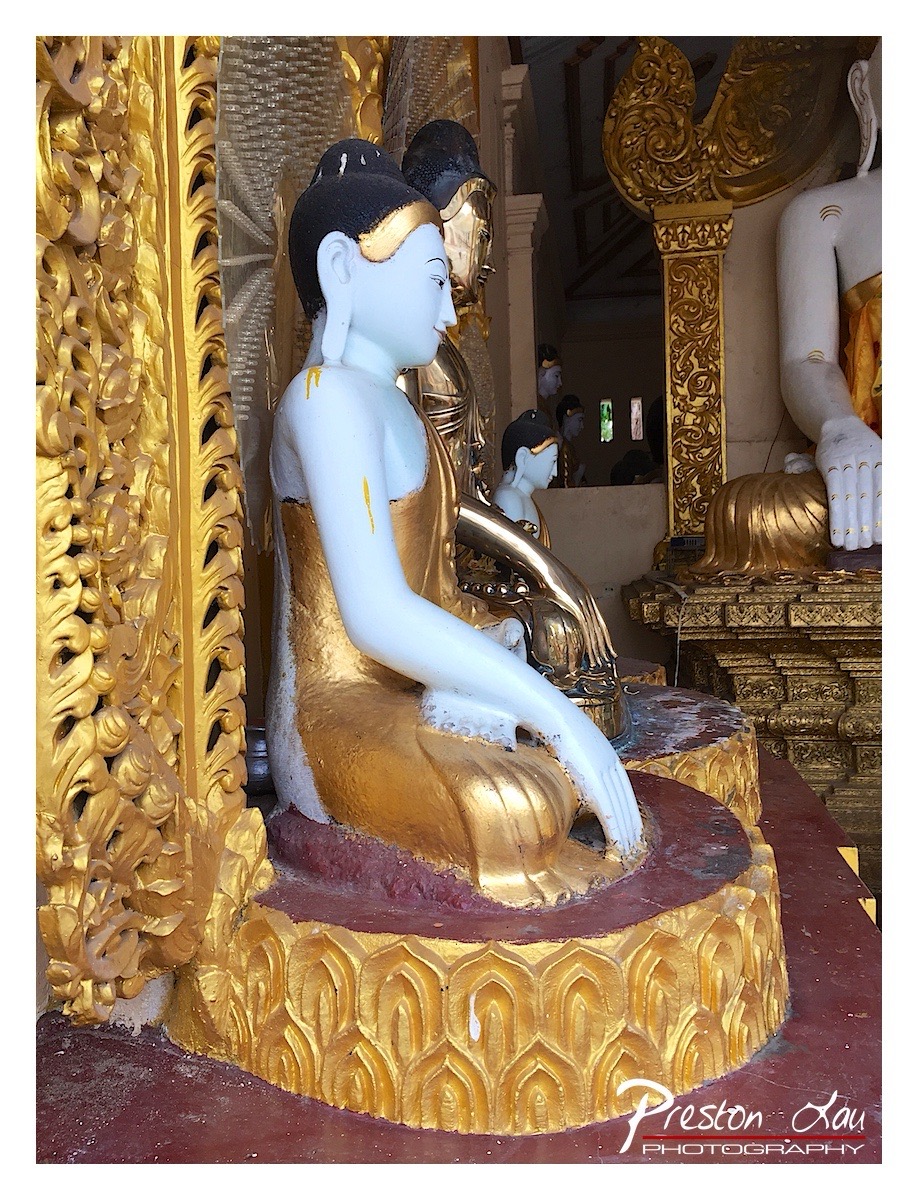

1. Overall Rating (0–10) — 7.5
This photograph captures the serene dignity of a Buddhist shrine, where the interplay of white and gold conveys both reverence and opulence. The composition draws the eye through layered figures and ornate carvings, creating a sense of depth and spiritual stillness. While the lighting is somewhat flat and the background slightly cluttered, the image succeeds in conveying the sacred atmosphere of the space, balancing detail with a contemplative mood.
2. Composition (0–10) — 7.0
The subject is well-placed in profile, with the golden arch framing the left side and leading the eye toward the seated Buddha. The layered arrangement of figures adds depth, though the background elements slightly distract from the main subject.
3. Lighting (0–10) — 6.5
The light is even and diffuse, likely from an indoor source, which flattens shadows and reduces texture. While it ensures clarity, it diminishes the sense of dimension and atmospheric drama.
4. Color & Tone (0–10) — 8.0
The palette of white, gold, and deep red is rich and harmonious, evoking the sacred aesthetics of Southeast Asian temples. The contrast between the cool white and warm gold enhances the visual appeal and spiritual resonance.
5. Creativity (0–10) — 7.5
The image captures a moment of quiet devotion with a strong sense of place. The layered perspective and focus on detail reflect a thoughtful approach, transforming a simple religious scene into a visually engaging narrative.
6. Technical Quality (0–10) — 8.0
Sharp focus and clean detail are evident, particularly in the intricate carvings and the smooth finish of the Buddha’s form. The resolution and clarity support the image’s decorative and documentary qualities.
7. Emotional Impact (0–10) — 8.0
The stillness of the Buddha’s pose, combined with the golden surroundings, evokes a sense of peace and reverence. The viewer is drawn into a moment of quiet contemplation, feeling the weight of tradition and devotion.
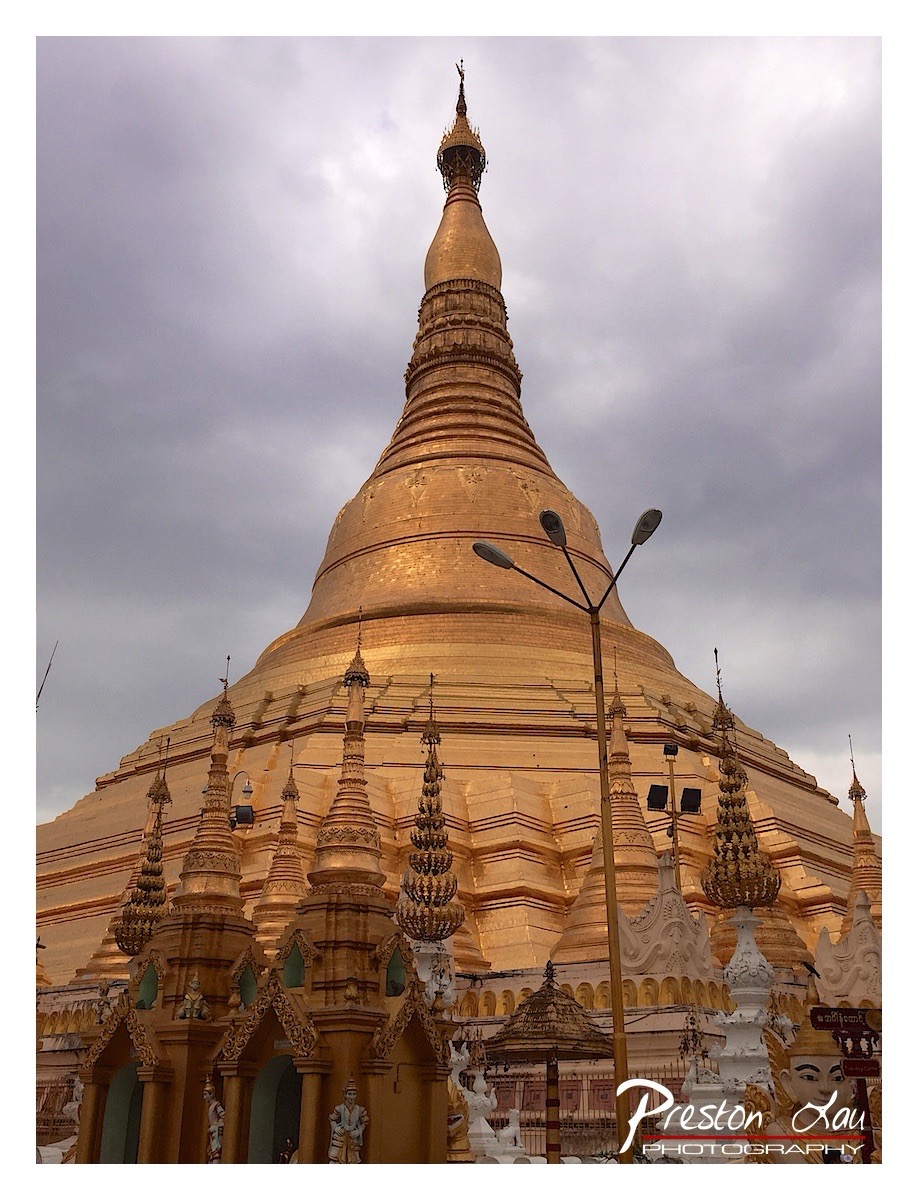

1. Overall Rating (0–10) — 7.0
This photograph captures the majestic grandeur of a golden pagoda under a brooding sky, where the contrast between sacred architecture and overcast light evokes a sense of reverence and solemnity. The rich gold of the stupa dominates the frame, drawing the eye upward toward its tapering spire, while the surrounding structures and streetlamp add layers of cultural and urban context. Though the composition is strong, the intrusion of modern elements slightly disrupts the spiritual atmosphere, and the lighting, while dramatic, lacks the warmth to fully animate the gold’s luminosity.
2. Composition (0–10) — 7.5
The low-angle perspective emphasizes the pagoda’s towering presence, and the placement of the main spire near the vertical center creates a strong focal point. The foreground structures and streetlamp frame the image naturally, adding depth, though the lamp’s modern form introduces a subtle visual dissonance.
3. Lighting (0–10) — 6.5
The diffused light from the overcast sky softens shadows and evenly illuminates the stupa, highlighting its golden surface without harsh glare. However, the cool, muted tones of the clouds dull the warmth of the gold, preventing the image from radiating the expected luminosity.
4. Color & Tone (0–10) — 7.0
The dominant golden hue is rich and consistent, creating a visually cohesive palette. The contrast between the warm gold and the cool gray of the sky enhances the image’s dramatic tension. A touch more saturation would further elevate the vibrancy of the gold.
5. Creativity (0–10) — 7.0
The image successfully blends sacred architecture with urban elements, offering a layered narrative that speaks to the coexistence of tradition and modernity. The choice to frame the pagoda against a stormy sky adds a contemplative, almost cinematic quality.
6. Technical Quality (0–10) — 8.0
The photograph is sharp and well-focused, with clear detail visible in the intricate carvings and tiered structure of the stupa. The exposure is balanced, and the dynamic range is managed effectively despite the challenging lighting conditions.
7. Emotional Impact (0–10) — 7.5
The image conveys a quiet awe, inviting the viewer to reflect on the spiritual significance of the site. The juxtaposition of the golden stupa against the dark, brooding sky creates a powerful emotional resonance, evoking both reverence and introspection.
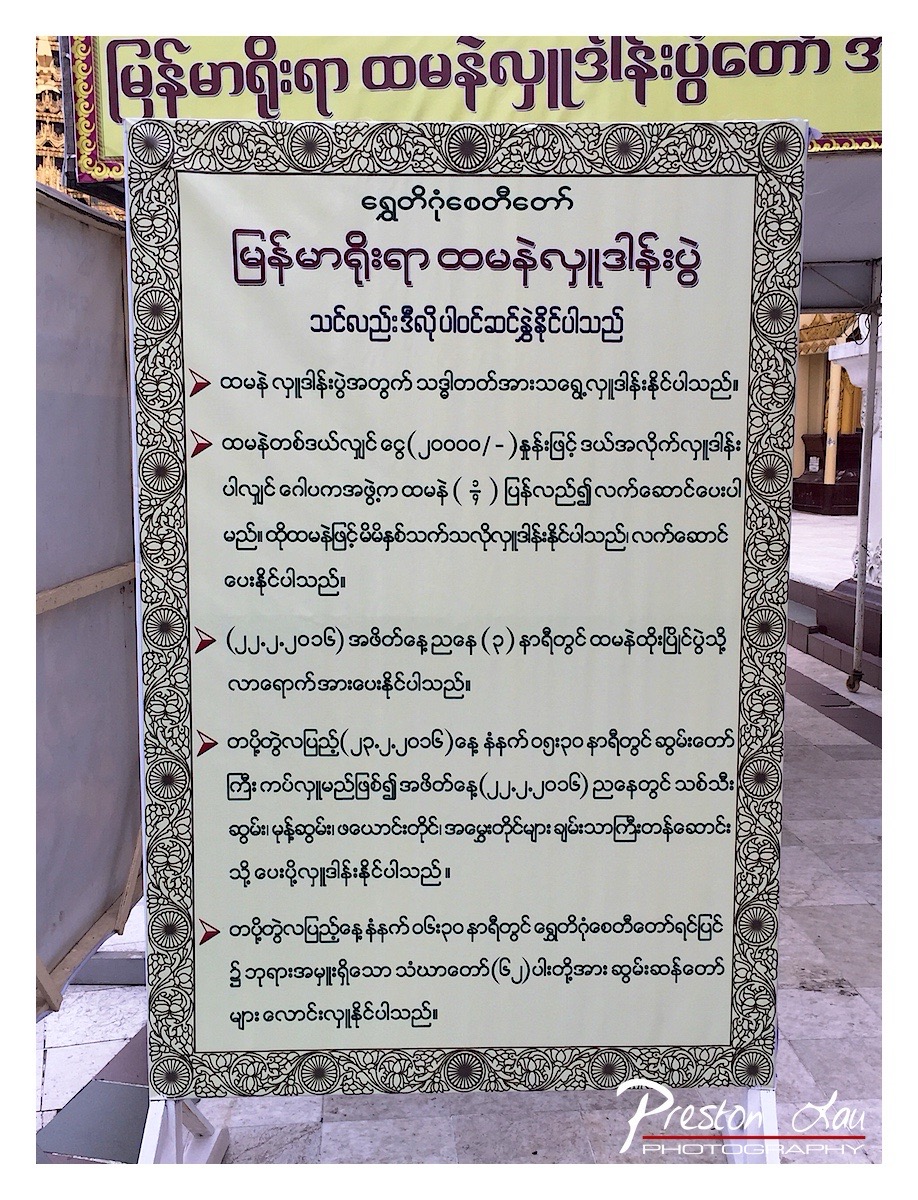

1. Overall Rating (0–10) — 6.0
This photograph captures a cultural sign in a religious setting, offering a glimpse into local traditions and language. The ornate border and formal script lend a sense of reverence, while the slightly off-center framing and cluttered background distract from the sign’s visual clarity. Though the image successfully documents a moment of cultural expression, its technical execution and composition limit its aesthetic and emotional resonance.
2. Composition (0–10) — 5.5
The sign is the central focus, but the uneven framing and visible scaffolding on the left create visual imbalance. The background elements, including the tent and distant structure, add distraction without enhancing context.
3. Lighting (0–10) — 6.0
Natural daylight provides even illumination, preserving legibility of the text. However, the lighting is flat and lacks directional warmth or contrast, reducing the depth and mood of the scene.
4. Color & Tone (0–10) — 5.5
The color palette is muted, dominated by off-white, black, and gray tones. The ornate border provides visual interest, but the lack of color vibrancy gives the image a neutral, documentary feel.
5. Creativity (0–10) — 6.0
The photograph documents a culturally significant object with respect, but it lacks a unique visual perspective or artistic interpretation. The emphasis is on information rather than storytelling or aesthetic expression.
6. Technical Quality (0–10) — 7.0
The image is sharp and in focus, with clear text and clean edges. The watermark is professionally placed and does not obstruct the main subject.
7. Emotional Impact (0–10) — 5.0
The image conveys a sense of place and tradition, but the lack of human presence or emotional context keeps the viewer at a distance. The emotional weight lies in the cultural content rather than the visual presentation.
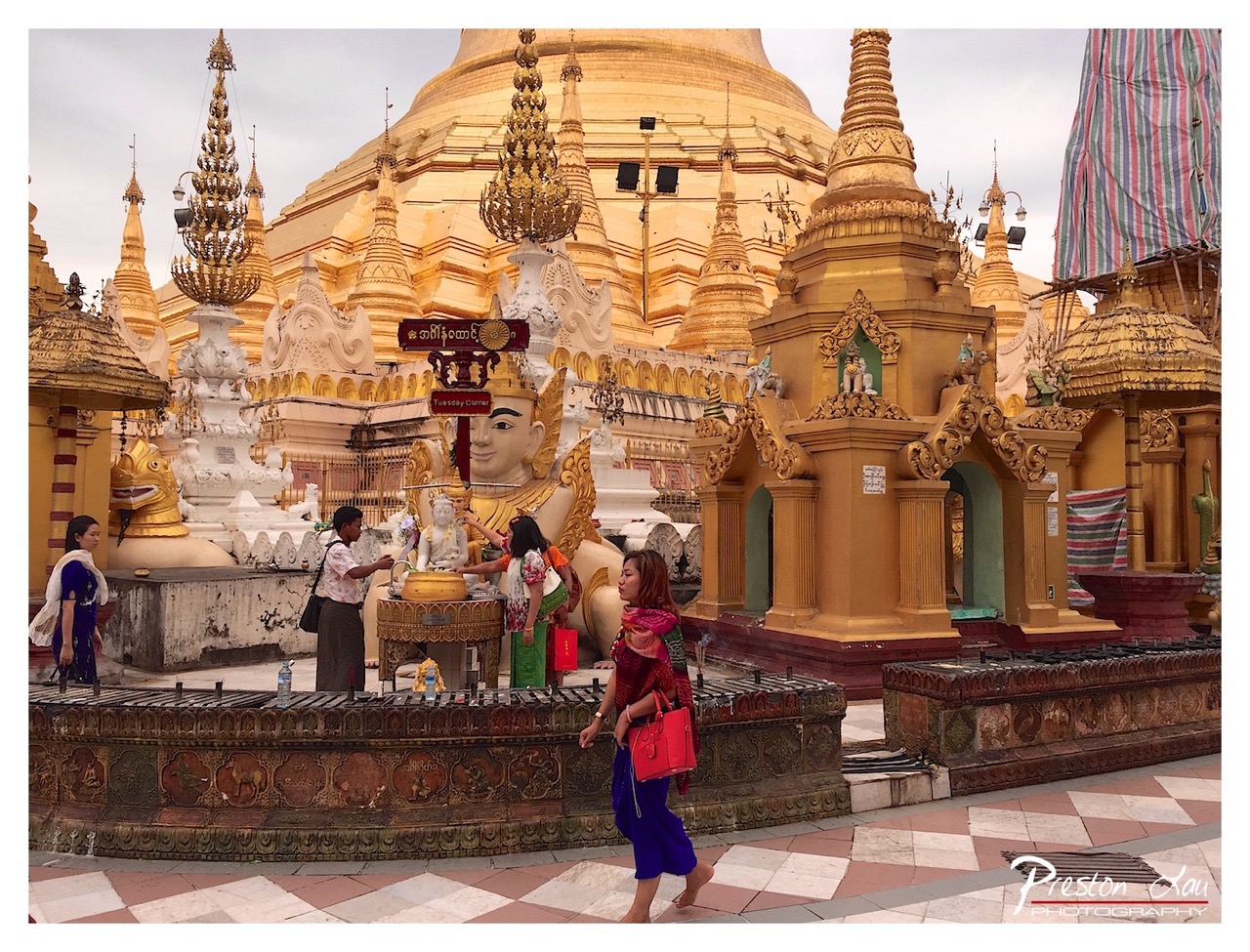

1. Overall Rating (0–10) — 7.5
This photograph captures the vibrant energy and spiritual richness of a bustling Buddhist temple complex, where tradition and daily life intertwine. The golden spires and intricate carvings create a sense of awe, while the presence of people engaged in prayer and movement grounds the scene in human experience. While the composition is slightly crowded, the image successfully conveys both the grandeur of the architecture and the quiet devotion of its visitors.
2. Composition (0–10) — 6.5
The central golden stupa dominates the frame, drawing the eye upward, but the foreground activity and multiple architectural elements create visual clutter. A tighter crop or more intentional use of negative space could enhance focus on the primary subject.
3. Lighting (0–10) — 6.0
Soft, diffused daylight from an overcast sky evenly illuminates the scene, minimizing harsh shadows and allowing the golden tones to stand out. However, the lack of strong directional light reduces depth and drama.
4. Color & Tone (0–10) — 7.0
The warm golds and rich purples of the clothing create a harmonious palette, while the checkered floor adds a subtle geometric contrast. The colors are vivid but not oversaturated, lending authenticity to the scene.
5. Creativity (0–10) — 7.5
The image captures a moment of cultural and spiritual life with a strong sense of place. The inclusion of both the ornate temple structures and the people interacting with them adds narrative depth and a sense of lived experience.
6. Technical Quality (0–10) — 8.0
The image is sharp and well-focused, with clear detail in both the foreground and background. The exposure is balanced, and the depth of field is sufficient to keep key elements in focus.
7. Emotional Impact (0–10) — 7.0
The photograph evokes a sense of reverence and serenity, inviting the viewer to contemplate the spiritual significance of the space. The presence of people in prayer adds a layer of intimacy and connection, making the scene feel both majestic and human.
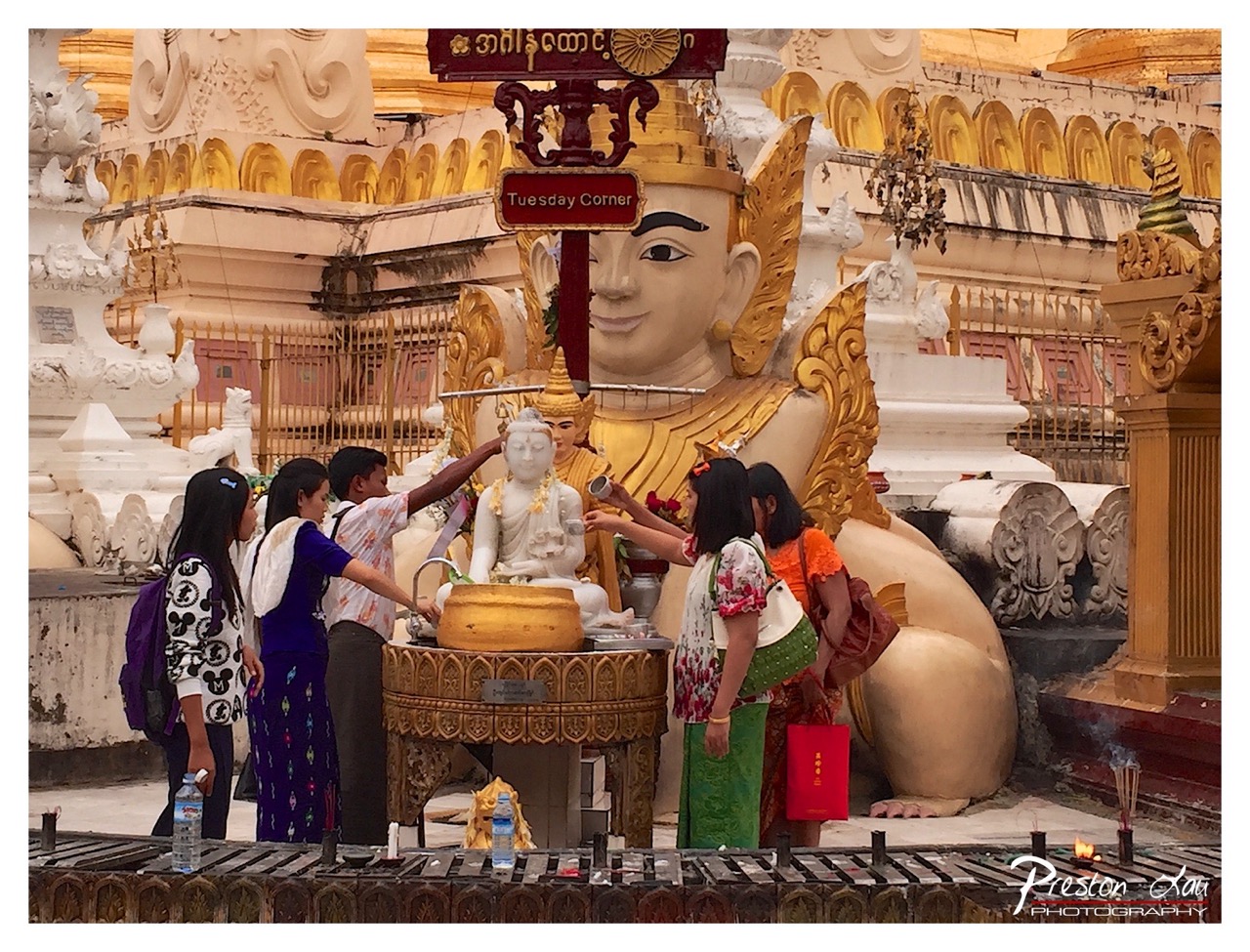

1. Overall Rating (0–10) — 7.0
This photograph captures a vibrant moment of devotion at a sacred Buddhist site, where tradition and daily life converge in a richly textured scene. The golden architecture and ceremonial activity create a sense of reverence and cultural depth, though the composition's crowded feel slightly undermines its visual clarity. The image succeeds in conveying the spiritual atmosphere while also documenting the human element of worship.
2. Composition (0–10) — 6.0
The frame is filled with multiple subjects and architectural elements, leading to a cluttered foreground and midground. While the central Buddha statue and the "Tuesday Corner" sign provide focal points, the arrangement feels busy, with overlapping figures and structures competing for attention.
3. Lighting (0–10) — 7.0
Natural daylight illuminates the scene evenly, enhancing the warmth of the golden structures and the contrast of the white statues. The soft shadows and bright highlights add depth without obscuring details, contributing to the image's authenticity.
4. Color & Tone (0–10) — 7.0
The palette is dominated by rich golds, creamy whites, and earthy tones, with pops of color from the visitors’ clothing. The warm color temperature enhances the spiritual ambiance, and the tonal range is well-balanced, capturing both highlights and shadows effectively.
5. Creativity (0–10) — 7.0
The photograph successfully blends documentary realism with artistic storytelling, capturing a candid moment within a sacred context. The juxtaposition of modern visitors with ancient religious symbols offers a compelling narrative of continuity and faith.
6. Technical Quality (0–10) — 7.5
The image is sharp and well-focused, with clear details visible in the carvings, textiles, and facial expressions. The exposure is balanced, and the depth of field appropriately captures both the foreground and background elements.
7. Emotional Impact (0–10) — 7.5
The scene evokes a sense of peaceful devotion and cultural continuity, inviting the viewer to reflect on the enduring nature of faith. The quiet interaction of the worshippers with the sacred space creates a powerful emotional resonance, even amidst the visual complexity.
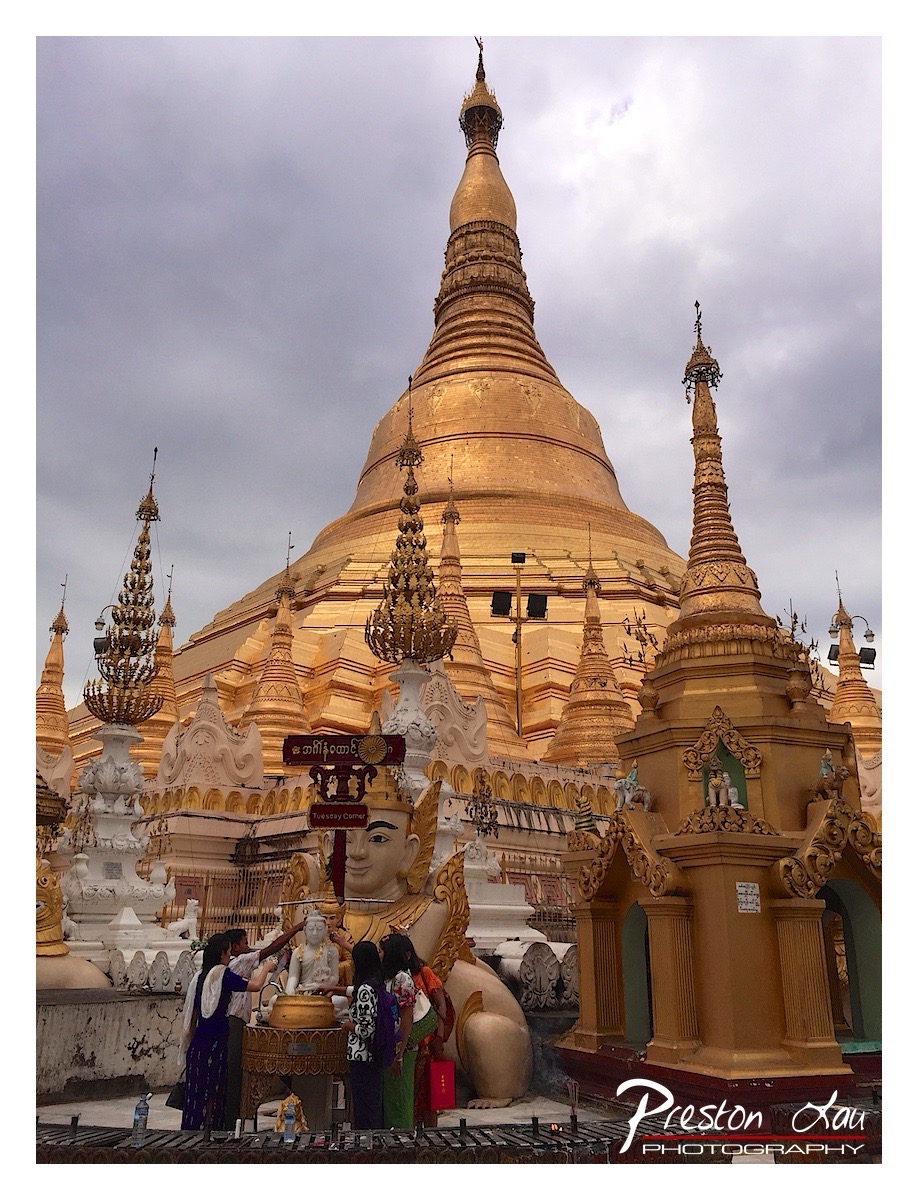

1. Overall Rating (0–10) — 7.5
This photograph captures the grandeur and spiritual resonance of a golden pagoda under a brooding sky, where light and shadow play across its intricate tiers. The composition balances the monumental scale of the stupa with human devotion, grounding the scene in lived ritual. While the image is rich in cultural detail and emotional depth, the overcast lighting slightly dampens the vibrancy of the gold, holding back its full visual impact.
2. Composition (0–10) — 7.0
The low-angle framing emphasizes the towering presence of the pagoda, while the placement of the worshippers in the foreground provides a sense of scale and narrative. The ornate elements on the right and left create a natural frame, though the central figure of the large face and the “Tuesday Corner” sign introduce a slight visual clutter that slightly disrupts the symmetry.
3. Lighting (0–10) — 6.5
Diffused light from the overcast sky softens shadows and evenly illuminates the golden surfaces, preserving detail. However, the lack of direct sunlight diminishes the warmth and reflective brilliance of the gold, resulting in a somewhat muted luminosity.
4. Color & Tone (0–10) — 7.0
The dominant gold tones are rich and harmonious, complemented by the deep shadows and the off-white of the architectural accents. The cool gray of the sky creates a subtle contrast that enhances the golden hues, though the overall palette leans toward a subdued warmth.
5. Creativity (0–10) — 8.0
The photograph successfully blends architectural grandeur with human interaction, telling a story of devotion and cultural continuity. The inclusion of the “Tuesday Corner” sign adds a touch of local authenticity, making the image feel both personal and universal.
6. Technical Quality (0–10) — 8.0
The image is sharp and well-focused, with clear detail visible in both the foreground and background. The exposure is balanced, avoiding harsh highlights or lost shadows, and the watermark is discreetly placed in the corner.
7. Emotional Impact (0–10) — 8.0
There’s a palpable sense of reverence and continuity in the scene—the quiet devotion of the worshippers against the vast, timeless backdrop of the pagoda evokes awe and introspection. The mood is contemplative, drawing the viewer into a moment of spiritual stillness.
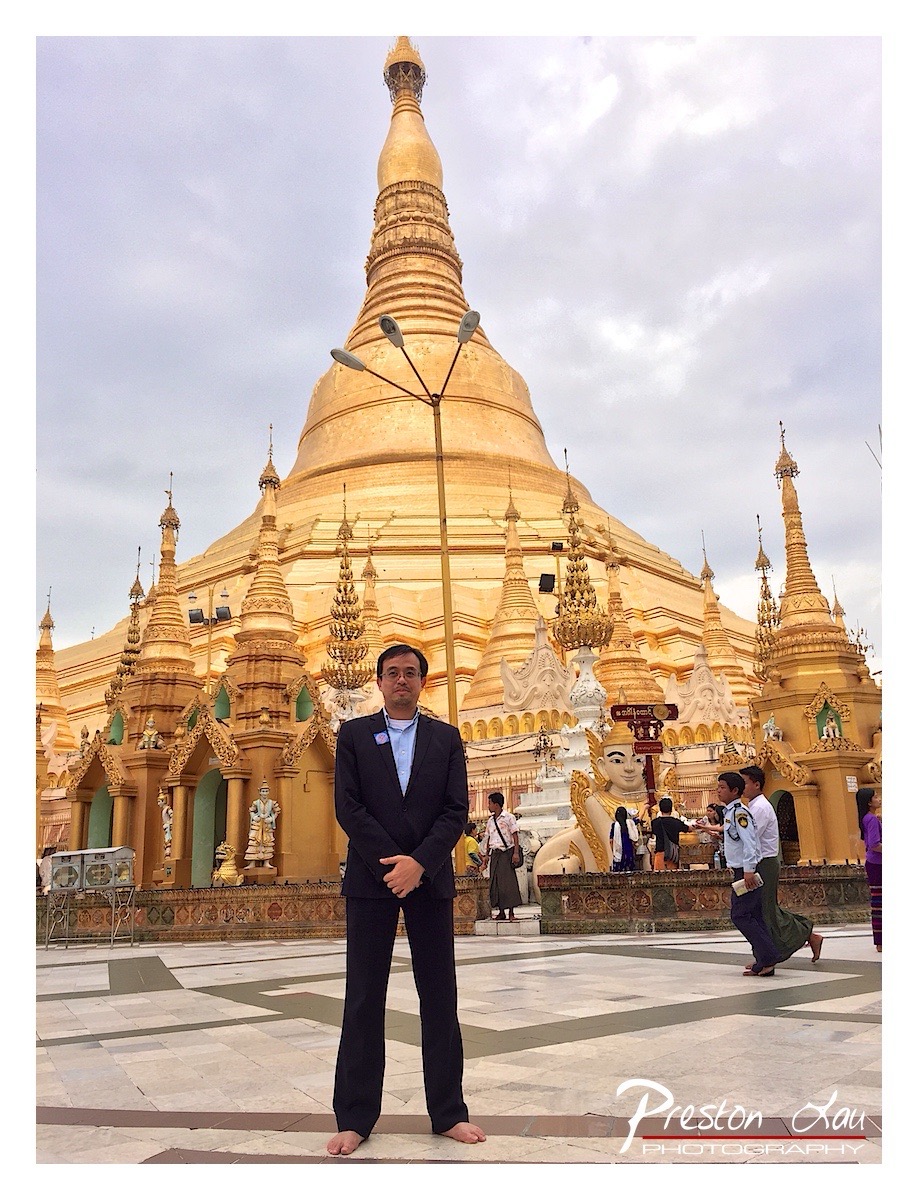

1. Overall Rating (0–10) — 7.0
This photograph captures the grandeur of the Shwedagon Pagoda with striking visual presence, where the golden spire dominates the frame and reflects a sense of reverence and cultural richness. The subject stands poised in the foreground, grounding the image in personal experience, though the composition’s slight imbalance and cluttered background detract from its elegance. While the image succeeds as a travel memento, its artistic cohesion is limited by a lack of refined framing and visual hierarchy.
2. Composition (0–10) — 6.0
The central placement of the subject disrupts the symmetry of the pagoda, while the intrusive lamppost and surrounding visitors create visual distractions. A tighter crop would better emphasize the architectural majesty.
3. Lighting (0–10) — 6.5
Diffuse daylight under an overcast sky softens shadows and evenly illuminates the golden surfaces, preserving detail without harsh contrast. However, the lack of directional light reduces the sense of depth and drama.
4. Color & Tone (0–10) — 7.5
The rich gold of the pagoda contrasts beautifully with the muted sky and stone pavement, creating a warm, harmonious palette. The slight coolness of the tones adds a contemplative mood, though the colors feel slightly oversaturated.
5. Creativity (0–10) — 6.5
The image effectively blends personal narrative with cultural iconography, but the approach remains conventional—more documentary than imaginative. The composition leans on familiarity rather than reinterpretation.
6. Technical Quality (0–10) — 7.5
The image is sharp and clear, with well-controlled exposure and clean detail throughout. The watermark is unobtrusive, and the focus is accurately placed on the subject and structure.
7. Emotional Impact (0–10) — 6.5
The photograph evokes a sense of awe and personal significance, capturing a moment of pilgrimage and connection. However, the emotional resonance is tempered by the visual clutter and lack of compositional focus.
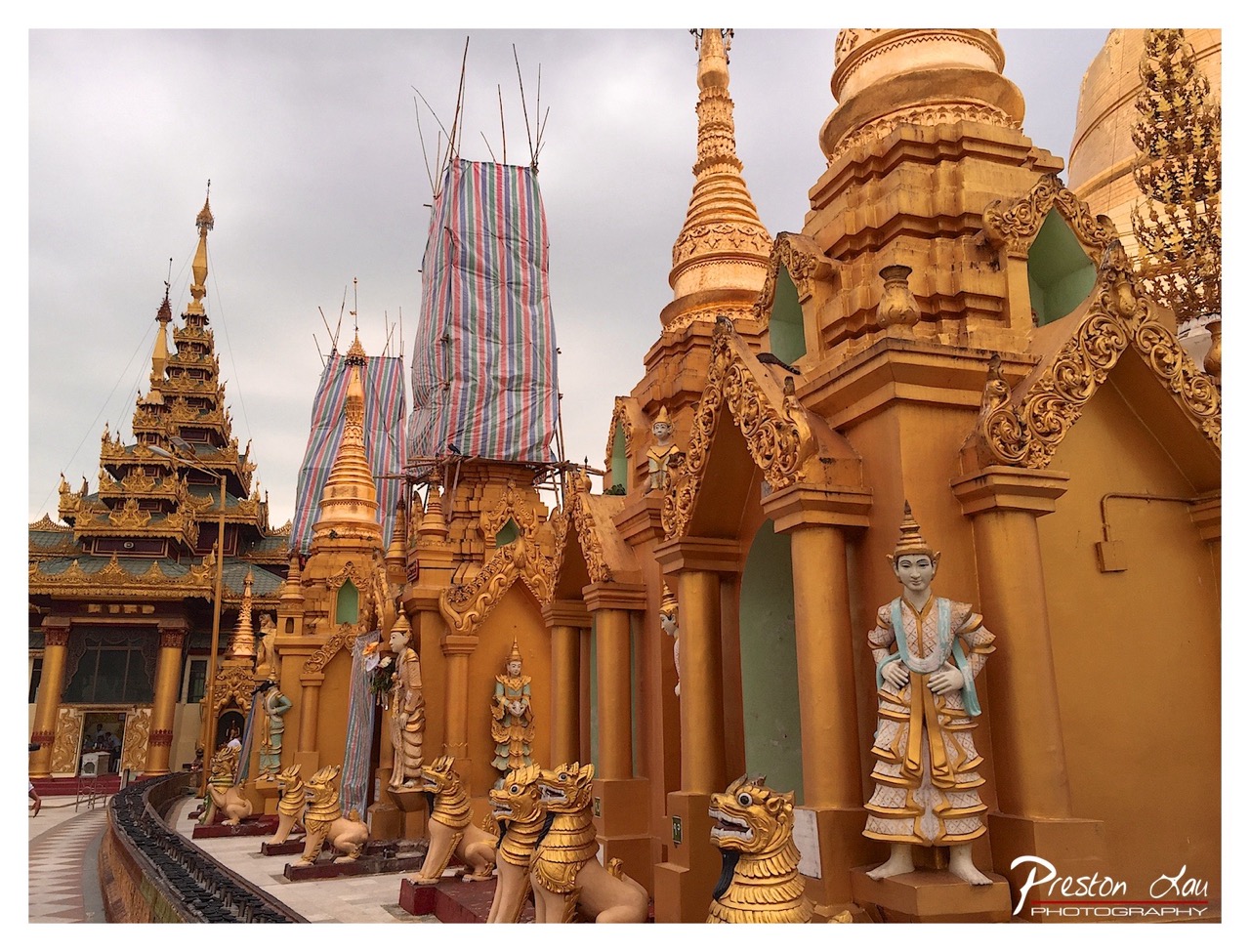

1. Overall Rating (0–10) — 7.0
This photograph captures the intricate grandeur of a Burmese temple complex, where golden spires and ornate statuary evoke a sense of spiritual reverence. The juxtaposition of gleaming religious architecture with temporary construction materials—like the striped tarp—adds a layer of authenticity, grounding the sacred in the everyday. While the image is visually rich, its slightly cluttered composition and overcast lighting temper its overall impact, preventing it from feeling fully cohesive.
2. Composition (0–10) — 6.5
The framing includes a wide array of architectural elements, creating a sense of depth and scale, though the placement of the covered spire on the left disrupts visual balance. The statues in the foreground provide grounding, but the composition feels slightly overloaded, with too many competing focal points.
3. Lighting (0–10) — 5.5
The overcast sky produces soft, diffused light that evenly illuminates the scene, minimizing harsh shadows. However, the lack of strong directional light diminishes the golden textures' brilliance, giving the image a muted tone that underplays the site’s inherent radiance.
4. Color & Tone (0–10) — 6.5
The dominant gold tones are warm and rich, effectively conveying the temple’s opulence. The muted background sky and the occasional blue and red in the tarp introduce subtle contrast, but the overall palette lacks vibrancy, partly due to the flat lighting.
5. Creativity (0–10) — 7.0
The photograph successfully blends the sacred with the mundane by including signs of ongoing construction. This narrative layer adds depth and context, transforming a typical travel photo into a more contemplative document of cultural continuity and renewal.
6. Technical Quality (0–10) — 7.5
The image is sharp and well-focused, with clear detail visible in the carvings and statues. The exposure is balanced, and the dynamic range handles the highlights and shadows reasonably well, despite the overcast conditions.
7. Emotional Impact (0–10) — 6.0
While the image conveys reverence and cultural richness, the lack of dramatic lighting and the visual clutter slightly distance the viewer from an emotional connection. The sense of awe is present but not fully realized.
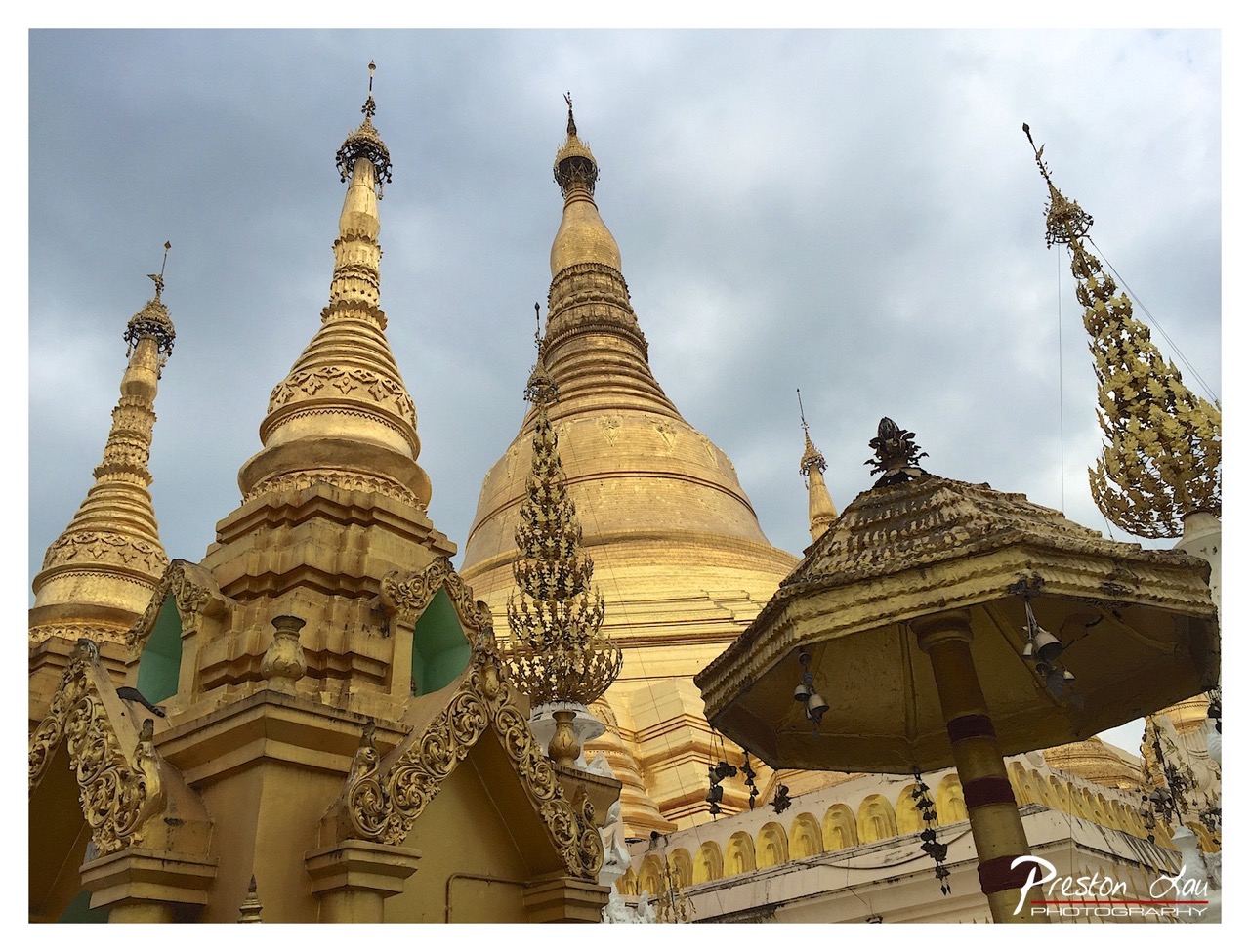

1. Overall Rating (0–10) — 7.5
This photograph captures the majestic grandeur of a golden temple complex, where intricate architecture rises toward a brooding sky. The rich gold tones and layered spires convey a sense of spiritual reverence and cultural depth, though the overcast lighting tempers the radiance of the gilded surfaces. The image succeeds in communicating the awe-inspiring scale of the site, though a more dynamic sky or golden hour light could elevate its emotional resonance.
2. Composition (0–10) — 8.0
The low-angle perspective emphasizes the towering spires, creating a sense of verticality and reverence. The arrangement of domes and ornate structures guides the eye upward, with the foreground pavilion adding depth and framing the central stupa effectively.
3. Lighting (0–10) — 6.0
The overcast sky diffuses the light evenly, minimizing harsh shadows and allowing details in the goldwork to remain visible. However, the flat, gray lighting diminishes the luminosity of the golden surfaces, muting the warmth and brilliance one might expect from such a site.
4. Color & Tone (0–10) — 7.0
The dominant golden hues are rich and consistent, complemented by subtle green accents and the muted gray of the sky. The contrast between the warm gold and cool backdrop creates visual interest, though the overall tone leans slightly desaturated.
5. Creativity (0–10) — 7.0
The image presents a familiar subject with a compelling architectural focus, emphasizing texture and form. The photographer’s choice of angle and framing adds a sense of reverence, but the composition remains relatively conventional in its storytelling.
6. Technical Quality (0–10) — 8.0
Sharp focus and clear detail across the frame highlight the ornate carvings and layered structures. The exposure is balanced, with no significant over- or underexposed areas, and the watermark is discreetly placed.
7. Emotional Impact (0–10) — 7.0
The image evokes a sense of peace and spiritual elevation, inviting the viewer to contemplate the cultural and religious significance of the site. While the overcast sky tempers the emotional intensity, the architectural splendor still commands awe and reverence.
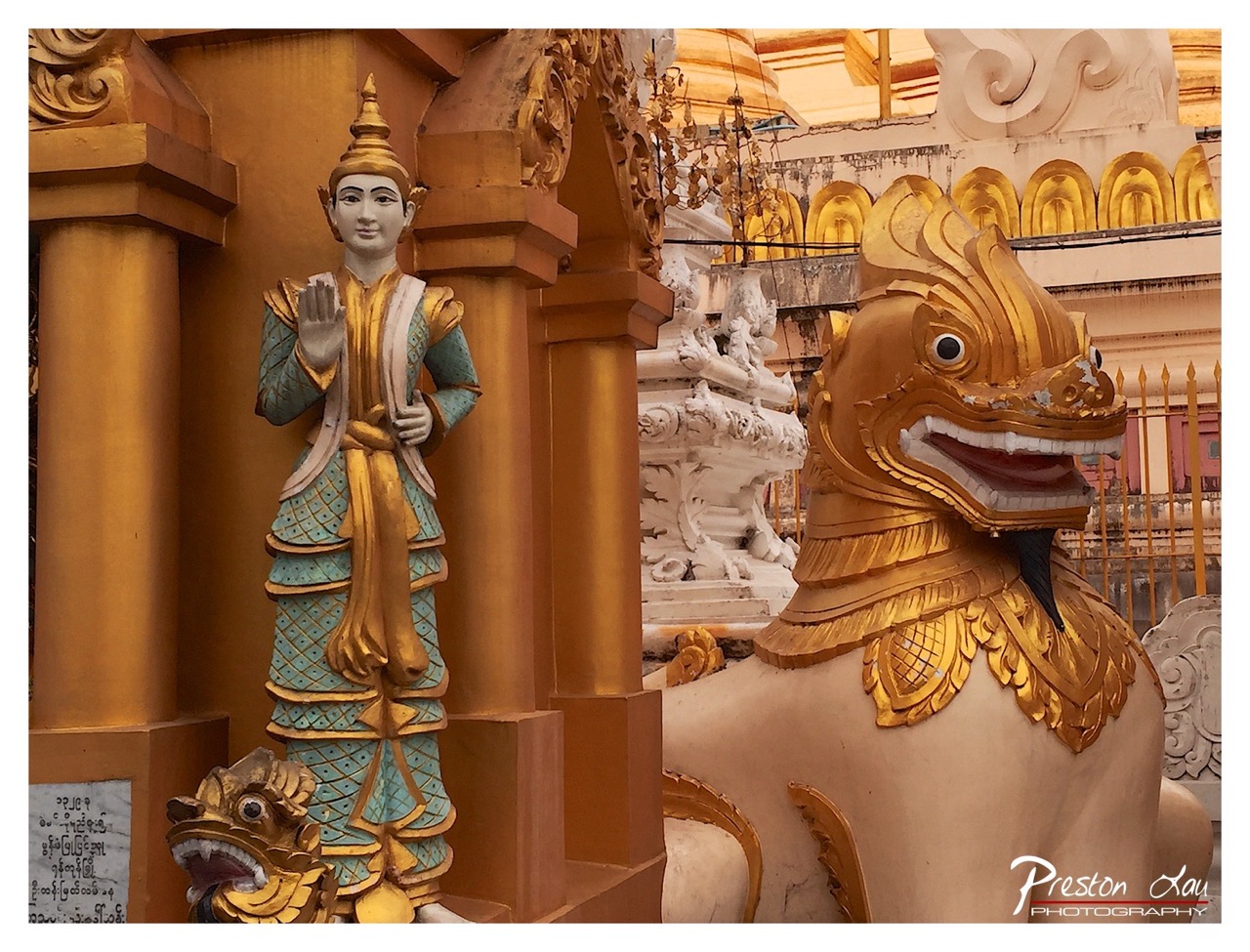

1. Overall Rating (0–10) — 7.5
This photograph captures the ornate grandeur of a Southeast Asian temple, where vibrant gold and turquoise hues evoke a sense of sacred tradition and cultural richness. The interplay between the serene human figure and the fierce mythical guardian creates a compelling narrative of protection and reverence. While the image is rich in detail and symbolism, a slightly more balanced composition and refined lighting could elevate its visual impact to the level of a masterful cultural portrait.
2. Composition (0–10) — 7.0
The framing emphasizes the contrast between the standing figure and the mythical creature, creating a dynamic visual dialogue. However, the right side of the frame feels slightly crowded, and the inclusion of the lower-left plaque, while informative, disrupts the visual flow.
3. Lighting (0–10) — 7.5
The warm, golden light enhances the metallic sheen of the statues and contributes to a reverent atmosphere. The soft shadows add depth without obscuring details, though the highlights on the gold accents are slightly overexposed.
4. Color & Tone (0–10) — 8.0
The rich palette of gold, turquoise, and white creates a harmonious and culturally resonant color scheme. The warm tones enhance the sacred feel, and the contrast between the figures and the background is visually striking.
5. Creativity (0–10) — 8.0
The juxtaposition of the human figure and the mythical creature suggests a narrative of spiritual guardianship, lending the image a sense of storytelling and cultural depth. The photographer’s choice to include both elements in a single frame demonstrates thoughtful composition and intent.
6. Technical Quality (0–10) — 8.0
The image is sharp and well-focused, with fine detail visible in the textures of the statues and carvings. The exposure is generally well-managed, though some areas of the gold finish show slight overexposure.
7. Emotional Impact (0–10) — 7.5
The photograph evokes a sense of awe and respect for tradition, inviting the viewer to contemplate the spiritual and cultural significance of the scene. The presence of the human figure adds a humanizing element, bridging the gap between the sacred and the observer.
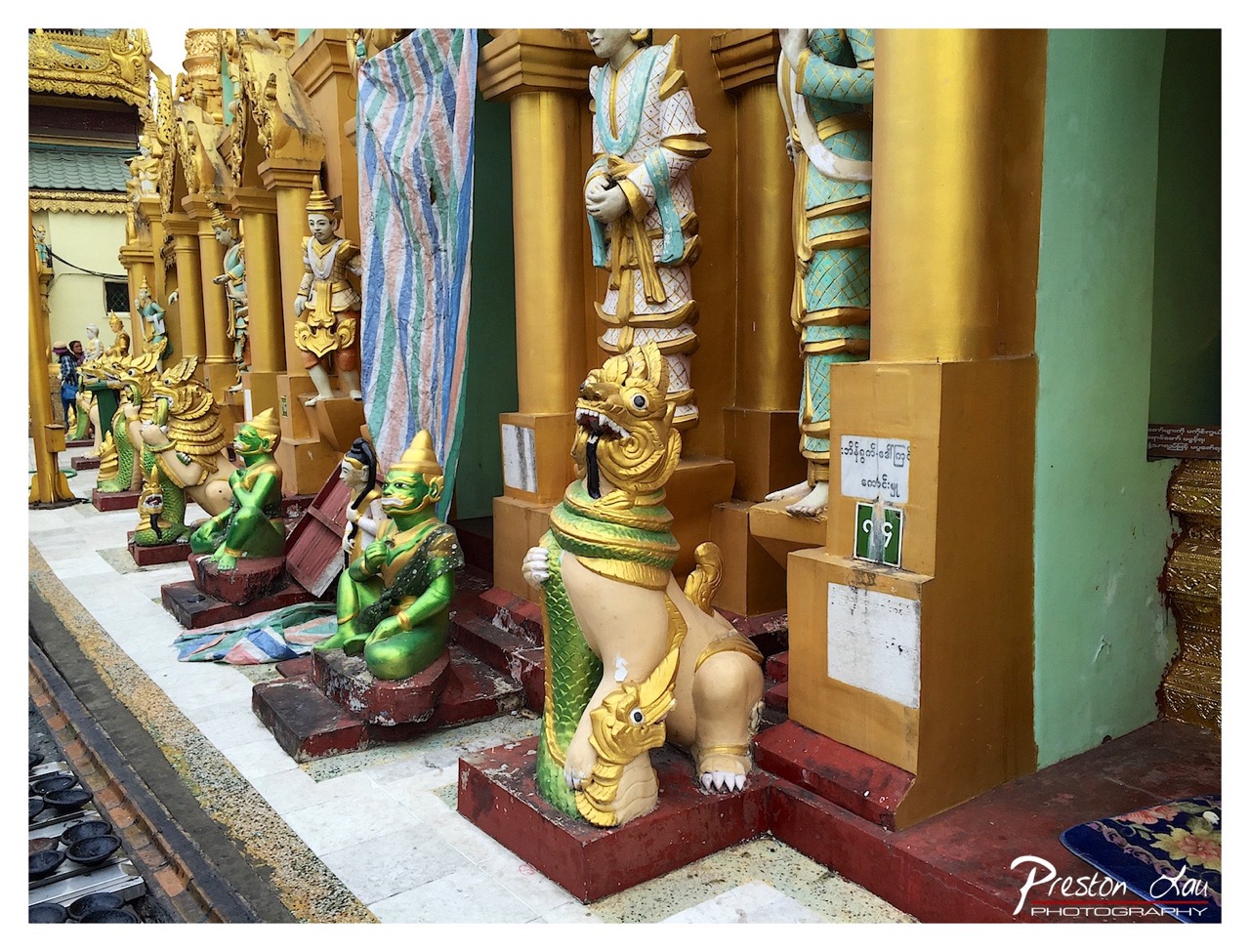

1. Overall Rating (0–10) — 7.0
This photograph captures the vibrant, layered spirituality of a Burmese temple complex, where mythic guardians and ornate pillars stand in quiet reverence. The rich golds and greens convey a sense of devotion and cultural depth, though the cluttered arrangement and busy background slightly dilute the visual focus. The image succeeds as a cultural document, balancing authenticity with aesthetic appeal.
2. Composition (0–10) — 6.0
The diagonal line of statues leads the eye through the frame, but the inclusion of background elements like the hanging cloth and distant figures creates visual distraction. A tighter crop would enhance clarity and focus on the central figures.
3. Lighting (0–10) — 6.5
Natural daylight provides even illumination, preserving the details and textures of the painted statues. However, the lighting is somewhat flat, lacking the dramatic contrast that could heighten the spiritual atmosphere.
4. Color & Tone (0–10) — 7.5
The bold golds, emerald greens, and deep reds create a striking, harmonious palette that reflects the temple’s ceremonial richness. The tones are vibrant yet balanced, giving the scene a lively, almost theatrical quality.
5. Creativity (0–10) — 7.0
The image presents a compelling narrative of religious tradition and iconography, capturing both the sacred and the everyday. While not highly experimental, it offers a fresh perspective on a familiar cultural landscape.
6. Technical Quality (0–10) — 8.0
Sharp focus and clean detail allow the textures of the painted surfaces and stone bases to be clearly visible. The exposure is well-balanced, with no significant overexposed or underexposed areas.
7. Emotional Impact (0–10) — 6.5
The viewer is drawn into a moment of quiet reverence, evoking a sense of awe and cultural curiosity. The presence of human figures in the distance adds a subtle layer of lived spirituality, though the emotional resonance is tempered by the visual clutter.
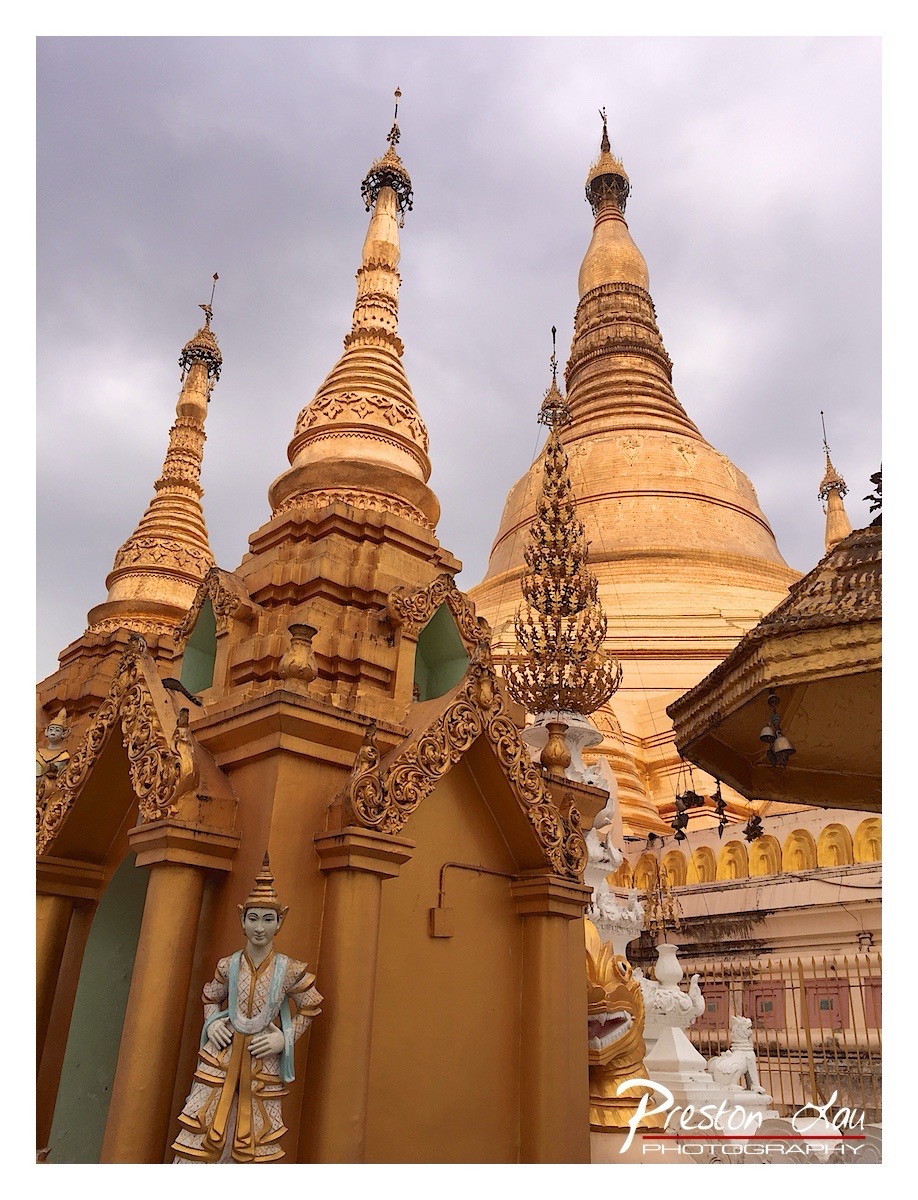

1. Overall Rating (0–10) — 7.5
This photograph captures the grandeur and spiritual resonance of a Burmese pagoda complex, with its golden spires reaching toward a moody, overcast sky. The intricate carvings and layered architecture convey a sense of devotion and cultural richness, while the contrast between the warm gold and the cool gray clouds adds dramatic tension. Though the composition feels slightly crowded, the image succeeds in evoking reverence and wonder, inviting the viewer into a sacred space.
2. Composition (0–10) — 7.0
The low-angle perspective emphasizes the towering height of the stupas, creating a sense of awe. However, the inclusion of the foreground statue and architectural elements introduces visual clutter, slightly disrupting the balance and drawing attention away from the main spires.
3. Lighting (0–10) — 6.5
The overcast sky provides soft, diffused light that evenly illuminates the golden surfaces without harsh shadows. While this enhances texture and detail, the lack of directional sunlight reduces the depth and warmth that might have heightened the scene’s spiritual glow.
4. Color & Tone (0–10) — 7.5
The warm golds of the pagodas stand out vividly against the muted grays and soft whites of the sky, creating a harmonious yet striking contrast. The subtle hints of turquoise and white in the details add visual interest, while the overall tone remains cohesive and culturally evocative.
5. Creativity (0–10) — 7.0
The choice to capture the temple complex from a low angle with a slightly tilted frame adds dynamism and a sense of movement. The inclusion of cultural elements like the statue and ornate railings grounds the image in authenticity, though the composition could benefit from greater simplification to enhance focus.
6. Technical Quality (0–10) — 8.0
The image is sharp and well-focused, with clear detail visible in the intricate carvings and spires. The exposure is balanced, and the resolution captures the textures of the golden surfaces effectively. The watermark is unobtrusive and professionally placed.
7. Emotional Impact (0–10) — 8.0
The photograph evokes a deep sense of reverence and tranquility, enhanced by the quiet solemnity of the overcast sky and the sacred architecture. The viewer is drawn into the spiritual atmosphere, feeling a moment of stillness and reflection amidst the grandeur of the temple.
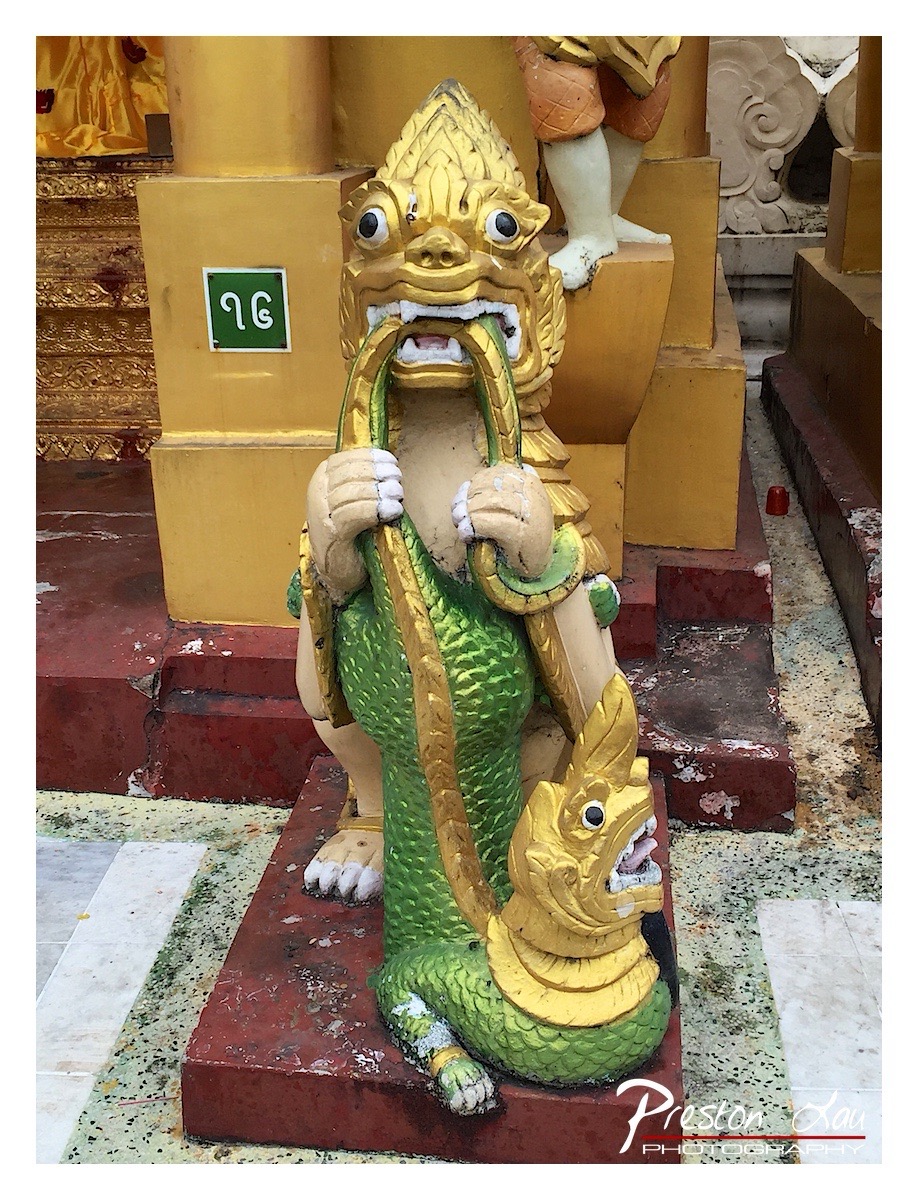

1. Overall Rating (0–10) — 7.0
This photograph captures the vibrant mythology of a Southeast Asian temple, where the golden naga guardian stands as both protector and symbol. The rich textures and bold colors of the statue create an immediate sense of cultural depth, while the slightly weathered surface adds authenticity. Though the background clutter slightly dilutes the focus, the image successfully conveys the spiritual and artistic essence of the site—its strength lies in its storytelling rather than compositional perfection.
2. Composition (0–10) — 6.0
The statue is centered and well-framed, but the surrounding architectural elements and debris create visual noise. A tighter crop would isolate the subject and enhance clarity.
3. Lighting (0–10) — 6.5
Natural daylight provides even illumination, highlighting the golden and green tones without harsh shadows. The lighting is functional but lacks the dramatic contrast that could elevate the mood.
4. Color & Tone (0–10) — 7.5
The interplay of gold, green, and red creates a striking, culturally resonant palette. The saturation enhances the iconography, though the overall tone is slightly flat due to the bright, overcast light.
5. Creativity (0–10) — 7.0
The image presents a familiar cultural motif with clarity and respect. While not highly original in concept, it effectively captures the spirit of the subject, inviting viewers into a moment of quiet reverence.
6. Technical Quality (0–10) — 7.5
The focus is sharp on the statue, and detail is well-preserved. The watermark is unobtrusive, and the image is free of major technical flaws.
7. Emotional Impact (0–10) — 6.5
The image evokes a sense of awe and curiosity, inviting the viewer to contemplate the symbolism of the naga. However, the lack of atmospheric depth and emotional contrast keeps the experience more observational than immersive.
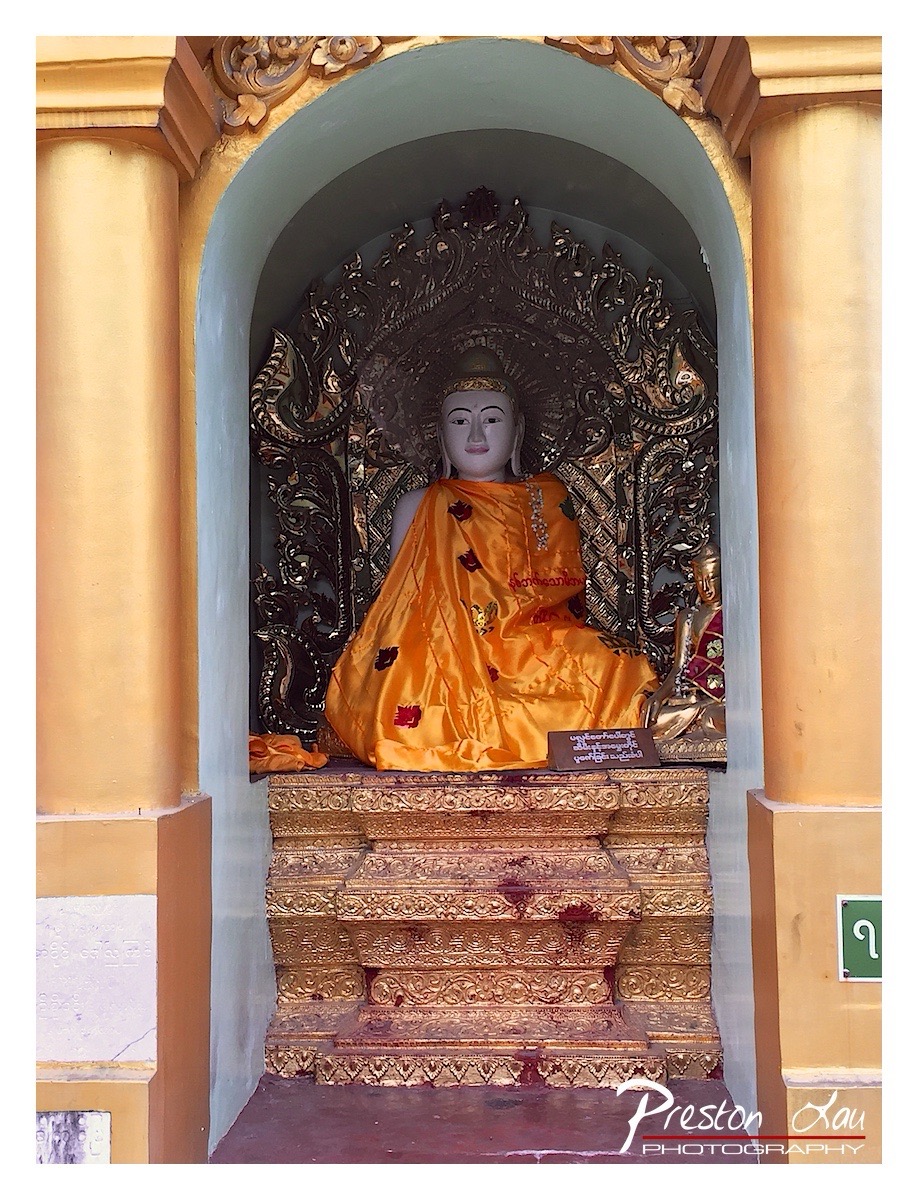

1. Overall Rating (0–10) — 7.0
This photograph captures the serene reverence of a Buddhist shrine, where the golden radiance of the statue and its ornate setting evoke a sense of spiritual devotion. The rich textures and warm tones enhance the sacred atmosphere, though the composition feels slightly constrained by the framing and the presence of a watermark. With a more intentional focus and subtle tonal refinement, the image could achieve greater visual harmony and emotional depth.
2. Composition (0–10) — 6.5
The subject is centered within the arch, creating a balanced and reverent focal point, but the tight framing and visible borders limit the sense of space. The inclusion of the photographer’s watermark and a small sign slightly disrupts the visual purity of the shrine.
3. Lighting (0–10) — 7.0
The lighting is even and soft, highlighting the golden details of the statue and surrounding architecture without harsh shadows. The warm, ambient light enhances the richness of the orange robe and metallic embellishments, contributing to the image’s spiritual mood.
4. Color & Tone (0–10) — 7.5
The dominant gold and orange hues create a warm, harmonious palette that reflects the sacred nature of the scene. The contrast between the bright silk robe and the darker, intricately carved backdrop adds visual depth, while the muted gray of the arch frames the subject effectively.
5. Creativity (0–10) — 6.5
The image successfully captures a culturally rich moment with a strong sense of place, but the approach remains largely documentary. The creative potential lies in the details—the texture of the robe, the symmetry of the arch—but the execution stays within conventional boundaries of religious photography.
6. Technical Quality (0–10) — 8.0
The image is sharp and well-focused, with clear details in the statue’s face, fabric, and ornate carvings. The exposure is well-managed, preserving highlights and shadows, though the watermark and edge cropping slightly detract from the overall refinement.
7. Emotional Impact (0–10) — 7.0
There is a quiet dignity and tranquility in the scene, inviting contemplation and respect. The stillness of the Buddha figure and the devotion implied by the offerings evoke a sense of peace, though the emotional resonance is slightly tempered by the image’s more literal, less interpretive approach.
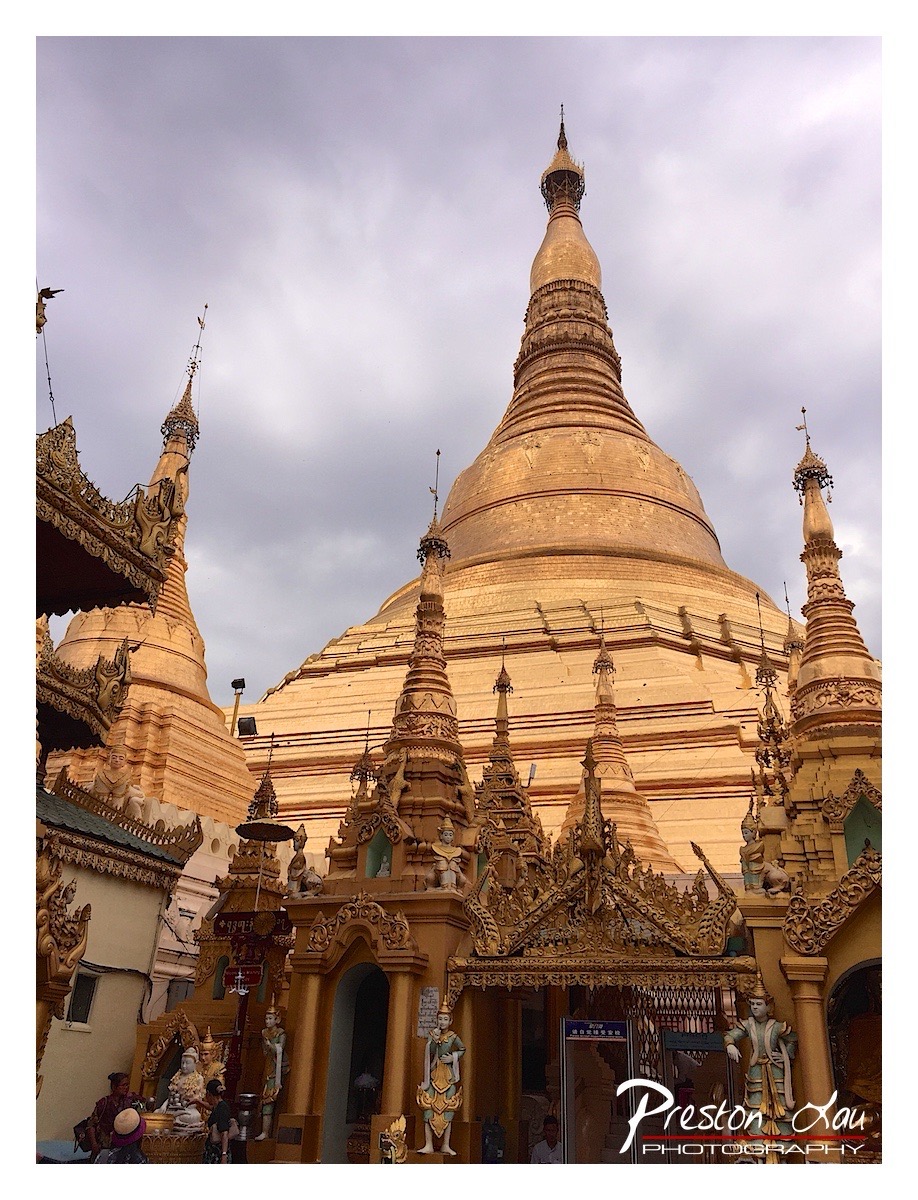

1. Overall Rating (0–10) — 7.5
This photograph captures the majestic presence of the Shwedagon Pagoda with a sense of reverence and grandeur, where the golden spire rises like a beacon against the overcast sky. The low-angle perspective emphasizes the monument’s scale and spiritual significance, while the intricate details of the surrounding architecture add layers of cultural richness. Though the cloudy sky tempers the golden glow, the image succeeds in conveying both the awe-inspiring beauty and the living sacredness of the site.
2. Composition (0–10) — 8.0
The low-angle framing enhances the pagoda’s verticality, drawing the eye upward toward the central stupa. The surrounding spires and ornate structures create a balanced, layered composition that frames the main dome effectively, though the left-side clutter slightly distracts from the visual harmony.
3. Lighting (0–10) — 6.5
Diffuse, overcast light softens the scene, reducing harsh shadows and allowing the golden surfaces to reflect light evenly. While this creates a serene, contemplative mood, it also dampens the brilliance of the gold, preventing the image from truly glowing with warmth and radiance.
4. Color & Tone (0–10) — 7.0
The warm golden tones of the pagoda stand out vividly against the muted grays of the sky, creating a strong contrast that draws attention to the architecture. The tonal range is well-balanced, with the gold hues lending a sense of richness and spiritual warmth, though the overall saturation could be slightly enhanced to amplify the visual impact.
5. Creativity (0–10) — 7.5
The photographer’s choice to capture the pagoda from a low, upward-looking angle imbues the image with a sense of reverence and awe. The inclusion of visitors and architectural details adds narrative depth, transforming the image from a mere architectural record into a cultural portrait.
6. Technical Quality (0–10) — 8.0
The image is sharp and detailed, with clear focus on the central stupa and surrounding elements. The exposure is well-managed, avoiding blown highlights or deep shadows, and the watermark is unobtrusive, preserving the integrity of the composition.
7. Emotional Impact (0–10) — 8.0
The photograph evokes a profound sense of peace and spiritual wonder, inviting the viewer to feel the weight of centuries of devotion. The scale and symmetry of the pagoda, combined with the quiet presence of worshippers, create a powerful emotional resonance that transcends mere visual beauty.
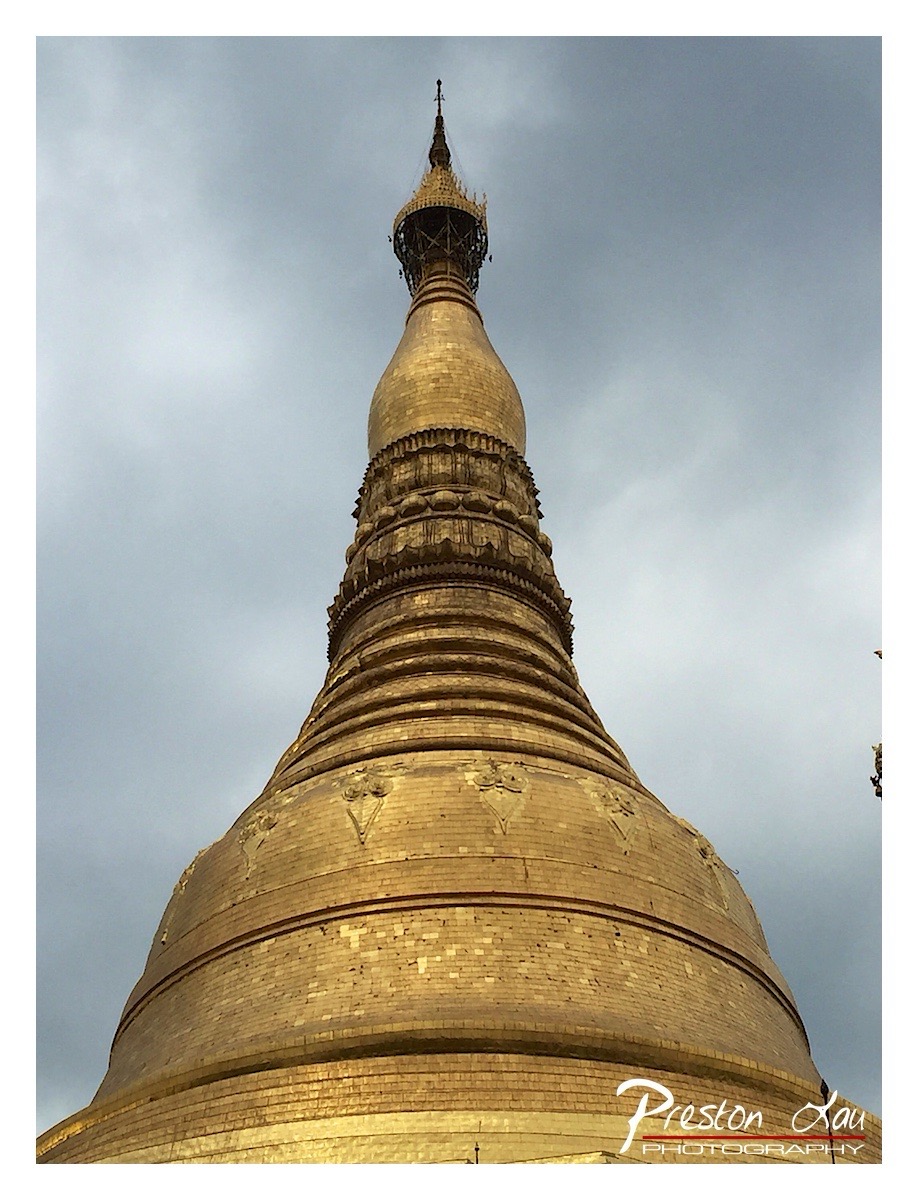

1. Overall Rating (0–10) — 7.5
This photograph captures the majestic grandeur of a golden stupa, its upward sweep evoking spiritual aspiration and cultural reverence. The low-angle perspective emphasizes the structure’s towering presence against a moody, overcast sky, creating a powerful sense of awe. While the image is strong in mood and composition, the muted lighting slightly dampens the brilliance of the gold, preventing it from fully radiating its intended luminosity.
2. Composition (0–10) — 8.0
The low-angle, centered framing draws the eye upward along the stupa’s elegant curve, creating a strong sense of verticality and balance. The subtle asymmetry of the sky and the framing of the spire enhances visual interest without disrupting harmony.
3. Lighting (0–10) — 6.0
The overcast sky provides soft, diffused light that minimizes harsh shadows and highlights the texture of the golden surface. However, the lack of direct sunlight tempers the warmth and reflective quality of the gold, resulting in a somewhat subdued glow.
4. Color & Tone (0–10) — 7.0
The dominant golden tones of the stupa contrast beautifully with the cool, gray-blue sky, creating a balanced and harmonious palette. The tonal range is well-managed, with a subtle warmth in the gold that enhances its spiritual resonance.
5. Creativity (0–10) — 8.0
The choice to photograph the stupa from a low angle under a brooding sky transforms a familiar architectural subject into a contemplative and reverent image. The interplay between light, texture, and scale demonstrates thoughtful artistic intent.
6. Technical Quality (0–10) — 8.0
The image is sharp and clear, with fine detail visible in the stupa’s tiered structure and ornamental elements. The focus is precise, and the exposure is well-balanced, preserving detail in both the highlights and shadows.
7. Emotional Impact (0–10) — 8.0
The photograph evokes a sense of reverence and quiet contemplation, inviting the viewer to feel the spiritual weight and cultural significance of the stupa. The mood is introspective and majestic, leaving a lasting impression of awe.
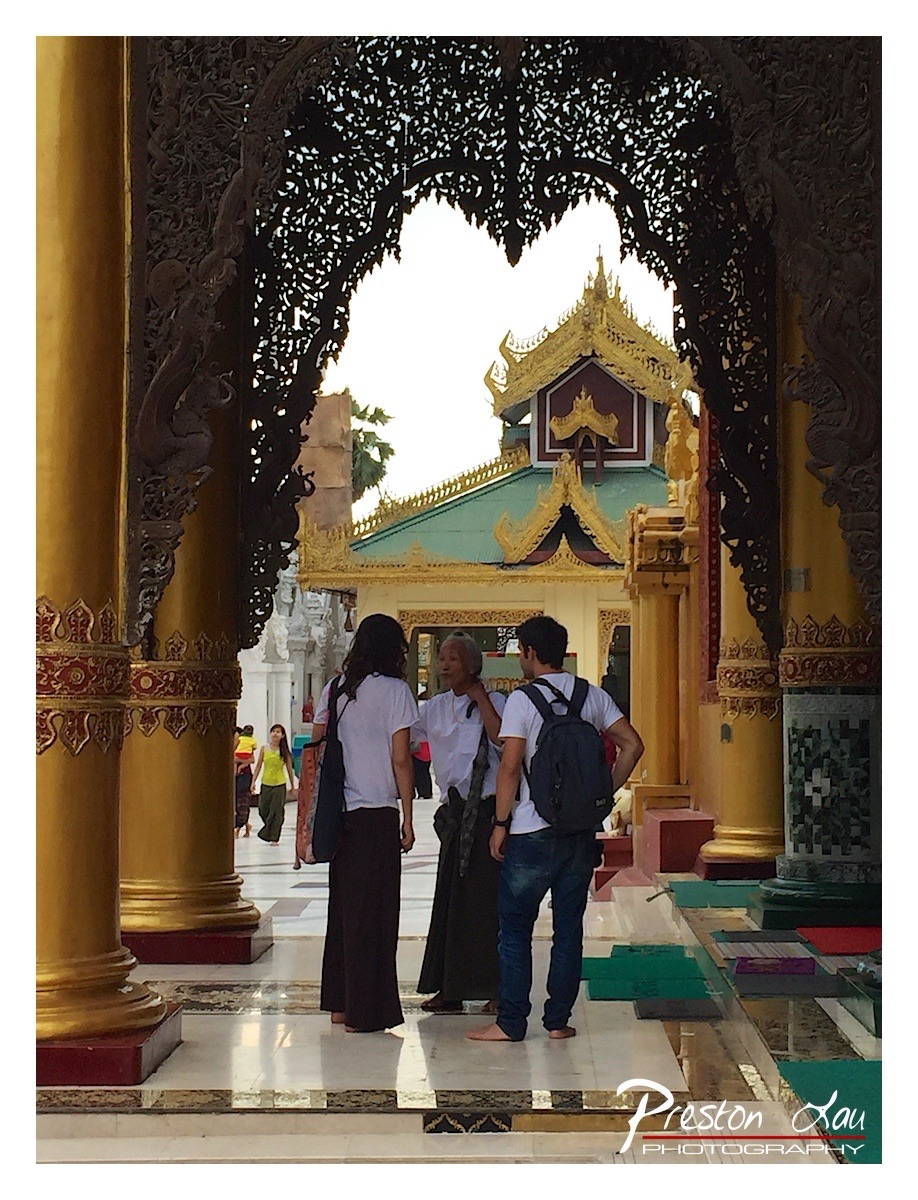

1. Overall Rating (0–10) — 7.0
This photograph captures the spiritual grandeur of a Burmese temple with a compelling sense of depth and cultural authenticity. The ornate archway frames the scene like a sacred portal, drawing the eye toward the golden pagoda beyond, while the figures in the foreground add a human scale and narrative presence. Though the composition is strong, the overexposed sky slightly undermines the mood, and the image’s potential for emotional resonance is held back by a lack of tonal subtlety.
2. Composition (0–10) — 8.0
The archway creates a natural frame that guides the viewer’s gaze into the scene, establishing a layered depth. The placement of the three figures near the center balances the composition, though the off-center pillar on the left adds visual tension that enhances the sense of realism.
3. Lighting (0–10) — 6.0
Harsh daylight causes significant overexposure in the sky, flattening the background and washing out detail on the temple’s golden roof. The interior is well-lit, but the contrast between the dark arch and the bright exterior reduces dynamic range and diminishes atmospheric depth.
4. Color & Tone (0–10) — 7.0
The rich golds and deep greens of the temple create a vibrant, culturally resonant palette. The contrast between the dark carved arch and the bright background enhances visual drama, though the overexposed sky flattens the tonal gradient and reduces the overall richness.
5. Creativity (0–10) — 7.0
The use of the arch as a framing device is both traditional and effective, evoking a sense of journey and reverence. The inclusion of contemporary visitors adds a layer of storytelling, blending the sacred with the everyday in a thoughtfully composed scene.
6. Technical Quality (0–10) — 7.5
The image is sharp and clear, with fine detail visible in the carvings and temple architecture. Focus is consistent across the frame, and the exposure is generally well-managed despite the challenging lighting conditions.
7. Emotional Impact (0–10) — 6.5
The photograph conveys a quiet reverence and sense of place, inviting the viewer to step into a moment of cultural and spiritual significance. The presence of people grounds the image in reality, but the technical limitations in lighting prevent a deeper emotional connection.
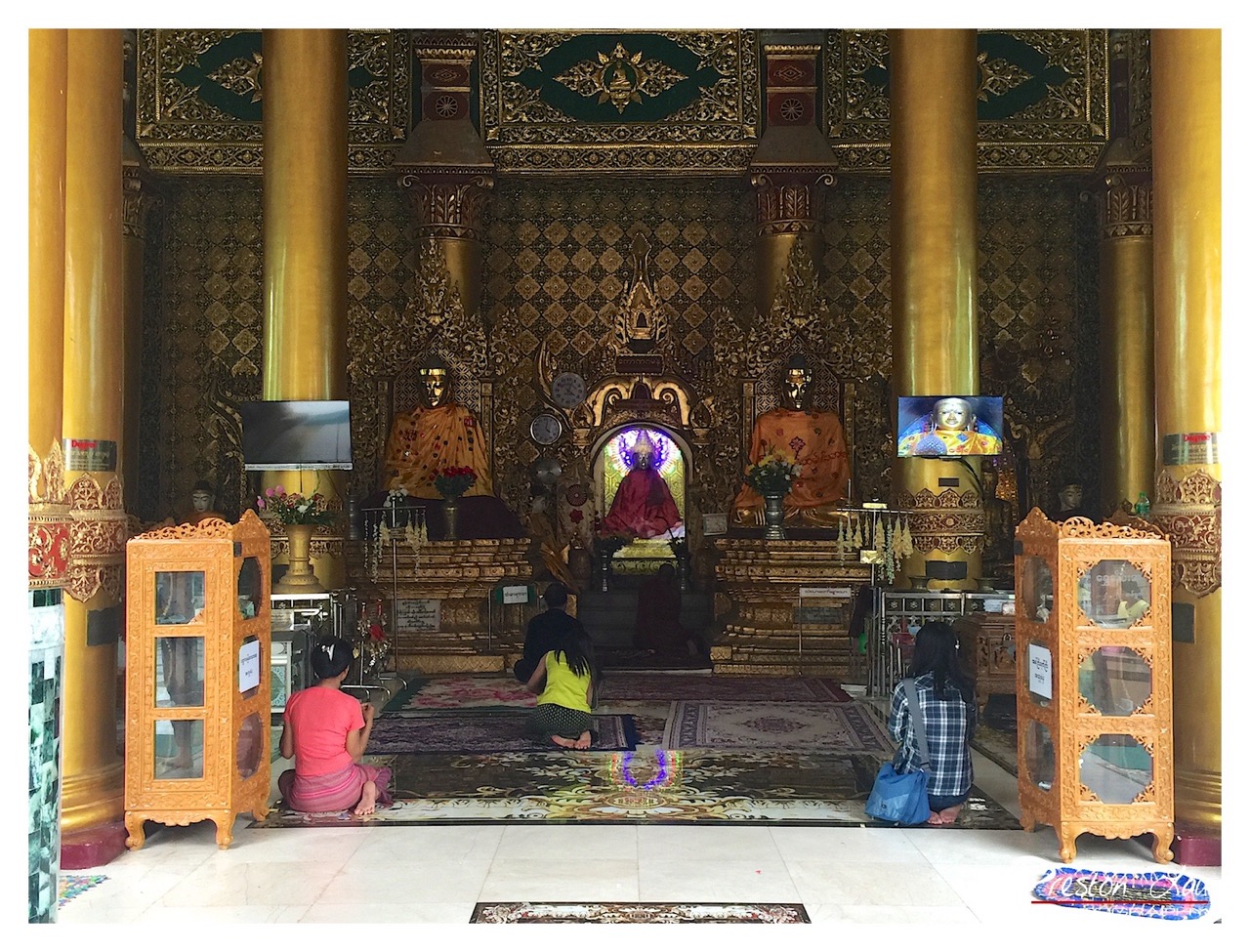

1. Overall Rating (0–10) — 7.5
This photograph captures the solemn reverence of a Buddhist shrine, where devotion unfolds amid opulent gold and intricate ornamentation. The juxtaposition of traditional religious practice with modern elements—like the small screens displaying images of the Buddha—adds a layer of cultural continuity and quiet commentary. While the image is rich in detail and atmosphere, the composition’s slight clutter and uneven lighting prevent it from achieving full visual harmony.
2. Composition (0–10) — 6.5
The central shrine is well-framed, drawing the eye through the symmetry of the golden pillars and ornate arches. However, the foreground elements—particularly the two wooden display cases and the scattered objects—create visual distractions that disrupt the sense of balance and focus.
3. Lighting (0–10) — 6.0
The lighting is mixed, with strong highlights on the gold surfaces and shadows in the recesses, creating depth but also reducing detail in the darker areas. The fluorescent glow from the screens adds an artificial contrast that feels slightly out of place in the sacred setting.
4. Color & Tone (0–10) — 7.0
The dominant gold and warm tones evoke a sense of grandeur and spiritual richness, while the pops of red, purple, and green in the religious statues add visual interest. The color palette is harmonious, though some areas appear oversaturated, especially the reflections on the polished floor.
5. Creativity (0–10) — 7.5
The image thoughtfully captures a moment of spiritual practice within a living tradition, blending reverence with modernity. The inclusion of the digital screens introduces a subtle narrative about the intersection of faith and technology, adding depth and originality.
6. Technical Quality (0–10) — 7.0
The image is sharp and clear, with fine detail visible in the carvings and textiles. The exposure is generally well-managed, though some overexposed areas on the screens and reflections reduce overall tonal range.
7. Emotional Impact (0–10) — 8.0
There is a palpable sense of peace and devotion in the posture of the worshippers, and the sacred space feels both vibrant and contemplative. The image invites the viewer to reflect on faith, tradition, and the quiet dignity of everyday spiritual life.
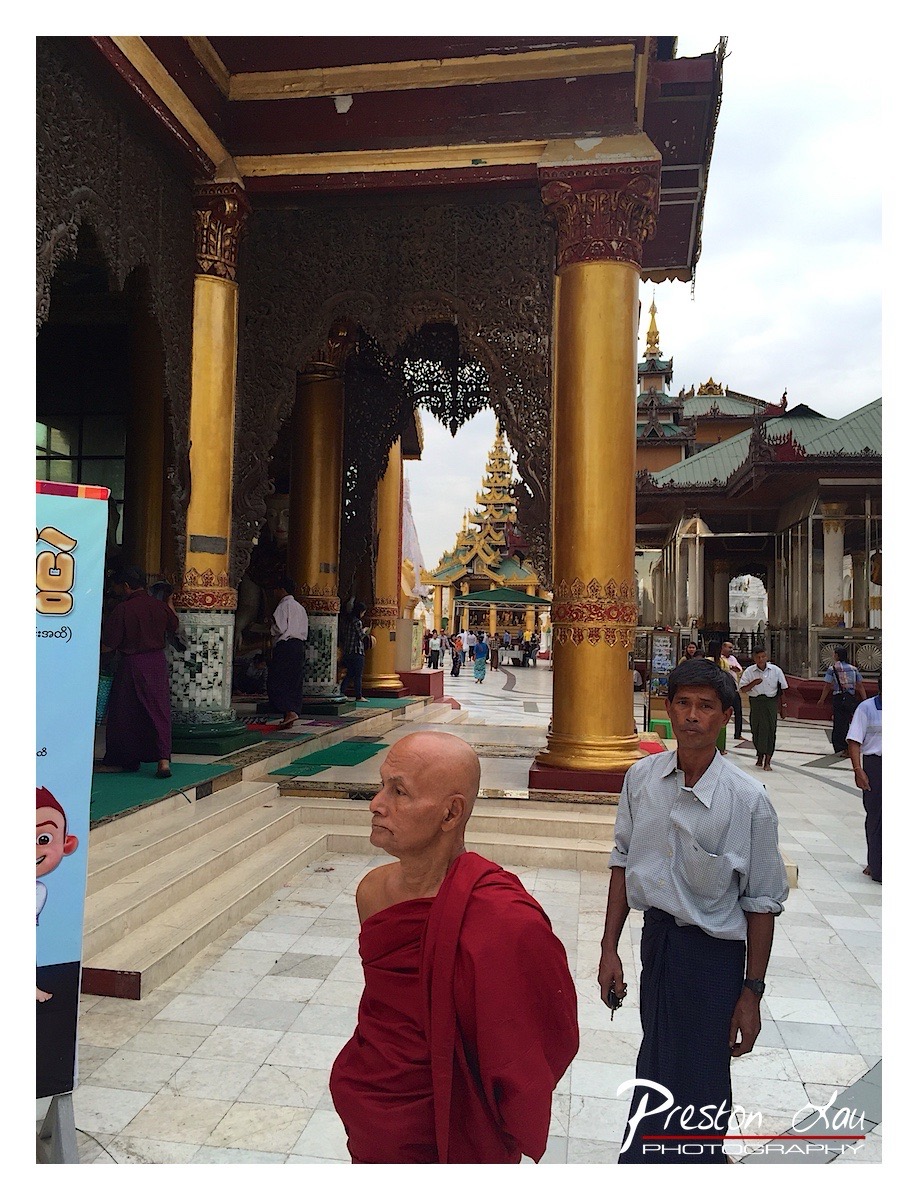

1. Overall Rating (0–10) — 7.0
This photograph captures the vibrant, layered atmosphere of a Burmese temple complex, where tradition and daily life unfold in harmony. The composition draws the viewer into a sacred space through a natural architectural frame, while the presence of the monk and devotees adds narrative depth. The image’s strength lies in its authenticity and cultural richness, though the slightly cluttered foreground and uneven lighting temper its visual cohesion.
2. Composition (0–10) — 7.0
The golden pillars and arched entryway create a strong leading line toward the central stupa, guiding the eye through the scene. The monk in the foreground provides a focal point, while the man to the right adds balance. However, the left-side sign and steps slightly disrupt the visual flow.
3. Lighting (0–10) — 6.0
Diffused daylight softens shadows and evenly illuminates the scene, preserving detail in both the bright golds and darker architectural recesses. While the lighting is functional, it lacks the dramatic contrast or golden-hour warmth that could enhance the spiritual mood.
4. Color & Tone (0–10) — 7.0
The rich red of the monk’s robe contrasts vividly with the gold and white tones of the temple, creating a visually striking palette. The overall tone is balanced, with natural colors that feel authentic, though the cool, overcast sky slightly dulls the warmth of the scene.
5. Creativity (0–10) — 7.0
The photograph succeeds in capturing a candid moment within a sacred environment, blending cultural documentation with artistic framing. The use of architectural elements as a compositional device adds a layer of storytelling, elevating it beyond a simple snapshot.
6. Technical Quality (0–10) — 7.5
Sharp focus and clear detail are evident throughout, particularly in the foreground subjects and temple columns. The exposure is well-managed, with no significant overexposed or underexposed areas, though minor noise is visible in the sky.
7. Emotional Impact (0–10) — 7.5
The image conveys a sense of reverence and quiet contemplation, enhanced by the monk’s solemn expression and the sacred setting. It invites the viewer to reflect on the continuity of faith and tradition, creating a lasting emotional resonance.
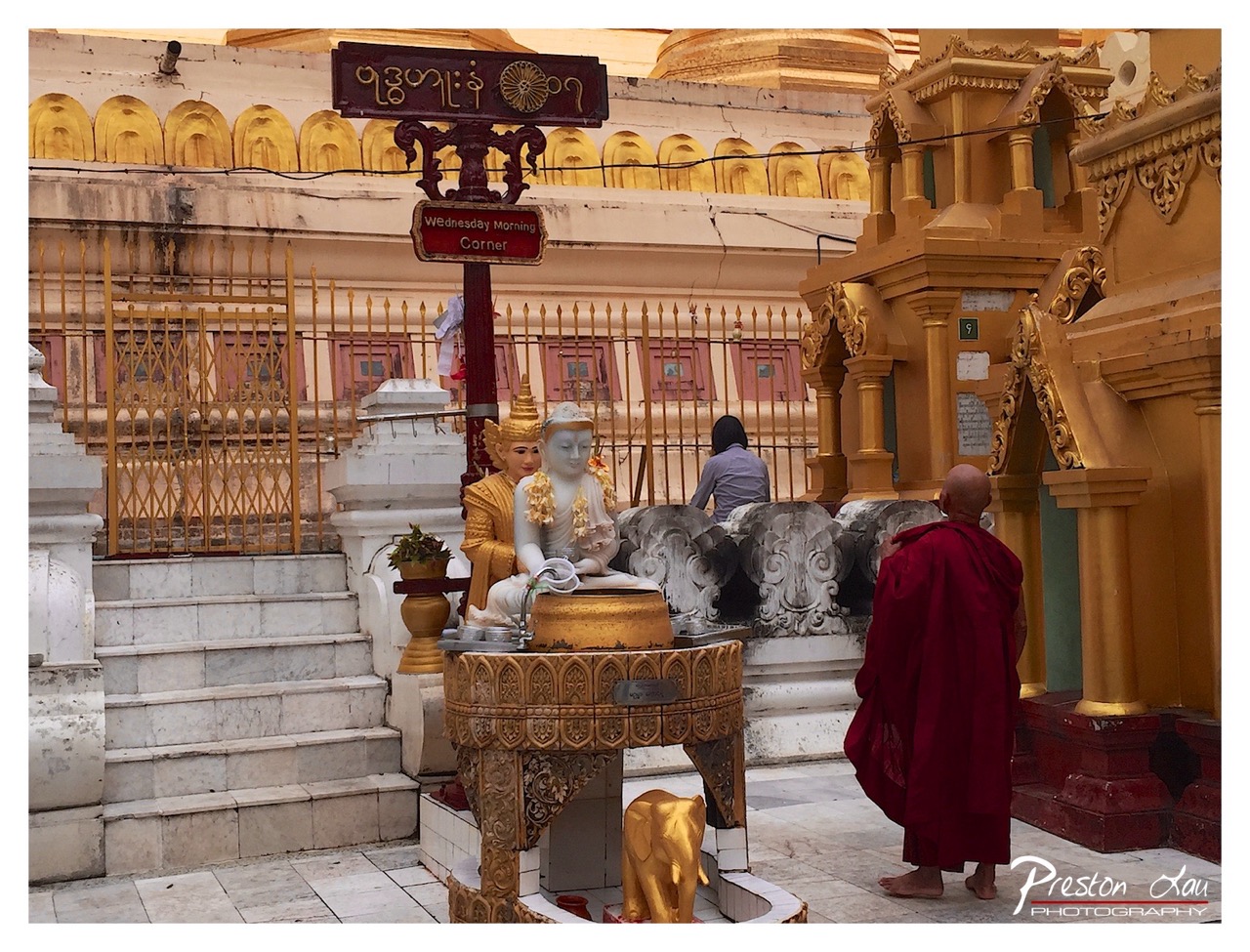

1. Overall Rating (0–10) — 7.0
This photograph captures a serene moment within a vibrant Buddhist temple complex, where tradition and daily life converge in quiet harmony. The golden architecture and the monk’s red robes create a rich visual contrast, grounding the scene in cultural authenticity. While the composition is layered and busy, it effectively conveys the lived spirituality of the space, though some elements feel slightly cluttered and distract from the central figures.
2. Composition (0–10) — 6.5
The frame is well-balanced with the monk and seated Buddha as focal points, but the placement of the sign and steps on the left creates visual weight that pulls attention away from the central action. The diagonal line of the steps leads the eye into the scene, yet the inclusion of the "Wednesday Morning Corner" sign introduces a modern, almost incongruous detail that disrupts the sacred atmosphere.
3. Lighting (0–10) — 7.0
The warm, golden-hour light enhances the richness of the temple’s gold accents and casts soft shadows that add depth and dimension. The lighting feels natural and enhances the spiritual mood, though slight overexposure in the sky and highlights on the gold surfaces slightly diminish the subtlety of the tonal range.
4. Color & Tone (0–10) — 7.5
The dominant palette of gold, white, and deep red creates a visually harmonious and culturally resonant image. The contrast between the luminous gold and the monk’s maroon robe is striking, while the neutral tones of the stone and the background provide balance. The color temperature supports the warm, reverent atmosphere of the setting.
5. Creativity (0–10) — 7.0
The photograph succeeds in blending documentary realism with artistic composition, capturing both the spiritual essence and the everyday presence of monastic life. The inclusion of the sign adds a layer of narrative, suggesting the intersection of ritual and routine, though it risks undermining the image’s sacred tone.
6. Technical Quality (0–10) — 8.0
The image is sharp and well-focused, with fine detail visible in the ornate carvings and the monk’s robe. The exposure is mostly well-managed, though some highlights in the gold trim are slightly blown out. The overall clarity and depth of field contribute to a strong, professional-quality image.
7. Emotional Impact (0–10) — 7.5
The image evokes a sense of peace, reverence, and quiet devotion. The presence of the monk in contemplation, combined with the sacred statues and golden surroundings, creates a powerful emotional resonance that invites the viewer into a moment of stillness and reflection.
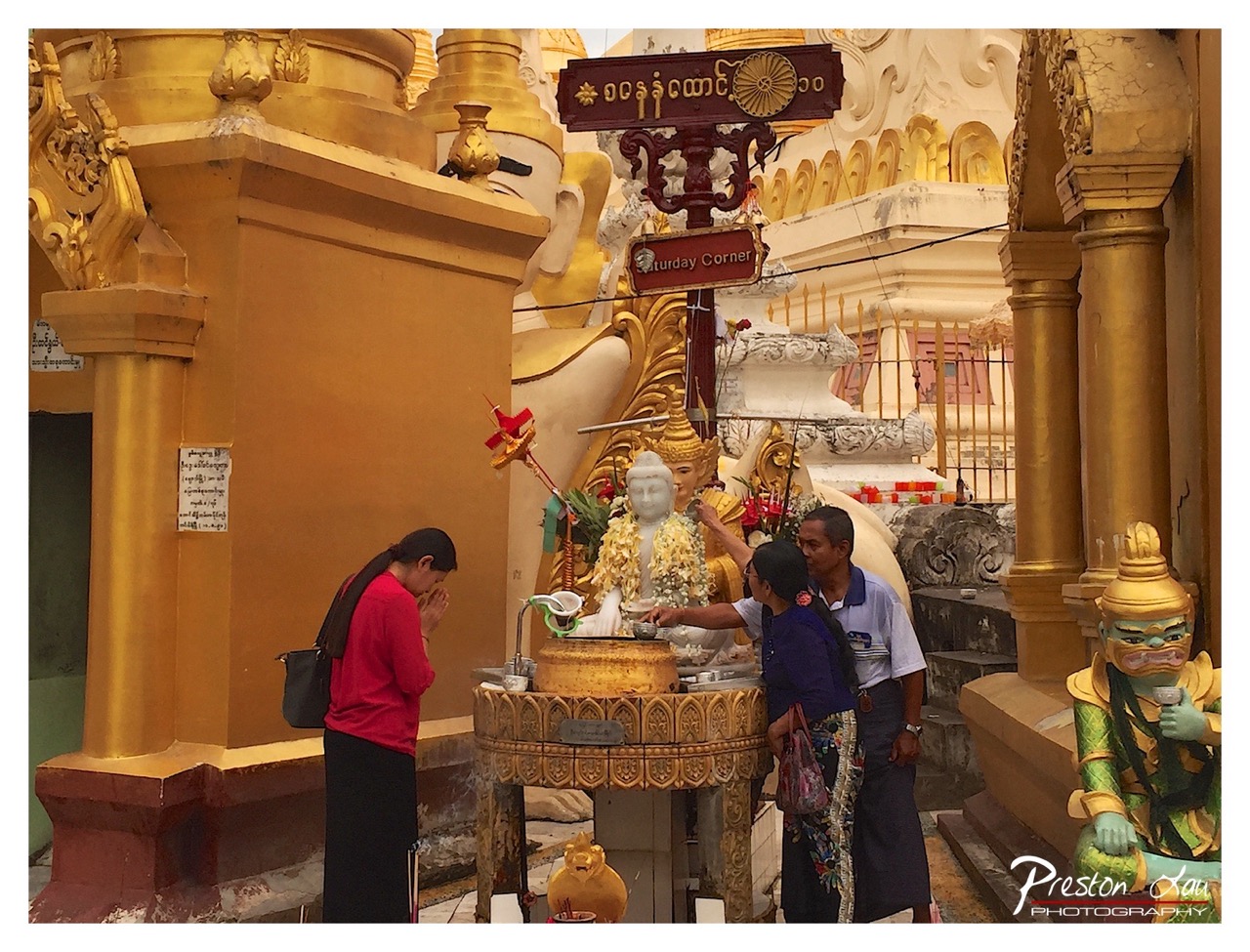

1. Overall Rating (0–10) — 7.5
This photograph captures a quiet, reverent moment at a Buddhist temple, where devotion unfolds amid intricate golden architecture. The interplay of light and color enhances the spiritual atmosphere, while the candid presence of worshippers grounds the scene in authenticity. While the composition is slightly cluttered, the image succeeds in conveying both cultural richness and personal faith.
2. Composition (0–10) — 6.5
The framing includes a wealth of architectural detail, but the central activity is slightly off-center, and the right side feels crowded with the green guardian figure. A tighter crop could better focus attention on the act of worship.
3. Lighting (0–10) — 7.0
Natural daylight illuminates the scene evenly, enhancing the golden tones of the temple while casting soft shadows that add depth. The warm quality of the light complements the spiritual mood.
4. Color & Tone (0–10) — 8.0
The palette is rich and harmonious, with dominant golds and creams contrasted by the vivid red of the woman’s shirt and the green and blue of the other figures. The colors feel authentic and emotionally resonant.
5. Creativity (0–10) — 7.0
The image blends documentary realism with aesthetic appeal, capturing a genuine ritual while emphasizing the temple’s ornate beauty. The inclusion of the “Saturday Corner” sign adds a subtle cultural layer.
6. Technical Quality (0–10) — 8.0
The photograph is sharp, with clear detail in both the foreground and background. The exposure is well-balanced, and the focus is precise on the central figures.
7. Emotional Impact (0–10) — 8.0
The image evokes a sense of peace and reverence, drawing the viewer into a moment of quiet devotion. The expressions and gestures of the worshippers convey sincerity and humility.
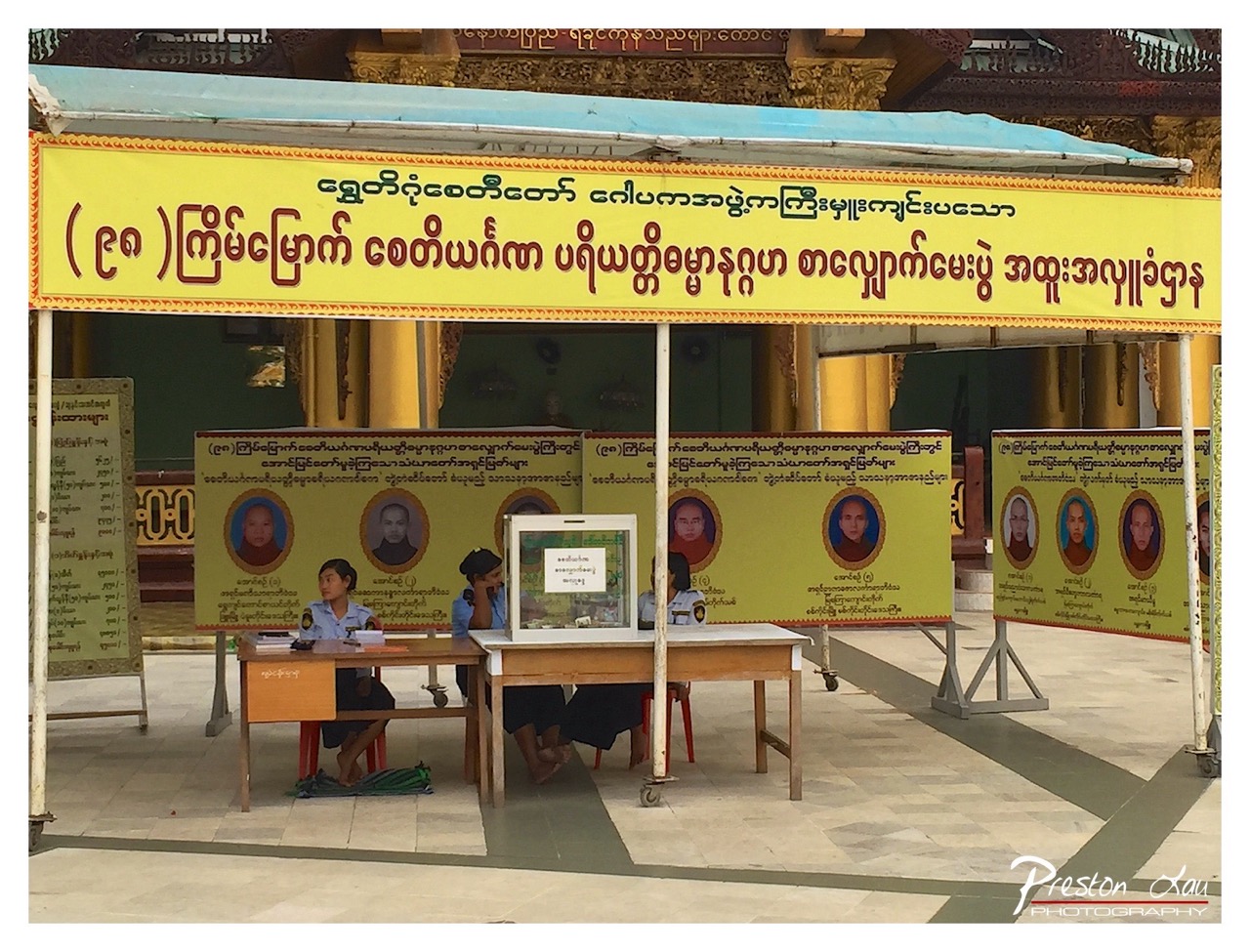

1. Overall Rating (0–10) — 6.0
This photograph captures a quiet moment at a temple registration booth, where tradition meets bureaucracy in a visually layered setting. The vibrant yellow banners and ornate temple architecture create a striking contrast with the mundane activity of officials at their desks, suggesting a story of cultural continuity and administrative routine. While the scene is rich in context and detail, the composition feels slightly cluttered and the lighting lacks the drama to elevate the image beyond a simple documentation.
2. Composition (0–10) — 5.5
The wide framing includes too much background and foreground detail, diluting the focus on the central subjects. The symmetry of the banners and tables provides structure, but the off-center placement of the officials and the cluttered signage disrupt visual balance.
3. Lighting (0–10) — 5.0
Natural daylight illuminates the scene evenly, but the flatness of the light flattens textures and depth. The shadows are minimal, and the bright overhead light washes out subtle details in the temple’s golden carvings.
4. Color & Tone (0–10) — 6.5
The dominant yellow of the banners creates a bold, energetic tone, but the overall palette is somewhat monotonous due to the repetition of similar hues. The contrast between the bright signage and the subdued temple tones adds visual interest, though the color balance leans slightly toward oversaturation.
5. Creativity (0–10) — 6.0
The image successfully juxtaposes spiritual architecture with secular function, offering a unique cultural narrative. However, the approach is observational rather than interpretive, limiting its artistic impact.
6. Technical Quality (0–10) — 7.0
The focus is sharp across the frame, and the image is free from noticeable noise or distortion. The exposure is well-balanced, though the lack of dynamic range reduces visual depth.
7. Emotional Impact (0–10) — 5.5
The photograph evokes a sense of quiet routine and cultural resilience, but the emotional distance created by the wide shot and functional setup prevents a deeper connection with the viewer.
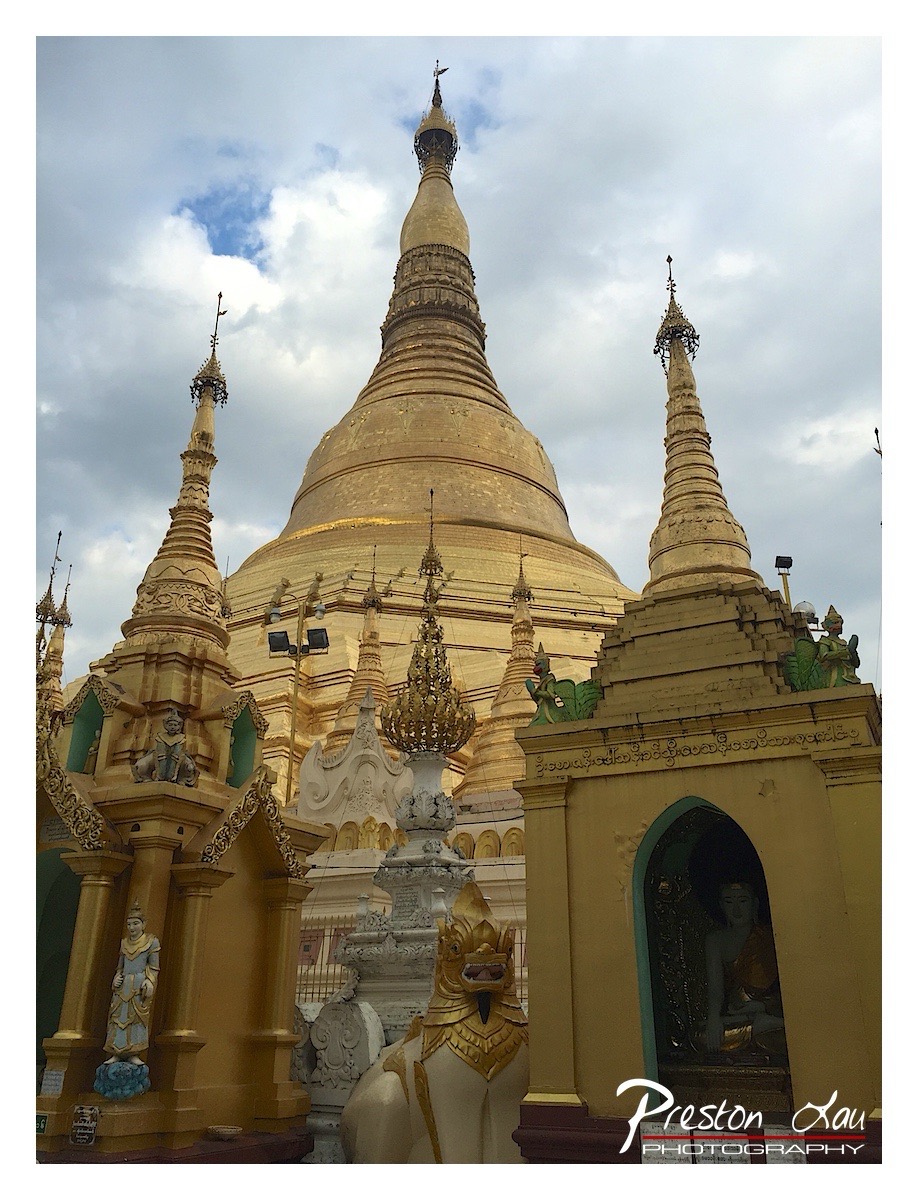

1. Overall Rating (0–10) — 7.5
This photograph captures the grandeur and spiritual resonance of a golden pagoda, its towering spire reaching toward a dramatic sky. The rich gold of the stupa contrasts beautifully with the soft, cloudy backdrop, evoking a sense of reverence and timelessness. While the image is visually striking, the cluttered foreground and heavy watermark slightly detract from its aesthetic harmony and professional polish.
2. Composition (0–10) — 6.5
The low-angle perspective emphasizes the scale of the central stupa, but the framing feels crowded, with multiple spires and structures competing for attention. A tighter crop could better focus the viewer’s eye on the main subject.
3. Lighting (0–10) — 7.0
The soft, diffused light from the overcast sky evenly illuminates the golden surfaces, reducing harsh shadows and enhancing the reflective quality of the metal. The scattered patches of blue sky add subtle contrast and depth.
4. Color & Tone (0–10) — 7.5
The dominant golden hues create a warm, luminous atmosphere, while the white and green accents provide visual balance. The tonal range is rich, with the deep golds contrasting against the cool grays of the sky.
5. Creativity (0–10) — 7.0
The image successfully captures the cultural and spiritual essence of the site, using composition and color to convey awe. The inclusion of surrounding elements adds narrative depth, though the framing could be more deliberate.
6. Technical Quality (0–10) — 8.0
The image is sharp and well-exposed, with clear detail in the textures of the stupa and ornamentation. The focus is consistent across the frame, and the resolution is high.
7. Emotional Impact (0–10) — 7.5
The photograph evokes a sense of reverence and wonder, drawing the viewer into the sacred space. The interplay of light, color, and scale creates a contemplative mood that resonates with the spiritual significance of the site.
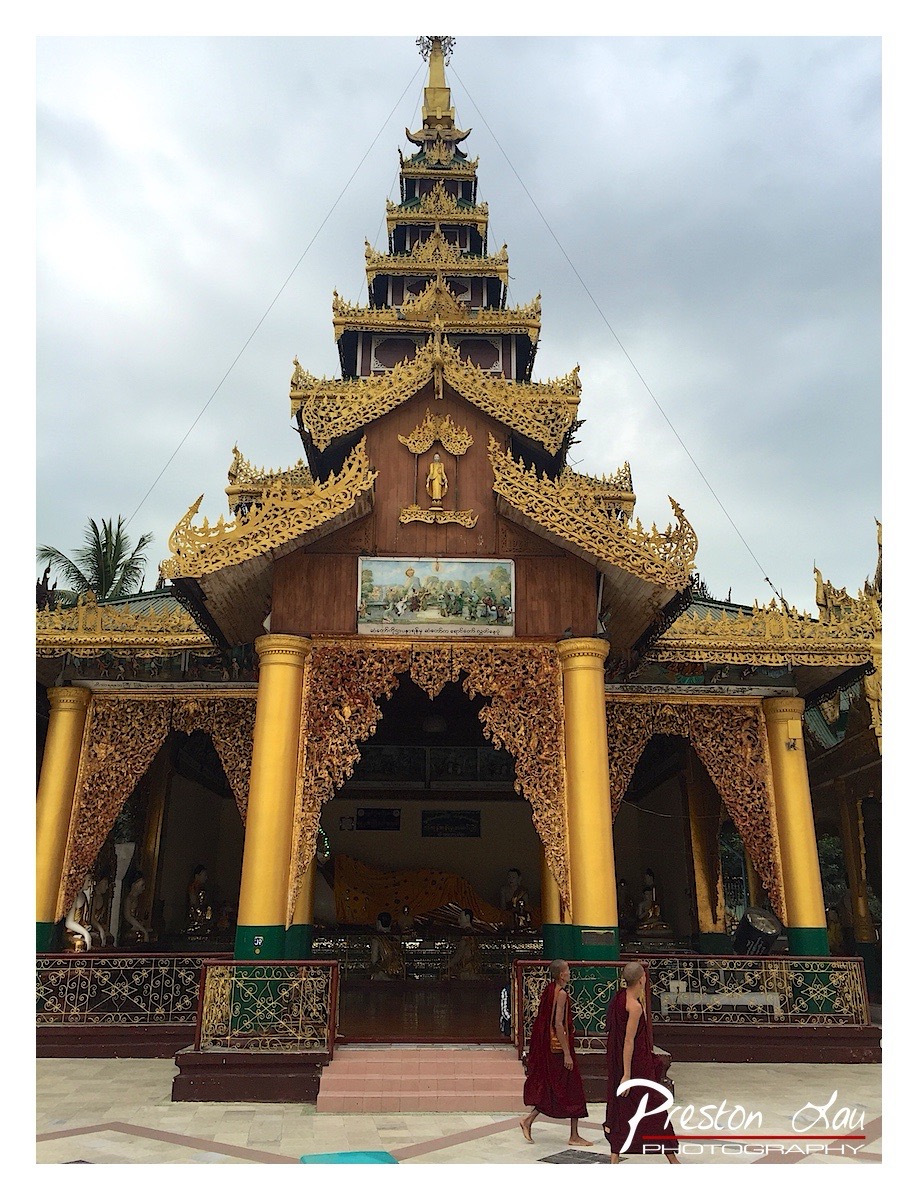

1. Overall Rating (0–10) — 7.5
This photograph captures the spiritual grandeur of a Burmese temple with striking architectural detail and a sense of quiet reverence. The golden spires and ornate carvings stand in dramatic contrast to the overcast sky, creating a mood of solemn beauty. While the image is rich in cultural texture, the slightly muted lighting and casual framing hold it back from transcendent impact.
2. Composition (0–10) — 7.0
The temple dominates the frame, emphasizing its verticality and intricate design. The placement of the two monks in the foreground adds narrative depth and scale, though their movement slightly disrupts the symmetry. A tighter crop might have strengthened the focus on the temple’s facade.
3. Lighting (0–10) — 6.0
The diffused light from the overcast sky softens shadows and evenly illuminates the scene, but it also dulls the vibrancy of the gold accents. The lighting is functional, preserving detail, but it lacks the dramatic contrast or golden hour glow that would elevate the mood.
4. Color & Tone (0–10) — 7.0
The palette is dominated by rich golds and deep maroons, creating a harmonious and culturally resonant atmosphere. The muted sky provides a neutral backdrop that allows the temple’s colors to stand out, though the overall tone feels slightly flat due to the lack of dynamic contrast.
5. Creativity (0–10) — 7.5
The inclusion of the monks adds a human element and a sense of daily life within the sacred space, transforming the image from a mere architectural portrait into a narrative scene. The photographer’s intent to capture both structure and spirituality is clear and effective.
6. Technical Quality (0–10) — 8.0
The image is sharp, with clear detail in the carvings and textural elements. The exposure is well-balanced, and the focus is consistent across the frame. The watermark is unobtrusive and professionally placed.
7. Emotional Impact (0–10) — 7.0
The photograph evokes a sense of peace and devotion, inviting the viewer into a moment of quiet contemplation. The presence of the monks adds a layer of authenticity and emotional warmth, though the overcast sky tempers the sense of awe.
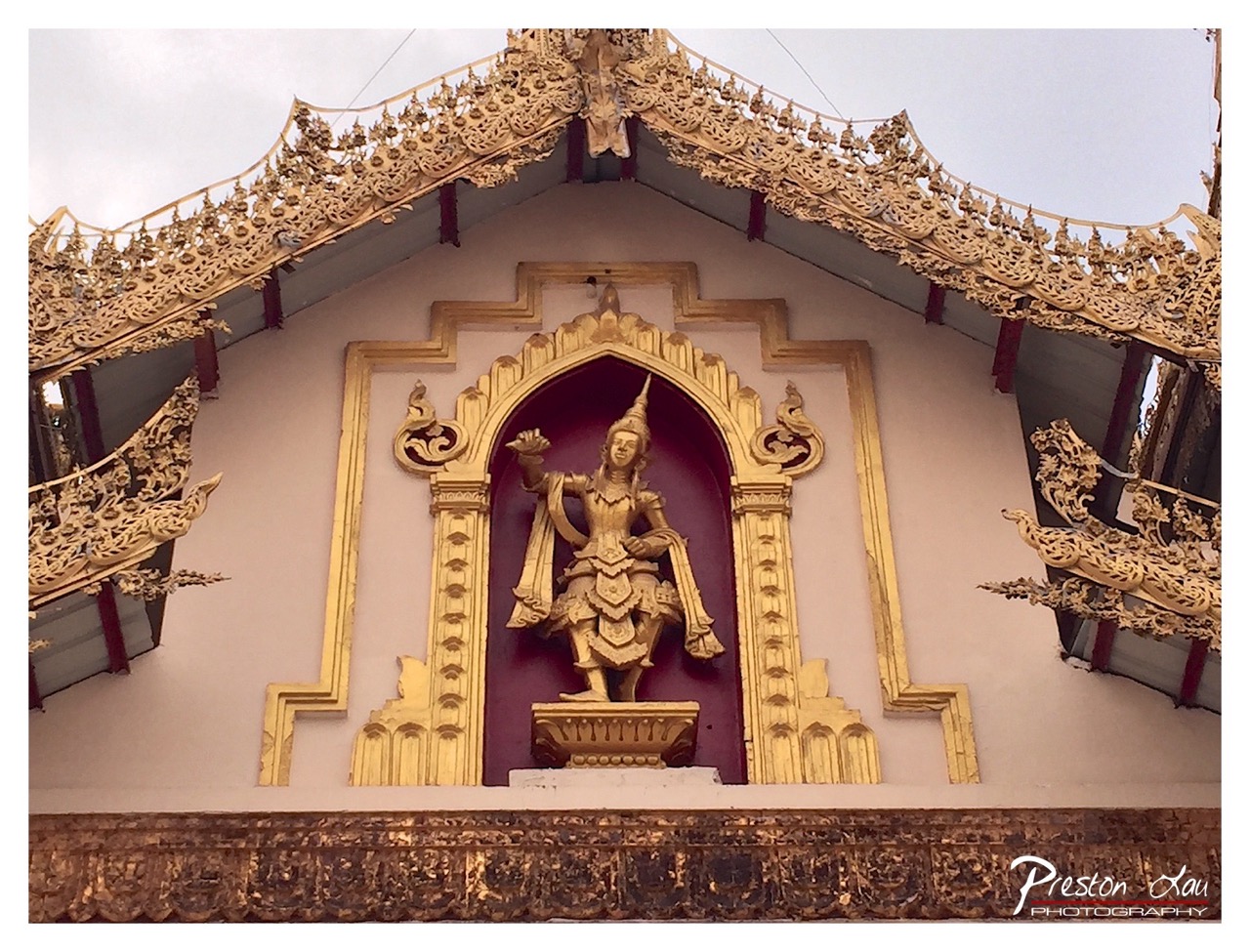

1. Overall Rating (0–10) — 7.5
This photograph captures the ornate grandeur of a traditional Southeast Asian temple facade, where intricate gold detailing and sacred iconography converge in a striking display of cultural artistry. The golden statue, framed by elaborate carvings and set against a muted sky, radiates spiritual reverence and craftsmanship. While the image successfully highlights the architectural richness, the slightly flat lighting and overcast sky slightly dampen the visual impact of the gold’s brilliance.
2. Composition (0–10) — 8.0
The symmetrical framing centers the statue perfectly, drawing the eye to the focal point with strong vertical and horizontal balance. The surrounding golden ornamentation creates a natural border, enhancing the sense of reverence and structure.
3. Lighting (0–10) — 6.5
The soft, diffused light from the overcast sky minimizes harsh shadows, allowing the details of the gold work to be visible. However, the lack of directional light reduces depth and the reflective quality of the metal, making the golden elements appear somewhat flat.
4. Color & Tone (0–10) — 7.0
The rich gold contrasts effectively with the deep maroon backdrop and pale wall, creating a harmonious and regal palette. The overall tone is warm and inviting, though the muted sky tempers the vibrancy of the gold.
5. Creativity (0–10) — 7.5
The photographer captures a moment of cultural and spiritual significance with a respectful, observational approach. The emphasis on symmetry and detail reflects an intent to honor the craftsmanship, resulting in a visually compelling and culturally resonant image.
6. Technical Quality (0–10) — 8.0
The image is sharp and clear, with fine detail visible in the carvings and statue. The focus is precise, and the exposure is well-balanced, though the slight underexposure of the sky slightly limits dynamic range.
7. Emotional Impact (0–10) — 7.0
The image evokes a sense of awe and reverence, inviting the viewer to appreciate the artistry and spiritual significance of the temple. The stillness of the composition and the solemnity of the statue create a contemplative mood.
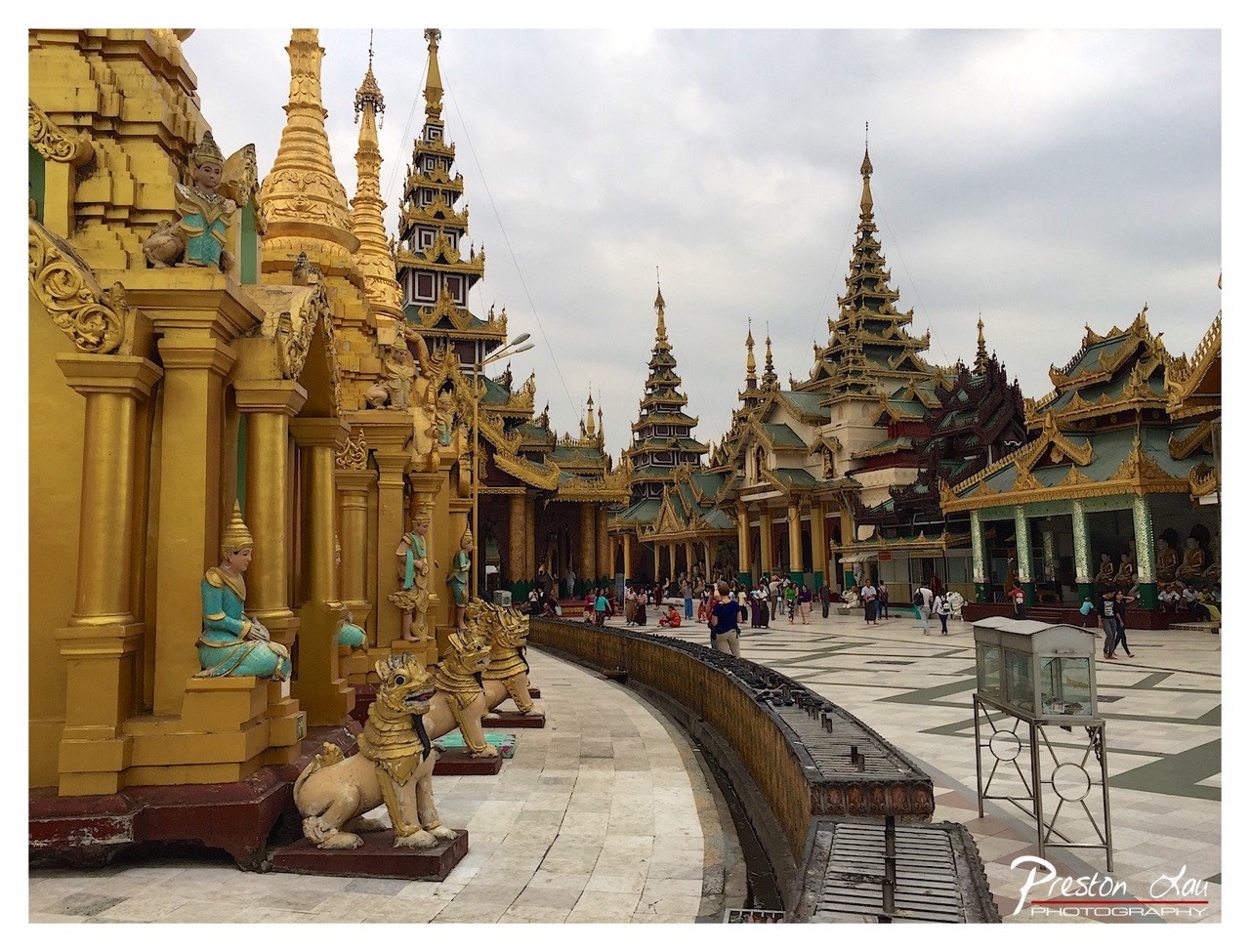

1. Overall Rating (0–10) — 7.5
This photograph captures the grandeur and spiritual serenity of the Shwedagon Pagoda with a compelling balance of architectural detail and human presence. The golden spires rise dramatically against a muted sky, evoking a sense of reverence and timelessness. While the overcast lighting tempers the vibrancy of the gold, the composition effectively conveys the scale and cultural richness of the site, drawing the viewer into its sacred space.
2. Composition (0–10) — 8.0
The diagonal leading line formed by the walkway and rail guides the eye naturally into the frame, creating depth and perspective. The placement of golden statues and railings on the left provides visual weight, balancing the open courtyard and distant structures on the right.
3. Lighting (0–10) — 6.0
The diffused light from the overcast sky softens shadows and evenly illuminates the scene, though it slightly dulls the luster of the gold. This subdued lighting enhances the mood of quiet contemplation but sacrifices some of the visual brilliance one might expect from such a luminous site.
4. Color & Tone (0–10) — 7.0
The dominant gold and jade green palette creates a harmonious and culturally rich atmosphere. The tonal range is restrained due to the cloudy sky, but the contrast between the bright gold and the neutral stone floor provides visual interest and keeps the image from feeling flat.
5. Creativity (0–10) — 7.0
The photographer captures a familiar subject with a thoughtful perspective, emphasizing the interplay between sacred architecture and daily life. The inclusion of visitors adds narrative depth, transforming the image from a mere architectural record into a living portrait of devotion.
6. Technical Quality (0–10) — 8.0
The image is sharp and well-focused, with fine detail visible in the ornate carvings and statues. The exposure is balanced, and the wide dynamic range captures both highlights and shadows without significant loss of detail.
7. Emotional Impact (0–10) — 8.0
The photograph conveys a deep sense of peace and awe, inviting the viewer to reflect on the spiritual significance of the site. The presence of people walking and praying adds a layer of human connection, enhancing the emotional resonance of the sacred space.
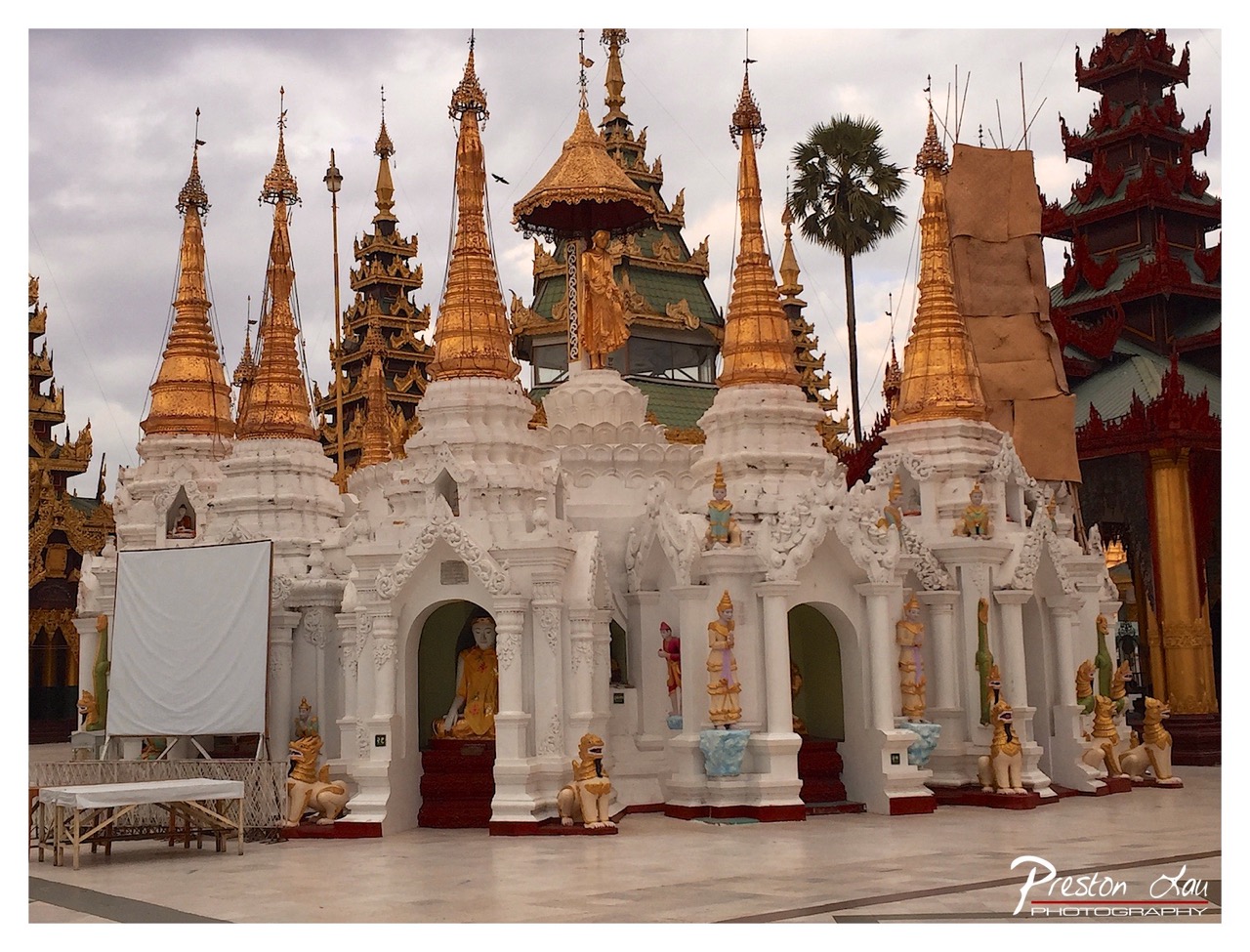

1. Overall Rating (0–10) — 7.5
This photograph captures the intricate grandeur of a Burmese temple complex, where golden spires and ornate white structures rise against a moody, overcast sky. The interplay of light and shadow enhances the sacred atmosphere, while the presence of construction materials and a blank screen introduces a subtle tension between tradition and modernity. While the image is rich in detail and cultural resonance, the slightly cluttered foreground and muted lighting temper its visual impact.
2. Composition (0–10) — 7.0
The central white stupa is well-framed, drawing the eye into the layered architecture. However, the off-center white screen and table on the left create visual imbalance, slightly disrupting the harmony of the composition.
3. Lighting (0–10) — 6.0
Diffused daylight from the overcast sky softens shadows and evenly illuminates the scene, but the lack of strong directional light limits depth and drama. The golden spires appear slightly dull under the flat light.
4. Color & Tone (0–10) — 7.5
The contrast between the radiant gold, pure white, and deep red accents is striking, though the overall tone is slightly cool due to the cloudy sky. The color palette is rich and culturally evocative, with the golden hues standing out as focal points.
5. Creativity (0–10) — 7.0
The image successfully captures both the architectural beauty and the living context of the temple, blending sacred tradition with contemporary elements. The juxtaposition of ornate religious structures with construction materials adds a layer of narrative depth.
6. Technical Quality (0–10) — 8.0
Sharp focus and clean detail highlight the intricate carvings and statues. The image is well-exposed, with no significant technical flaws, though the color saturation could be slightly enhanced.
7. Emotional Impact (0–10) — 7.0
The photograph evokes a sense of reverence and awe, underscored by the quiet stillness of the temple grounds. The blend of spiritual grandeur and subtle signs of ongoing life creates a contemplative mood, inviting reflection on continuity and change.
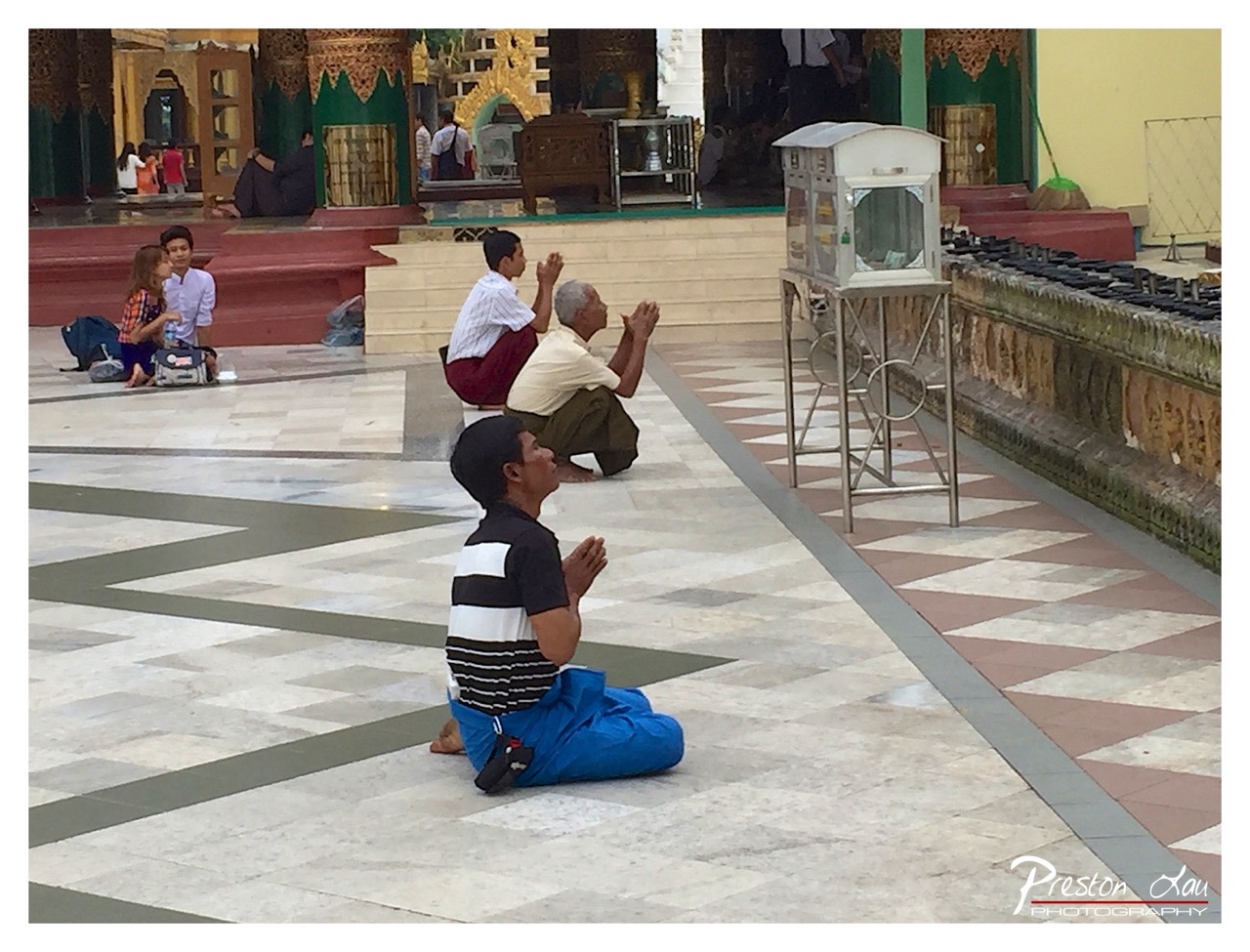

1. Overall Rating (0–10) — 7.0
This photograph captures a quiet moment of devotion within a vibrant temple space, where the stillness of prayer contrasts with the subtle activity of visitors. The layered composition draws the eye from the foreground prayer to the deeper architectural details, creating a sense of spiritual depth. While the image is rich in cultural context, its emotional resonance is slightly tempered by a lack of dramatic lighting and a somewhat flat color palette.
2. Composition (0–10) — 7.5
The diagonal lines of the tiled floor guide the viewer’s gaze toward the praying figures, creating a strong sense of depth. The placement of the foreground subject anchors the frame, while the background figures and ornate temple elements add narrative context without overwhelming the central focus.
3. Lighting (0–10) — 6.0
Natural daylight illuminates the scene evenly, but the overhead quality flattens shadows and reduces texture. The bright, diffuse light suits the documentary nature of the image but lacks the warmth or contrast that could enhance the spiritual mood.
4. Color & Tone (0–10) — 6.5
The palette is grounded in earthy tones—blues, greens, and creams—creating a harmonious visual rhythm. However, the colors appear slightly muted, with a cool cast that softens the vibrancy of the temple’s traditional hues.
5. Creativity (0–10) — 7.0
The image successfully blends cultural documentation with a contemplative mood, capturing a candid moment of worship without staging. The juxtaposition of devotees and tourists adds a layer of social observation, giving the photograph a quiet narrative complexity.
6. Technical Quality (0–10) — 7.5
The image is sharp and well-focused, with clean details in both the foreground and background. The exposure is balanced, and the composition is stable, indicating solid technical execution.
7. Emotional Impact (0–10) — 7.0
There is a palpable sense of reverence and introspection, particularly in the posture and stillness of the praying figures. The viewer is invited into a moment of quiet reflection, though the emotional pull is subtle rather than overwhelming.
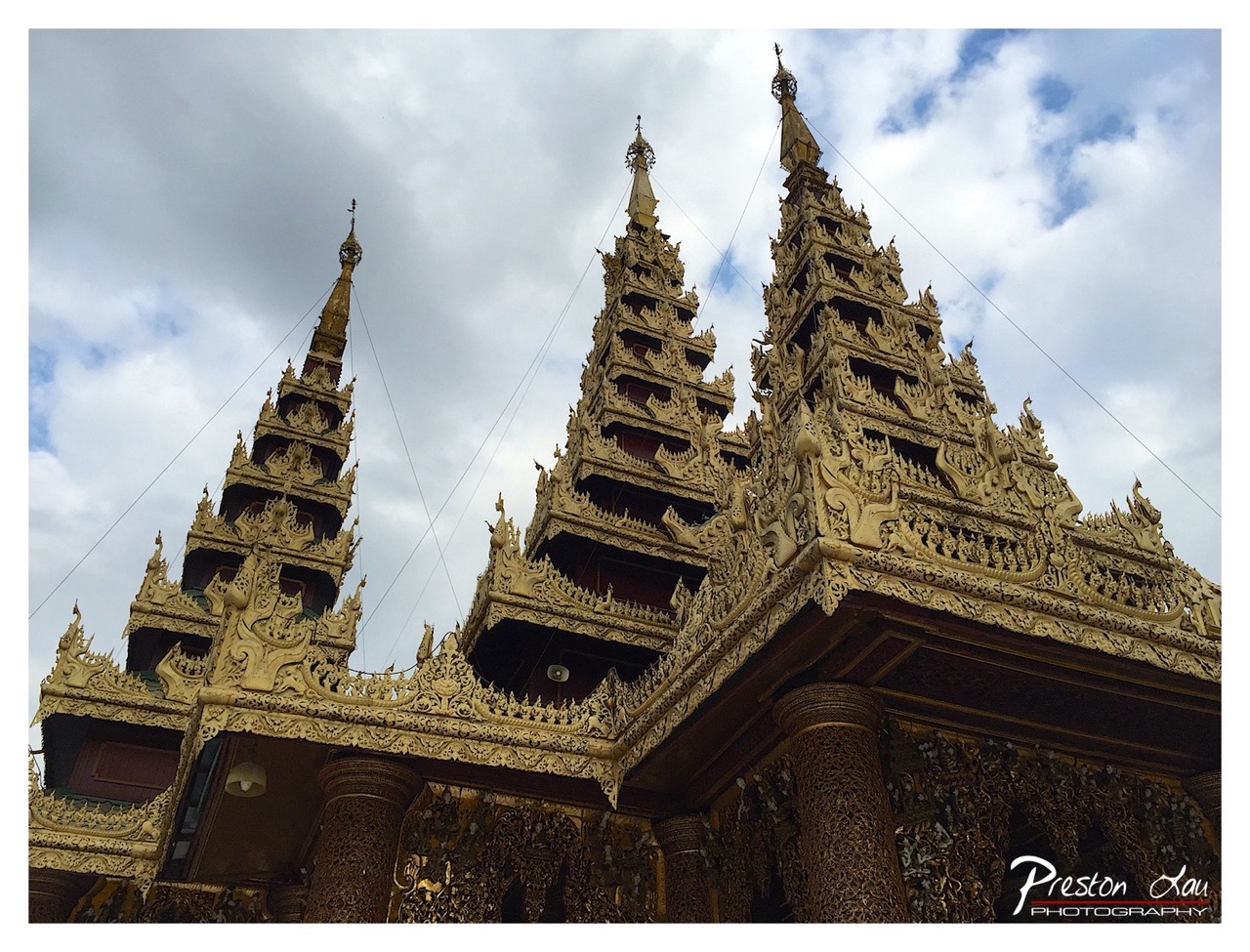

1. Overall Rating (0–10) — 8.0
This photograph captures the breathtaking grandeur of a Burmese temple, where intricate golden spires reach toward a brooding sky. The low-angle perspective amplifies the structure’s verticality and sacred presence, while the contrast between the ornate gold and the overcast clouds adds a dramatic, almost mystical quality. While the image is visually rich and culturally evocative, a slightly more balanced exposure could enhance the depth of the details without sacrificing the moody atmosphere.
2. Composition (0–10) — 8.5
The low-angle framing emphasizes the towering spires, creating a powerful sense of awe. The arrangement of the three main towers forms a strong diagonal and triangular composition, guiding the eye upward. The inclusion of the foreground eaves and columns grounds the image, adding depth and context to the temple’s elaborate architecture.
3. Lighting (0–10) — 7.0
The diffused light from the overcast sky softens shadows and evenly illuminates the golden details, allowing the intricate carvings to be visible. However, the lack of direct sunlight tempers the brilliance of the gold, slightly muting its luster. The dramatic sky, though, provides a compelling backdrop that enhances the image’s mood.
4. Color & Tone (0–10) — 8.0
The dominant warm golds of the temple contrast beautifully with the cool grays and blues of the cloudy sky, creating a visually striking and harmonious palette. The tonal range is well-balanced, with the golden tones standing out without appearing washed out. The subtle color temperature lends a serene, contemplative feel to the scene.
5. Creativity (0–10) — 8.5
The photographer’s choice of angle and framing transforms a traditional architectural subject into a dynamic, almost cinematic image. The interplay between the man-made opulence and the natural, moody sky suggests a narrative of spiritual aspiration, elevating the photo beyond mere documentation into a work of visual storytelling.
6. Technical Quality (0–10) — 8.0
The image is sharp and detailed, with excellent clarity in the fine carvings and textures of the temple. The focus is precise across the main structures, and the digital clarity allows for rich detail even in the darker areas. The watermark is discreet and does not detract from the composition.
7. Emotional Impact (0–10) — 8.5
The photograph evokes a sense of reverence and wonder, capturing the spiritual and cultural significance of the temple. The dramatic sky and soaring architecture inspire awe and contemplation, inviting the viewer to reflect on the devotion and artistry behind the structure. The mood is both majestic and introspective, leaving a lasting impression.
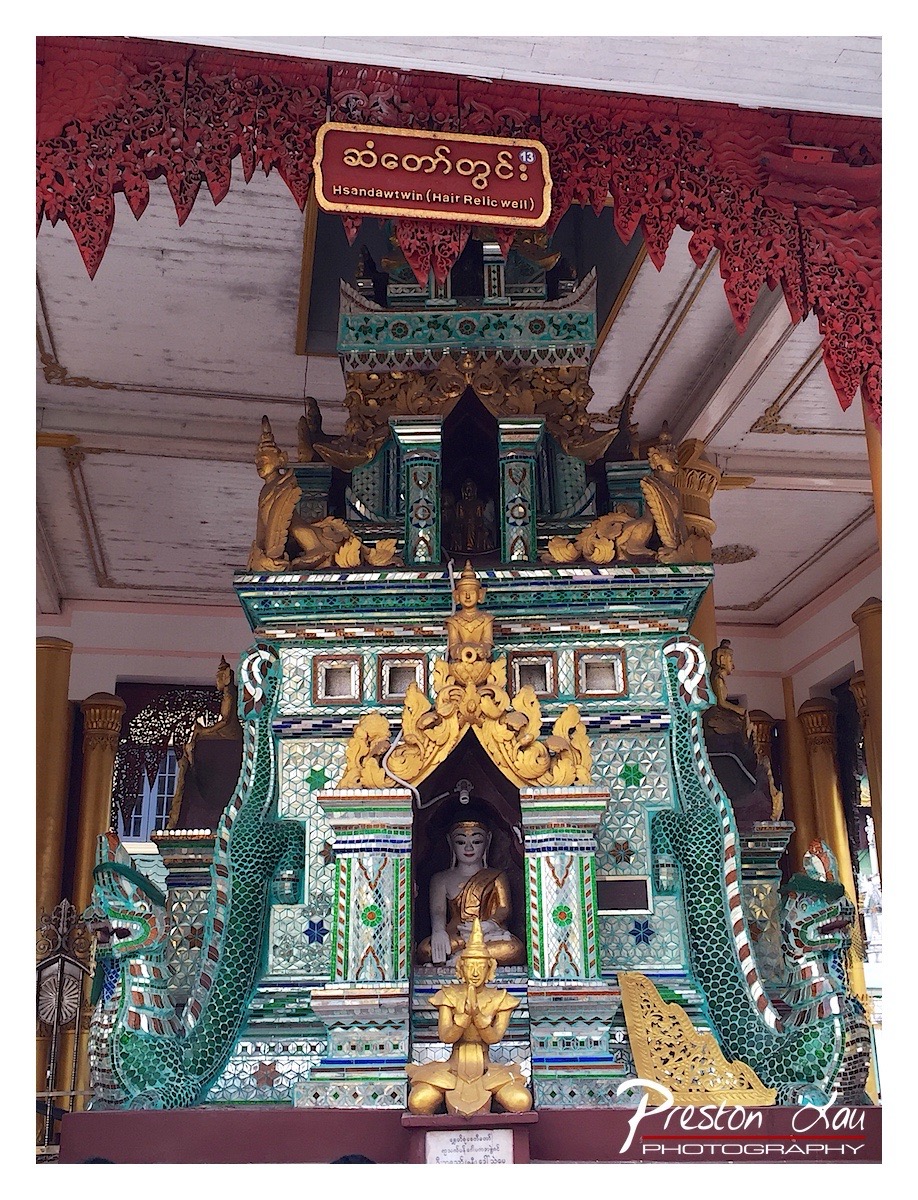

1. Overall Rating (0–10) — 8.0
This photograph captures the ornate grandeur of a Burmese Buddhist relic shrine with striking clarity and reverence. The intricate mosaic work, gilded figures, and layered architectural details convey a sense of sacred tradition and cultural richness. While the composition is visually dense, it successfully communicates the spiritual significance of the Hsandaowin (Hair Relic) shrine, though the watermark slightly disrupts the immersive quality of the image.
2. Composition (0–10) — 7.5
The central placement of the shrine emphasizes its importance, with the upward composition drawing the eye toward the sacred relic. The symmetry of the design and the framing by the red carved ceiling enhance balance, though the slight tilt and surrounding architectural elements create a subtle sense of visual clutter.
3. Lighting (0–10) — 7.0
Natural light from the side softly illuminates the shrine, highlighting the textures and metallic sheen of the gold elements. The lighting is even but not dramatic, preserving detail while maintaining a respectful, calm atmosphere appropriate for the subject.
4. Color & Tone (0–10) — 8.5
The vibrant turquoise, gold, and red palette creates a rich, harmonious contrast that enhances the visual appeal. The warm tones evoke a sense of reverence, while the cool mosaic patterns provide a striking counterpoint. The color balance is natural and well-preserved, capturing the site’s authentic aesthetic.
5. Creativity (0–10) — 8.0
The image is both documentary and artistic, capturing the shrine’s intricate craftsmanship while emphasizing its spiritual and cultural context. The use of a vertical format and tight framing elevates the subject beyond mere documentation, inviting contemplation of its symbolic depth.
6. Technical Quality (0–10) — 8.5
Sharp focus, clean detail, and well-managed exposure contribute to a technically strong image. The clarity of the mosaic tiles and carved wood is impressive, and the absence of noise or blur suggests high-quality capture and post-processing.
7. Emotional Impact (0–10) — 8.0
The photograph evokes a sense of awe and serenity, inviting viewers to appreciate the devotion and artistry embedded in the shrine. The combination of sacred imagery, rich textures, and cultural symbolism fosters a deep emotional resonance, even from a distance.
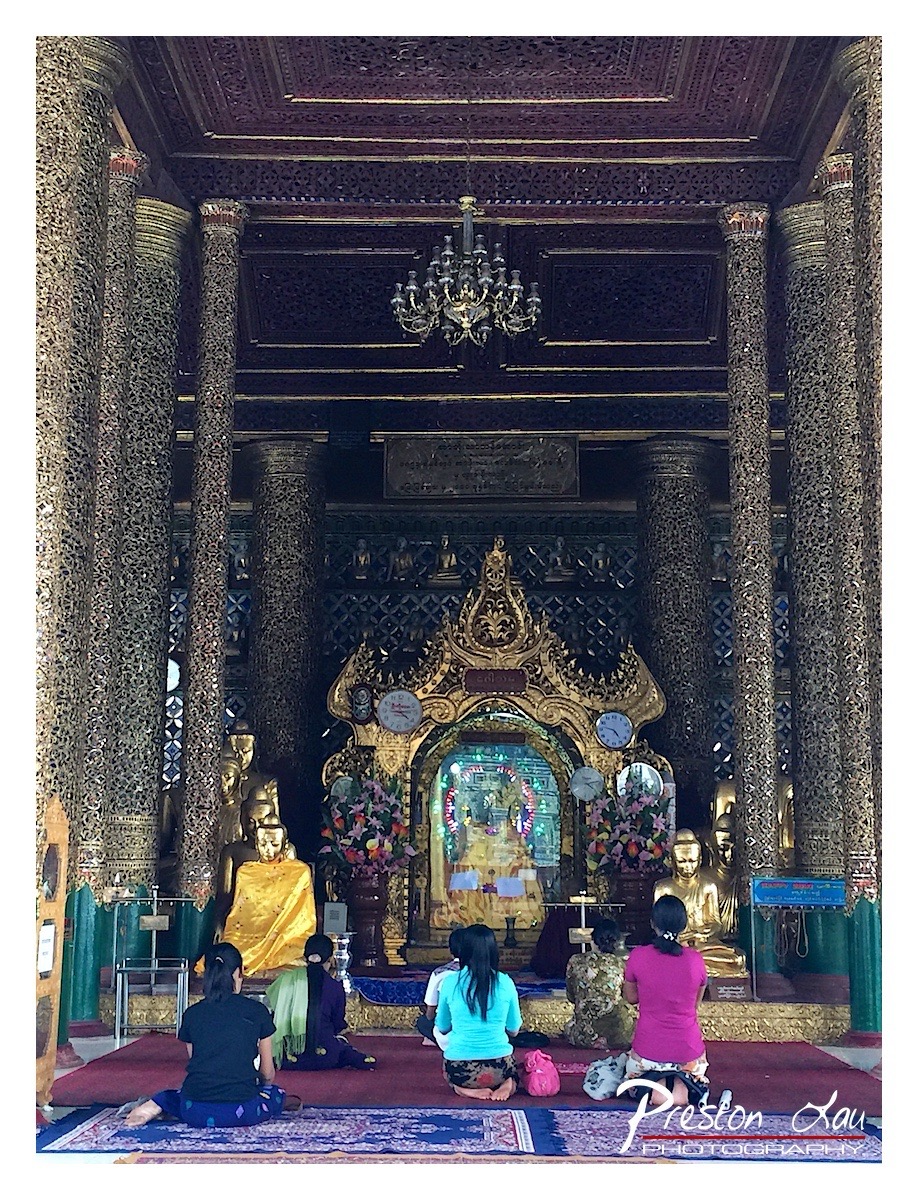

1. Overall Rating (0–10) — 7.5
This photograph captures a deeply reverent moment within a richly ornate temple, where tradition and devotion converge in a visually striking setting. The intricate golden carvings, sacred statues, and kneeling worshippers create a layered narrative of faith and cultural continuity. While the composition is strong, the image’s emotional resonance is slightly dampened by a lack of dynamic lighting and a somewhat cluttered foreground that competes for attention.
2. Composition (0–10) — 7.0
The symmetrical framing centers the altar, drawing the eye toward the sacred image, while the kneeling figures create a sense of depth and scale. However, the foreground elements—particularly the scattered bags and the lower portion of the frame—introduce visual distractions that weaken the overall balance.
3. Lighting (0–10) — 6.0
The lighting is functional but flat, with a mix of natural and artificial sources that fail to highlight the textures of the gold and wood. The chandelier casts soft shadows, but the overall exposure lacks contrast, resulting in a somewhat muted atmosphere.
4. Color & Tone (0–10) — 7.5
The warm golden tones of the temple interior dominate, creating a sense of opulence and reverence. The vibrant colors of the worshippers’ clothing—especially the bright pink and turquoise—add visual interest and contrast against the darker background, enhancing the image’s cultural richness.
5. Creativity (0–10) — 7.0
The photograph successfully captures a candid moment of worship within a culturally significant space, blending documentary realism with artistic composition. The juxtaposition of modern visitors with ancient architecture adds a layer of narrative depth, though the approach remains relatively conventional.
6. Technical Quality (0–10) — 8.0
The image is sharp and detailed, particularly in the architectural elements and the intricate carvings. The focus is consistent across the frame, and the resolution effectively conveys the richness of the scene.
7. Emotional Impact (0–10) — 7.5
The image evokes a quiet sense of reverence and connection to tradition, with the worshippers’ postures conveying humility and devotion. While the emotional pull is strong, the lack of dramatic lighting and the visual clutter slightly limit the viewer’s ability to fully immerse in the spiritual atmosphere.
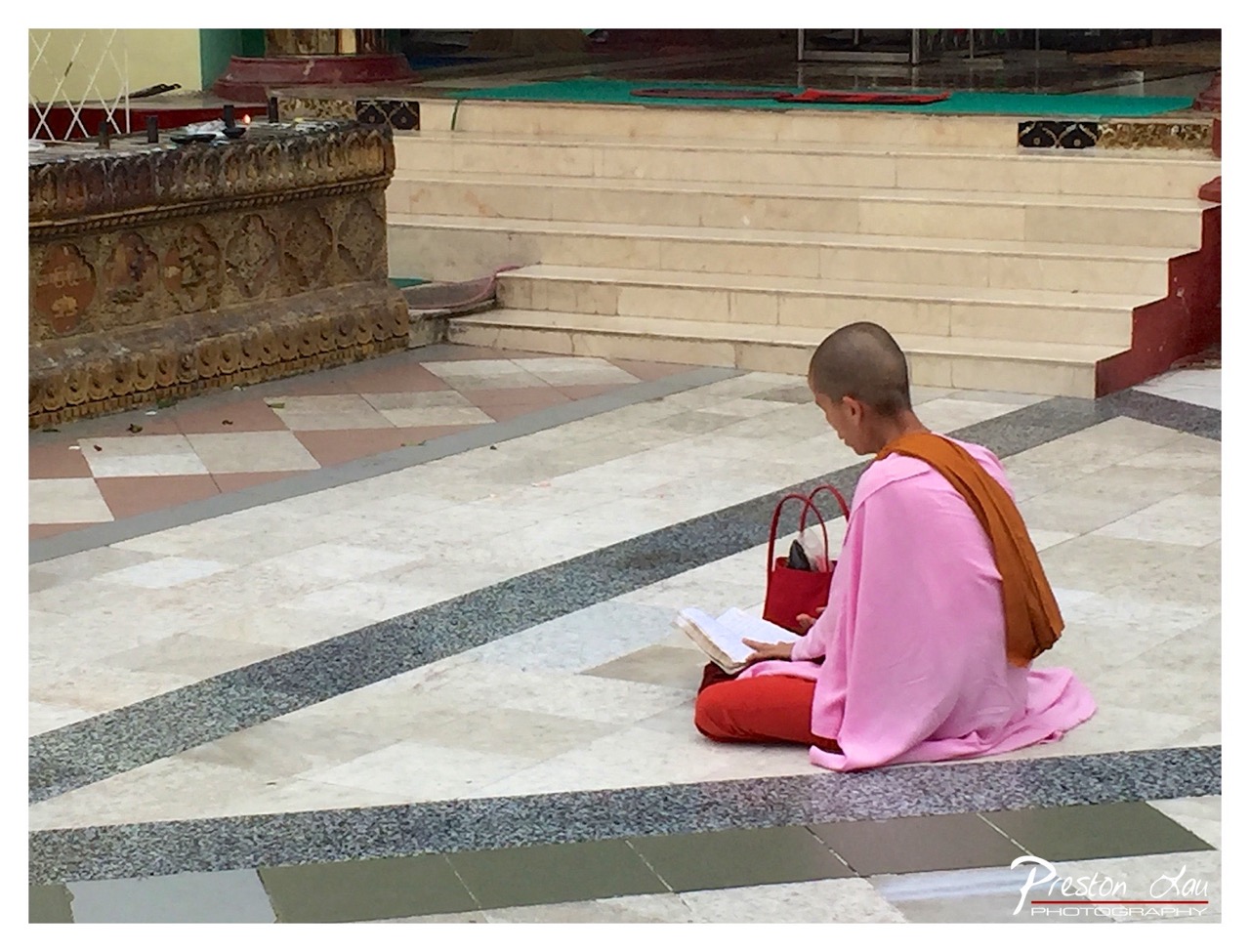

1. Overall Rating (0–10) — 7.0
This photograph captures a serene moment of devotion within a temple space, where the quiet focus of the monk contrasts beautifully with the ornate surroundings. The composition draws the eye naturally toward the subject, emphasizing both spiritual practice and cultural context. While the lighting and color palette are somewhat subdued, the image conveys a sense of stillness and reverence that resonates with the viewer.
2. Composition (0–10) — 7.5
The monk is positioned off-center, creating a balanced asymmetry that guides the viewer’s gaze across the frame. The diagonal lines of the floor tiles and the steps add visual interest, leading the eye toward the subject while maintaining a sense of depth and spatial harmony.
3. Lighting (0–10) — 6.5
Natural, diffused light illuminates the scene evenly, avoiding harsh shadows and preserving detail in both the subject and background. While the lighting is functional and clear, it lacks dramatic contrast or warmth, which slightly diminishes the emotional depth of the moment.
4. Color & Tone (0–10) — 6.0
The palette is composed of soft, earthy tones—pinks, beiges, and muted reds—that harmonize well with the temple’s architecture. However, the colors feel slightly washed out, lacking vibrancy, which limits the image’s visual impact despite its cultural richness.
5. Creativity (0–10) — 7.0
The photograph successfully captures a candid, authentic moment of religious practice, offering a glimpse into a spiritual routine. The framing and perspective are thoughtful, emphasizing the quiet dignity of the scene without resorting to overt stylization.
6. Technical Quality (0–10) — 7.5
The image is sharp and well-focused, with clear detail in the monk’s robes, the book, and the surrounding architecture. The exposure is balanced, and there are no visible technical flaws such as blur or noise.
7. Emotional Impact (0–10) — 7.0
The image evokes a sense of peace and contemplation, inviting the viewer to reflect on the quiet discipline of spiritual life. The monk’s posture and focus convey deep concentration, creating a subtle but meaningful emotional connection.
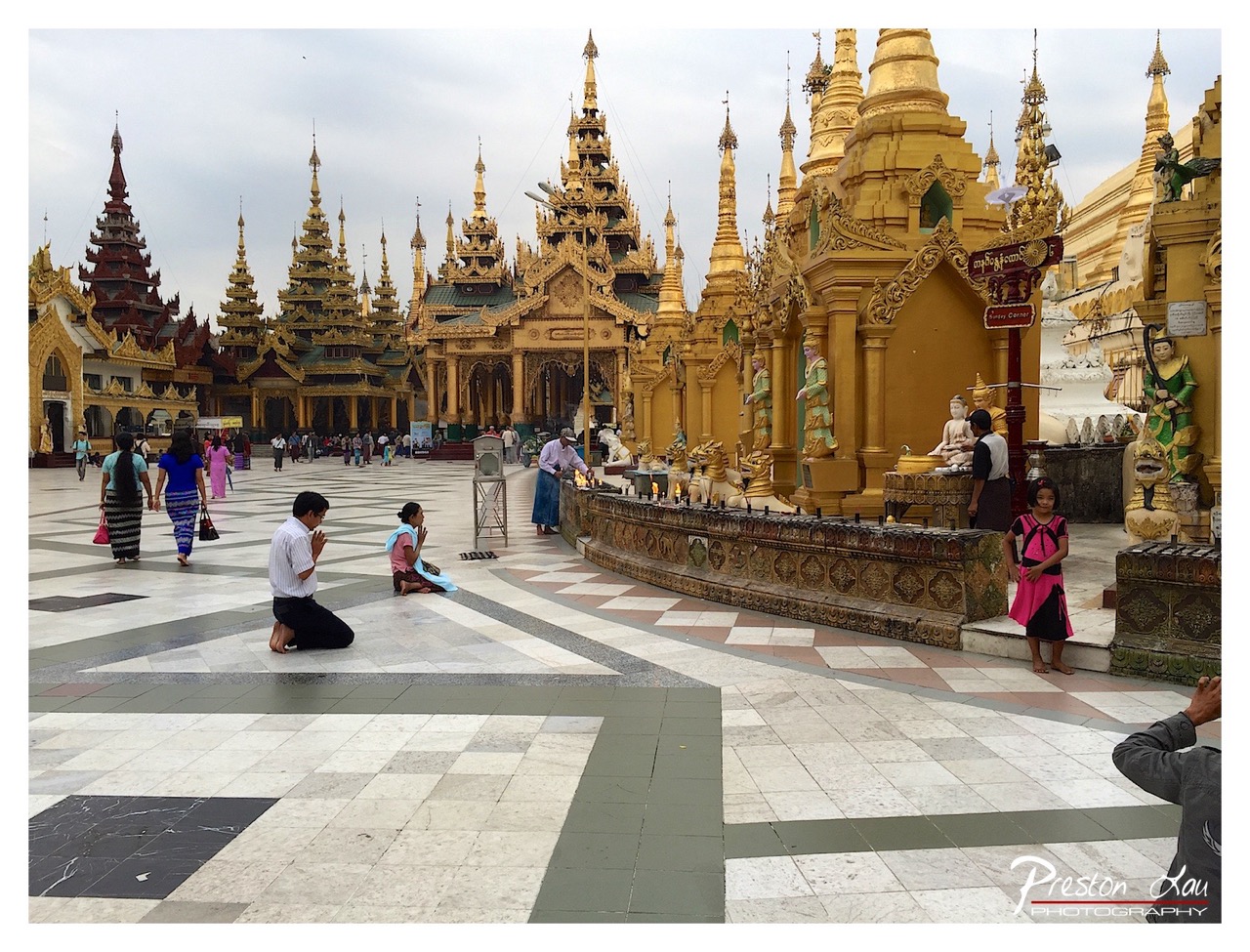

1. Overall Rating (0–10) — 7.5
This photograph captures the vibrant spirituality and architectural grandeur of the Shwedagon Pagoda, where devotion and cultural richness converge. The golden spires rise majestically against a soft, overcast sky, creating a luminous backdrop for the quiet rituals unfolding on the temple grounds. While the scene is rich in detail and emotional depth, the composition’s wide framing slightly dilutes the intimacy of the moment, leaving the viewer more as an observer than a participant.
2. Composition (0–10) — 7.0
The diagonal lines of the tiled courtyard guide the eye toward the central golden structures, creating a sense of depth and movement. The placement of kneeling figures in the foreground grounds the image, while the expansive background adds context. However, the scattered people and architectural elements create visual clutter, slightly weakening the focus on the primary subjects.
3. Lighting (0–10) — 6.5
The diffused, overcast light softens the scene, preventing harsh shadows and allowing the gold of the pagodas to glow with a warm, even tone. While the lighting is natural and appropriate for the setting, it lacks dramatic contrast, resulting in a somewhat flat appearance that diminishes the potential for mood and texture.
4. Color & Tone (0–10) — 8.0
The palette is dominated by radiant golds and earthy tones, which are beautifully complemented by the cool grays and whites of the tiled courtyard. The contrast between the warm architecture and the muted sky enhances the visual appeal, while the subtle color harmony reinforces the sacred atmosphere of the site.
5. Creativity (0–10) — 7.5
The image captures a moment of authentic cultural and spiritual practice, blending architecture, ritual, and daily life into a cohesive narrative. The photographer’s choice to include both worshippers and visitors adds layers of meaning, suggesting the site as both a place of devotion and a living cultural space. While not radically original in concept, the execution reflects a thoughtful and respectful approach to storytelling.
6. Technical Quality (0–10) — 8.0
The image is sharp and well-focused, with clear detail in both the foreground and background. The exposure is balanced, preserving detail in the highlights of the golden spires and the mid-tones of the courtyard. The white balance is accurate, rendering the colors faithfully and enhancing the visual clarity of the scene.
7. Emotional Impact (0–10) — 8.0
The photograph evokes a sense of reverence and tranquility, inviting the viewer to reflect on the enduring power of faith and tradition. The quiet gestures of prayer and the presence of children and elders create a deeply human moment, resonating with quiet dignity and spiritual connection. The emotional weight is carried not by dramatic flair, but by the authenticity of the captured scene.
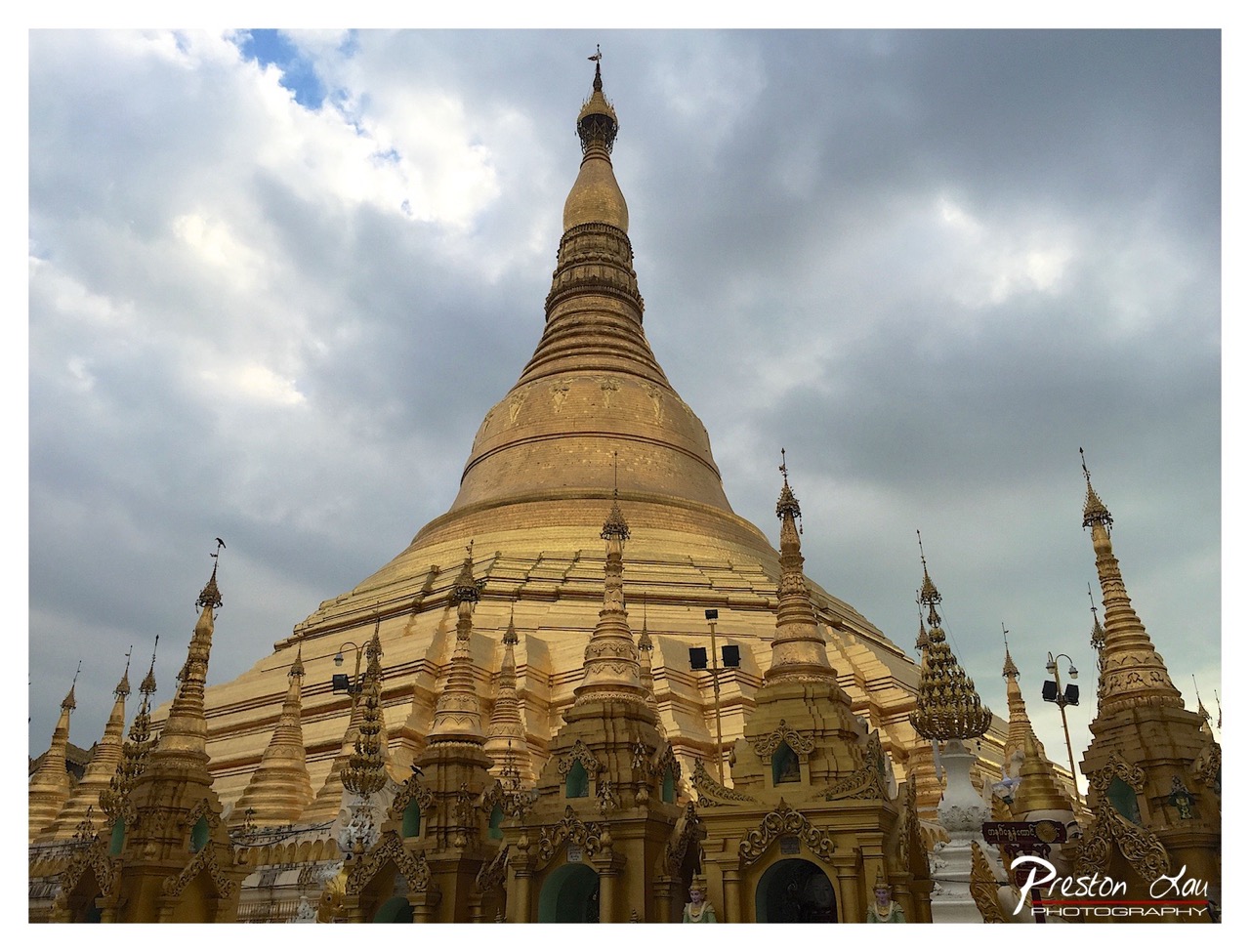

1. Overall Rating (0–10) — 7.5
This photograph captures the majestic presence of a golden stupa under a brooding sky, where light and shadow converge to create a dramatic sense of reverence and scale. The rich gold of the temple contrasts powerfully with the overcast heavens, lending the image a spiritual weight and visual grandeur. While the composition is strong and the subject inherently compelling, the slightly heavy-handed post-processing and lack of subtlety in the sky’s tonality slightly diminish the image’s emotional resonance.
2. Composition (0–10) — 8.0
The low-angle perspective emphasizes the stupa’s verticality and dominance, drawing the eye upward. The arrangement of smaller spires in the foreground creates a layered, textured frame that adds depth and cultural context.
3. Lighting (0–10) — 7.0
The interplay of soft, diffused light and shadow across the golden surfaces enhances the stupa’s intricate details. However, the sky’s overexposed highlights and darkened clouds introduce a slightly artificial contrast, reducing the natural balance of light.
4. Color & Tone (0–10) — 7.5
The warm golden tones are rich and saturated, creating a strong visual anchor, while the cool grays of the clouds provide a dramatic contrast. The color grading leans toward a high-contrast, cinematic look that enhances mood but slightly sacrifices realism.
5. Creativity (0–10) — 8.0
The photographer captures a powerful juxtaposition between sacred architecture and atmospheric drama, transforming a religious site into a visually poetic and emotionally charged scene. The choice of angle and timing elevates the familiar into something majestic and contemplative.
6. Technical Quality (0–10) — 8.0
Sharp focus and clear detail across the stupa’s surface demonstrate strong technical execution. The image is well-exposed overall, with good clarity in both highlights and midtones.
7. Emotional Impact (0–10) — 8.0
The image evokes awe and solemnity, inviting the viewer to feel the spiritual weight of the site. The tension between the divine golden structure and the turbulent sky creates a sense of quiet drama and introspection.
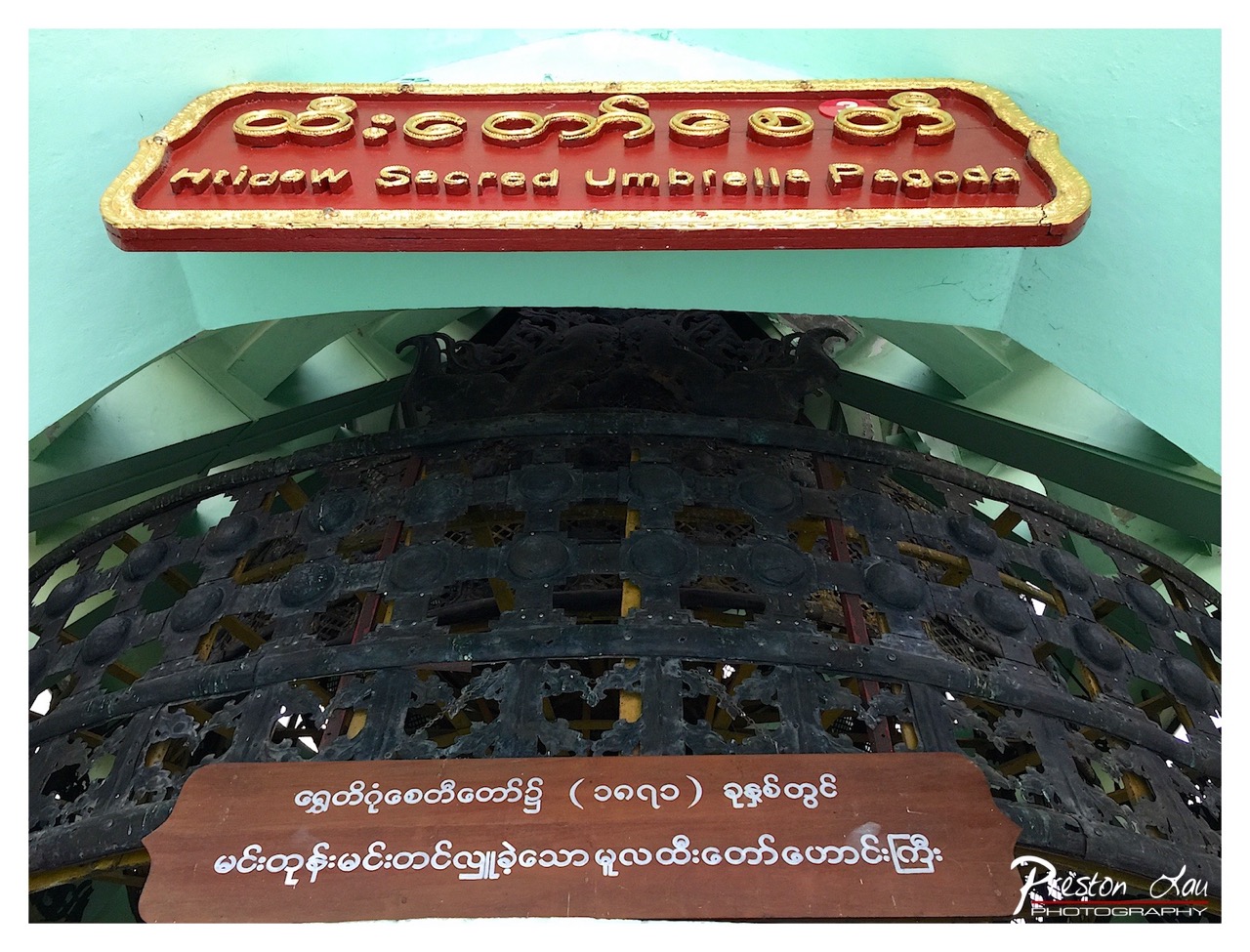

1. Overall Rating (0–10) — 6.0
This photograph captures the ornate and sacred essence of the Hti-daw Sacred Umbrella Pagoda, blending cultural identity with architectural detail. The rich red and gold signage contrasts strikingly with the mint-green wall, drawing attention to the spiritual significance of the site. However, the cluttered foreground and awkward framing slightly undermine the image’s potential to convey reverence and clarity.
2. Composition (0–10) — 5.5
The low-angle perspective emphasizes the structure’s verticality, but the overlapping elements—especially the wooden plaque and the metalwork—create visual noise. A tighter crop and more deliberate framing would enhance focus on the central sign and architectural details.
3. Lighting (0–10) — 6.0
Natural daylight illuminates the scene evenly, preserving the vividness of the red and gold lettering. However, the lack of directional light results in flat shadows, reducing depth and texture in the metalwork below.
4. Color & Tone (0–10) — 6.5
The contrast between the vibrant red and gold signage and the soft mint-green background creates a visually engaging palette. The warm tones of the wood and metal add depth, though the overall tone leans slightly toward clinical due to the bright, unfiltered light.
5. Creativity (0–10) — 6.0
The image successfully documents a culturally significant site with authenticity, using a low-angle view to emphasize scale and importance. While the composition is functional, it lacks a more artistic or narrative twist to elevate the visual storytelling.
6. Technical Quality (0–10) — 7.5
The image is sharp and well-focused, with clear legibility of both the Burmese and English text. The details in the metalwork and signage are rendered cleanly, though the slight overexposure in the background reduces subtlety.
7. Emotional Impact (0–10) — 5.5
The photograph conveys a sense of place and tradition, inviting curiosity about the site’s spiritual role. Yet, the lack of human presence and the busy composition limit its ability to evoke deeper emotional resonance or intimacy.
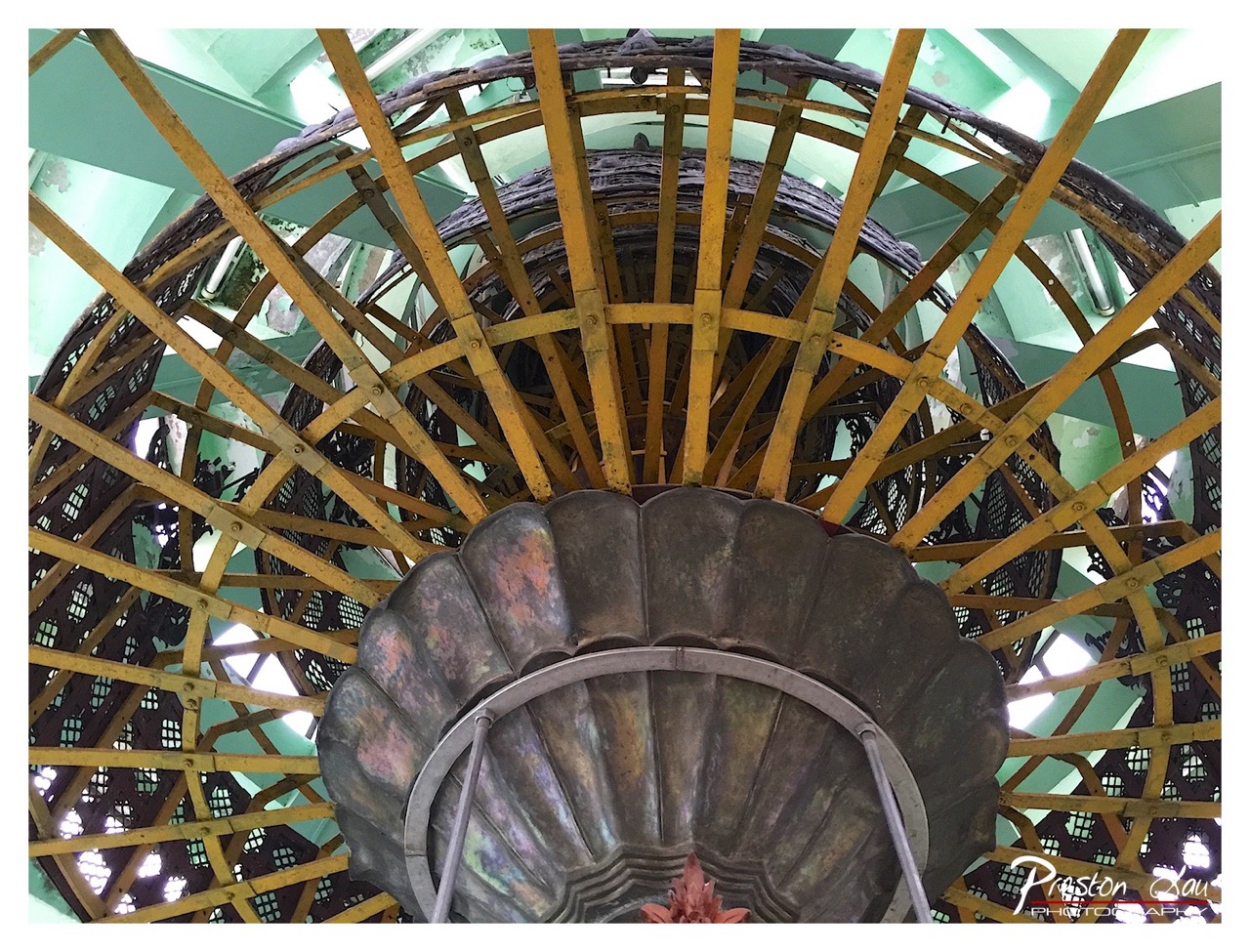

1. Overall Rating (0–10) — 7.0
This photograph captures the intricate geometry and layered textures of a decaying architectural structure, where industrial decay and artistic form converge. The upward-looking perspective emphasizes the complexity of the metal framework and the patina of age, creating a sense of both reverence and melancholy. While the image is rich in detail and visual interest, the slightly overexposed highlights and cluttered background slightly undermine its overall cohesion.
2. Composition (0–10) — 7.5
The radial symmetry of the yellow metal beams draws the eye toward the center, creating a strong focal point. The scalloped metallic element in the foreground adds depth and balance, though the peripheral details of the green structure occasionally distract from the main subject.
3. Lighting (0–10) — 6.5
Natural light filters through gaps in the structure, creating a dynamic interplay of highlights and shadows. The brightness of the sky slightly overexposes the upper portions, losing some detail, but the overall lighting enhances the texture and form of the materials.
4. Color & Tone (0–10) — 7.0
The contrast between the warm yellow of the beams and the cool green of the surrounding structure creates a visually engaging palette. The metallic tones of the central fixture add subtle iridescence, enhancing the image’s visual richness.
5. Creativity (0–10) — 7.5
The choice to frame the shot from below and focus on the structural complexity transforms an ordinary industrial space into a visually compelling study of geometry and decay. The image feels both documentary and poetic.
6. Technical Quality (0–10) — 7.0
The image is sharp and detailed, particularly in the foreground elements. The focus is well-managed, though minor lens flare and overexposure in the upper regions reduce overall technical polish.
7. Emotional Impact (0–10) — 6.5
The photograph evokes a quiet contemplation of time and entropy, inviting the viewer to reflect on the beauty in abandonment. The sense of decay is tinged with nostalgia, though the lack of human presence keeps the emotional connection at a slight remove.
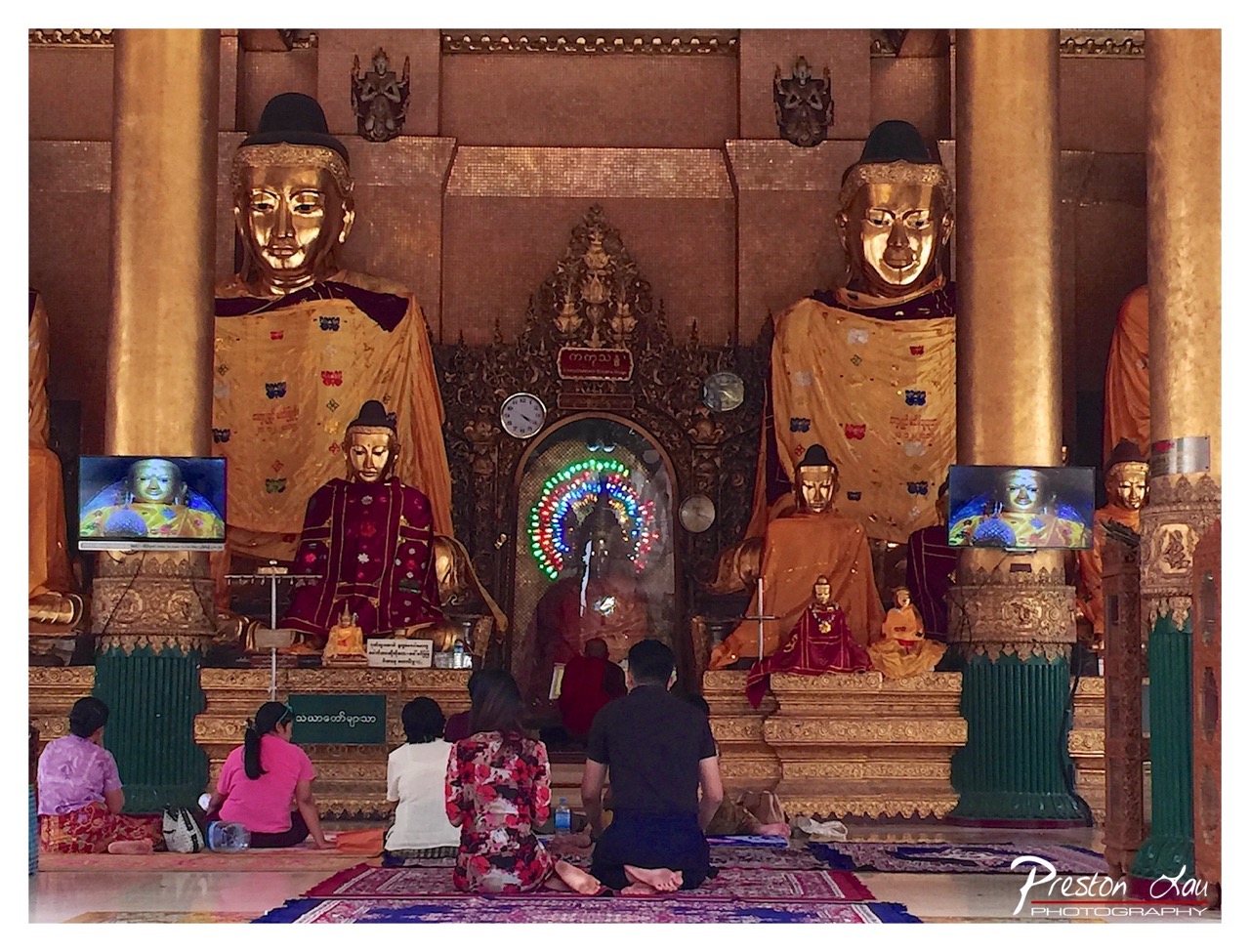

1. Overall Rating (0–10) — 7.0
This image captures a deeply spiritual moment within a sacred Buddhist space, where tradition and modernity intersect in striking harmony. The juxtaposition of ancient golden statues with small digital screens displaying Buddha images creates a compelling narrative of continuity and adaptation. While the composition is rich with cultural detail, the presence of modern technology slightly disrupts the timeless atmosphere, creating a tension between reverence and intrusion. The warmth of the gold and the quiet devotion of the worshippers lend the scene emotional weight, though the visual clutter risks overwhelming the viewer.
2. Composition (0–10) — 6.5
The symmetrical arrangement of the two large Buddha statues provides a strong visual anchor, but the inclusion of multiple screens and figures creates a busy foreground. The seated worshippers add depth and scale, though their placement slightly disrupts the balance, drawing attention away from the central altar.
3. Lighting (0–10) — 7.0
Warm, ambient light enhances the golden tones of the statues and creates a reverent glow throughout the space. The soft illumination from the central archway adds a subtle focal point, while the screens introduce cooler, artificial light that contrasts with the organic warmth of the temple’s interior.
4. Color & Tone (0–10) — 7.5
The dominant palette of gold, red, and deep green evokes a sense of sacred richness, while the colorful halo of lights in the central shrine adds a dynamic burst of energy. The contrast between the traditional warm tones and the cool blue hues from the screens introduces visual tension that underscores the blend of old and new.
5. Creativity (0–10) — 8.0
The image stands out for its conceptual depth—capturing the intersection of ancient devotion and modern technology in a way that is both visually engaging and thought-provoking. The inclusion of digital screens as part of the religious ritual adds a layer of commentary on contemporary faith practices.
6. Technical Quality (0–10) — 8.0
The photograph is sharp and well-exposed, with clear detail visible in the textures of the statues, fabrics, and architectural elements. The focus is consistent across the frame, and the image maintains clarity despite the complexity of the scene.
7. Emotional Impact (0–10) — 7.5
The image evokes a sense of quiet reverence and cultural continuity, inviting the viewer to reflect on how tradition adapts in the modern world. The presence of worshippers in prayer adds a human element that deepens the emotional resonance, grounding the scene in real devotion.
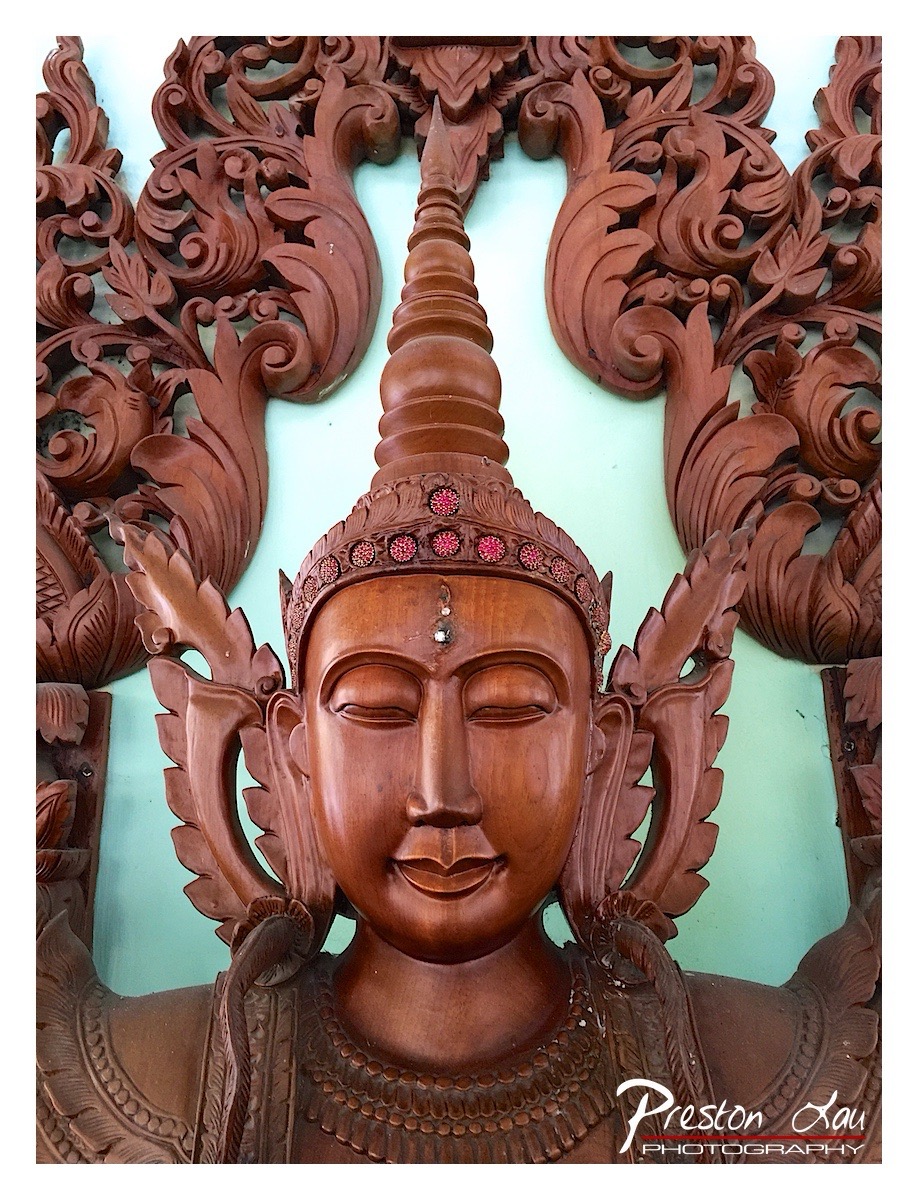

1. Overall Rating (0–10) — 8.0
This photograph captures the serene elegance of a deeply carved wooden deity, where intricate craftsmanship meets spiritual tranquility. The warm, rich tones of the wood contrast beautifully with the soft mint background, drawing focus to the subject’s meditative expression. While the image is technically strong and rich in detail, its emotional resonance could be deepened by a more dynamic lighting approach to enhance the sculpture’s three-dimensionality.
2. Composition (0–10) — 8.0
The subject is centered and framed symmetrically, emphasizing the balance and harmony of the carving. The ornate details of the crown and wings extend into the upper corners, creating a natural border that draws the eye inward toward the face.
3. Lighting (0–10) — 7.0
The lighting is even and soft, highlighting the texture and depth of the wood without harsh shadows. A subtle directional light from the front adds dimension, though a more directional or ambient glow could enhance the spiritual mood.
4. Color & Tone (0–10) — 8.0
The warm, rich brown of the wood contrasts beautifully with the cool mint background, creating a visually striking palette. The small red accents in the headdress add a touch of vibrancy without disrupting the overall harmony.
5. Creativity (0–10) — 8.0
The choice to focus on the intricate details of the carving, combined with the clean background, transforms a simple cultural artifact into a contemplative portrait. The image conveys both reverence and artistic appreciation.
6. Technical Quality (0–10) — 8.5
The photograph is sharp and well-focused, with excellent clarity in the fine carvings. The depth of field is appropriately managed, keeping the entire subject in crisp detail.
7. Emotional Impact (0–10) — 8.0
The calm expression of the deity and the intricate craftsmanship evoke a sense of peace and devotion. The viewer is invited to pause and reflect, creating a quiet, meditative experience.
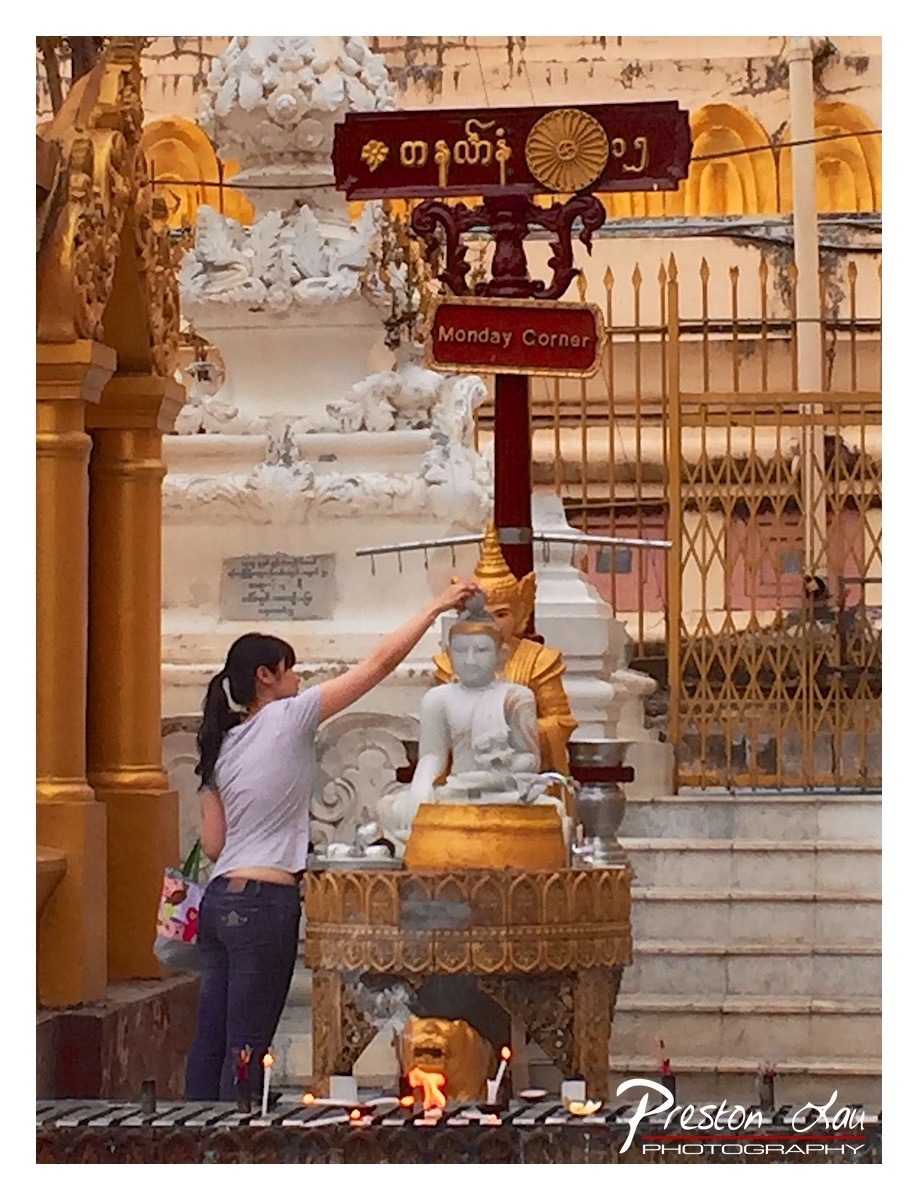

1. Overall Rating (0–10) — 7.0
This photograph captures a moment of quiet devotion at a Buddhist shrine, where the juxtaposition of modern attire and sacred ritual creates a compelling narrative. The warm, golden light enhances the spiritual atmosphere, while the layered composition—blending the woman’s gesture, the Buddha statue, and the ornate architecture—invites contemplation. The image’s strength lies in its storytelling, though the slightly cluttered background and muted color saturation keep it from achieving greater visual elegance.
2. Composition (0–10) — 6.5
The subject is well-placed, drawing the eye to the act of offering, but the surrounding elements—such as the fence and signage—create visual noise. A tighter crop or slight shift in perspective could enhance focus on the interaction between the woman and the statue.
3. Lighting (0–10) — 7.0
The warm, golden-hour light casts a soft glow across the scene, enhancing the spiritual ambiance and creating depth through subtle shadows. While the light is natural and fitting, it lacks the dramatic contrast that might elevate the mood further.
4. Color & Tone (0–10) — 6.5
The dominant golds and whites create a cohesive palette, but the overall tone is slightly flat and oversaturated, especially in the highlights. A more balanced color grade would preserve the warmth while allowing richer depth in the shadows.
5. Creativity (0–10) — 7.5
The image stands out for its cultural authenticity and narrative intent, capturing a candid moment of reverence. The blend of tradition and modernity—evident in the woman’s casual clothing and the shrine’s ornate details—adds a layer of contemporary relevance.
6. Technical Quality (0–10) — 7.5
The image is sharp and well-focused, with clean detail in the textures of the stone and metalwork. The exposure is mostly balanced, though some highlights are slightly blown out.
7. Emotional Impact (0–10) — 7.0
There’s a quiet intimacy in the woman’s gesture, evoking a sense of personal faith and cultural connection. The viewer is drawn into the moment, not just as an observer, but as a witness to a deeply human act of devotion.
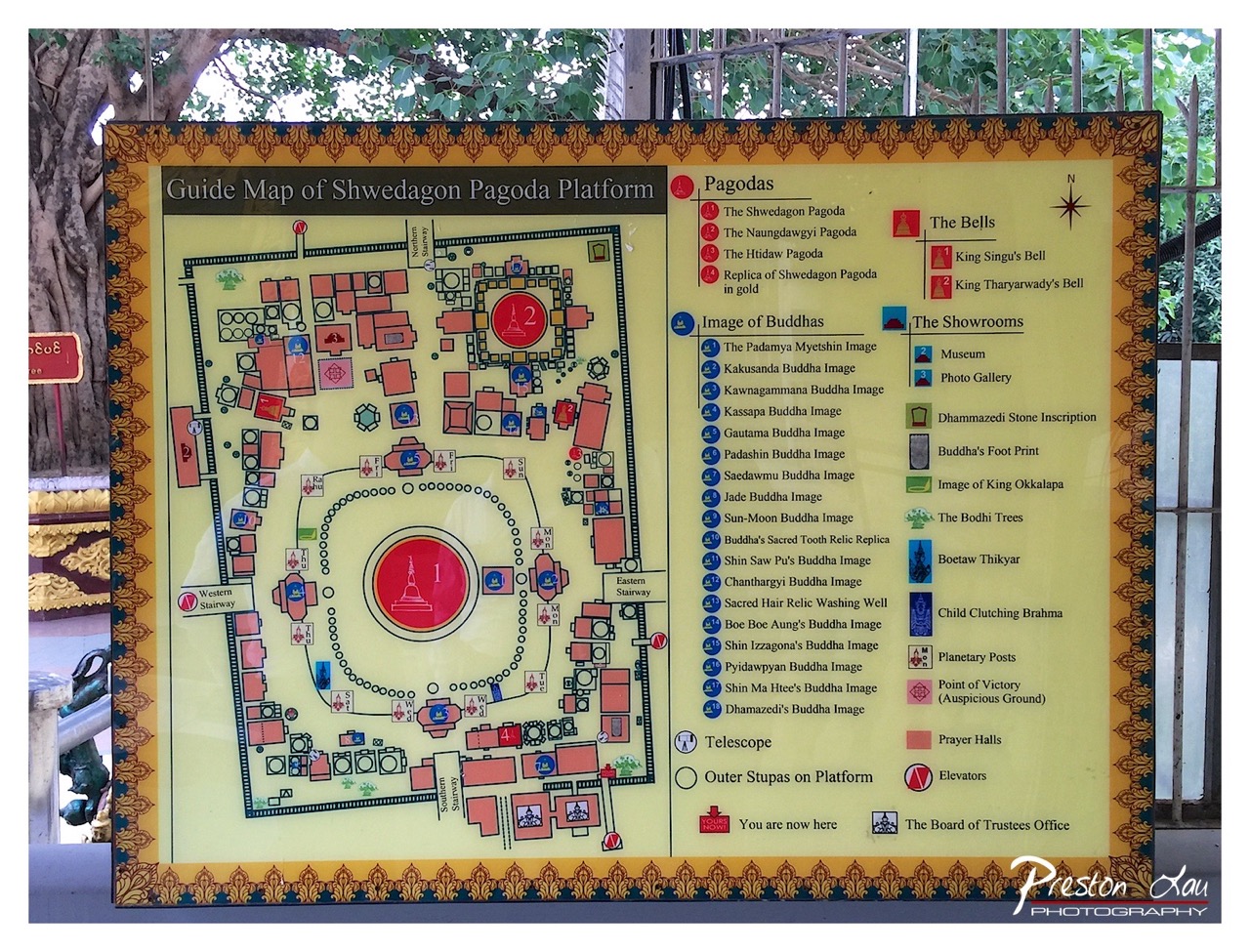

1. Overall Rating (0–10) — 6.0
This photograph captures a detailed guide map of the Shwedagon Pagoda Platform, presenting a wealth of information in a structured and functional layout. The composition is straightforward and informative, prioritizing clarity over aesthetic appeal. While the map is rich in content and purpose, the flat, documentary style and lack of visual drama limit its artistic impact, making it more of a practical reference than a compelling image.
2. Composition (0–10) — 7.0
The map is centrally framed and fills the image well, with the ornate border adding visual interest. The surrounding foliage and railing provide context without distracting from the subject, though the slight tilt and uneven framing slightly undermine the overall balance.
3. Lighting (0–10) — 6.0
Natural daylight illuminates the map evenly, with no harsh shadows or overexposed areas. The lighting is functional and clear, supporting legibility but lacking the warmth or directional quality that might enhance mood.
4. Color & Tone (0–10) — 5.5
The palette is dominated by muted yellows and earthy tones, with reds and blues used for emphasis. While the colors are consistent and readable, they lack vibrancy and contrast, contributing to a somewhat flat and institutional appearance.
5. Creativity (0–10) — 5.0
The image is practical and utilitarian, with little artistic interpretation. Its strength lies in documentation rather than originality, as it serves as a straightforward record of a public sign rather than a creative or expressive statement.
6. Technical Quality (0–10) — 7.5
The image is sharp and in focus, with clear text and legible details. The exposure is well-balanced, and the resolution is sufficient for reading the map’s information. Minor imperfections in framing and alignment keep it from technical perfection.
7. Emotional Impact (0–10) — 4.5
The photograph evokes a sense of place and cultural context, but it remains emotionally distant. The viewer is invited to learn, not to feel—its impact is intellectual rather than visceral or personal.
Loading map...